This document provides an introduction to the Semantic Web and RDF (Resource Description Framework). It discusses how the Semantic Web aims to extend the current web by giving data well-defined meaning to enable computers and people to better work together. It introduces RDF as a standard for representing information in the Semantic Web and provides examples of how RDF can be used to represent different types of data, such as relational data and evolving data scenarios.
![Introduction to Semantic Web for GIS Practitioners 3.5.2011, Como Emanuele Della Valle [email_address] http://emanueledellavalle.org](https://image.slidesharecdn.com/semanticweb4gis-110504153905-phpapp02/75/Introduction-to-Semantic-Web-for-GIS-Practitioners-1-2048.jpg)
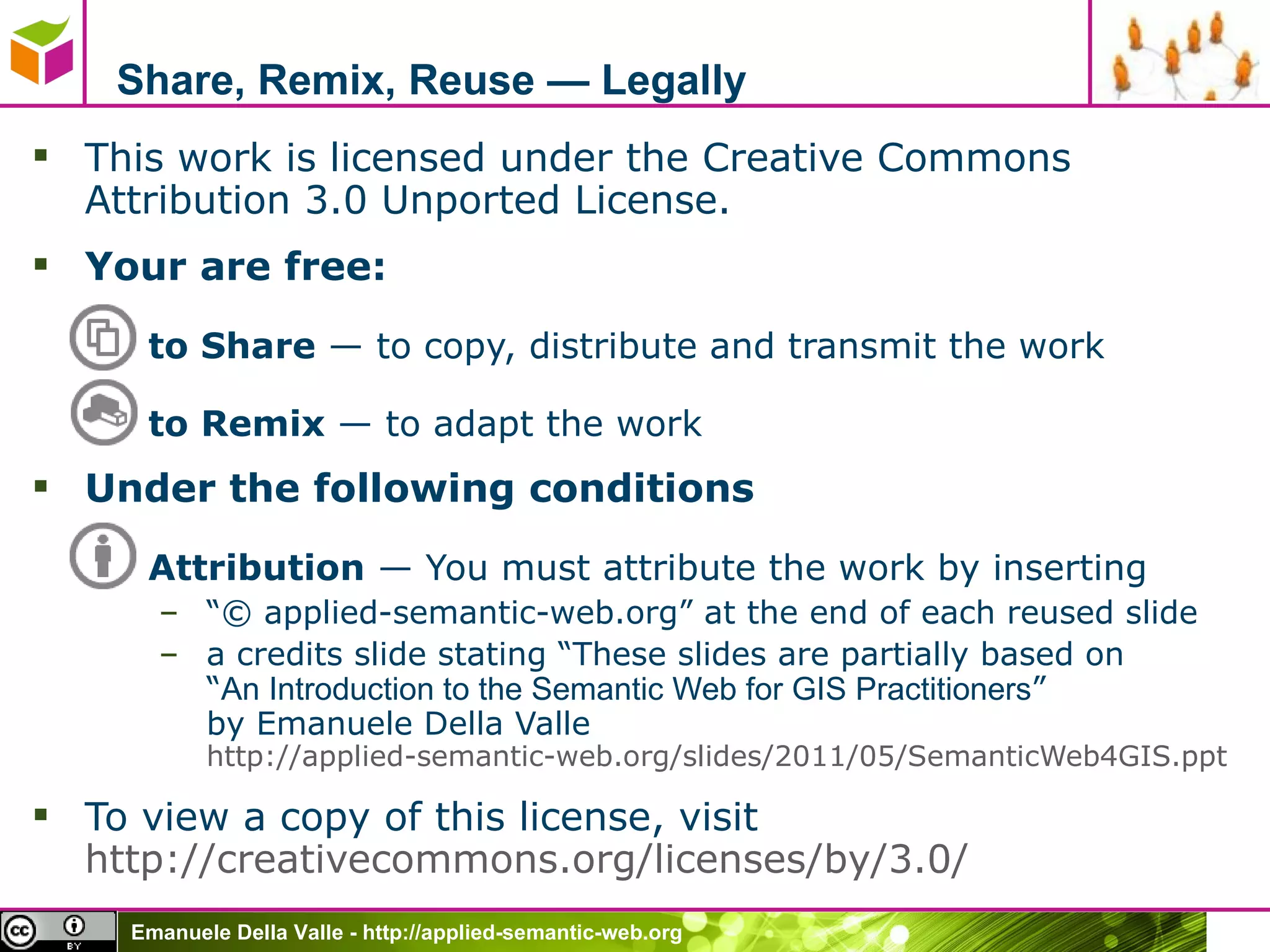
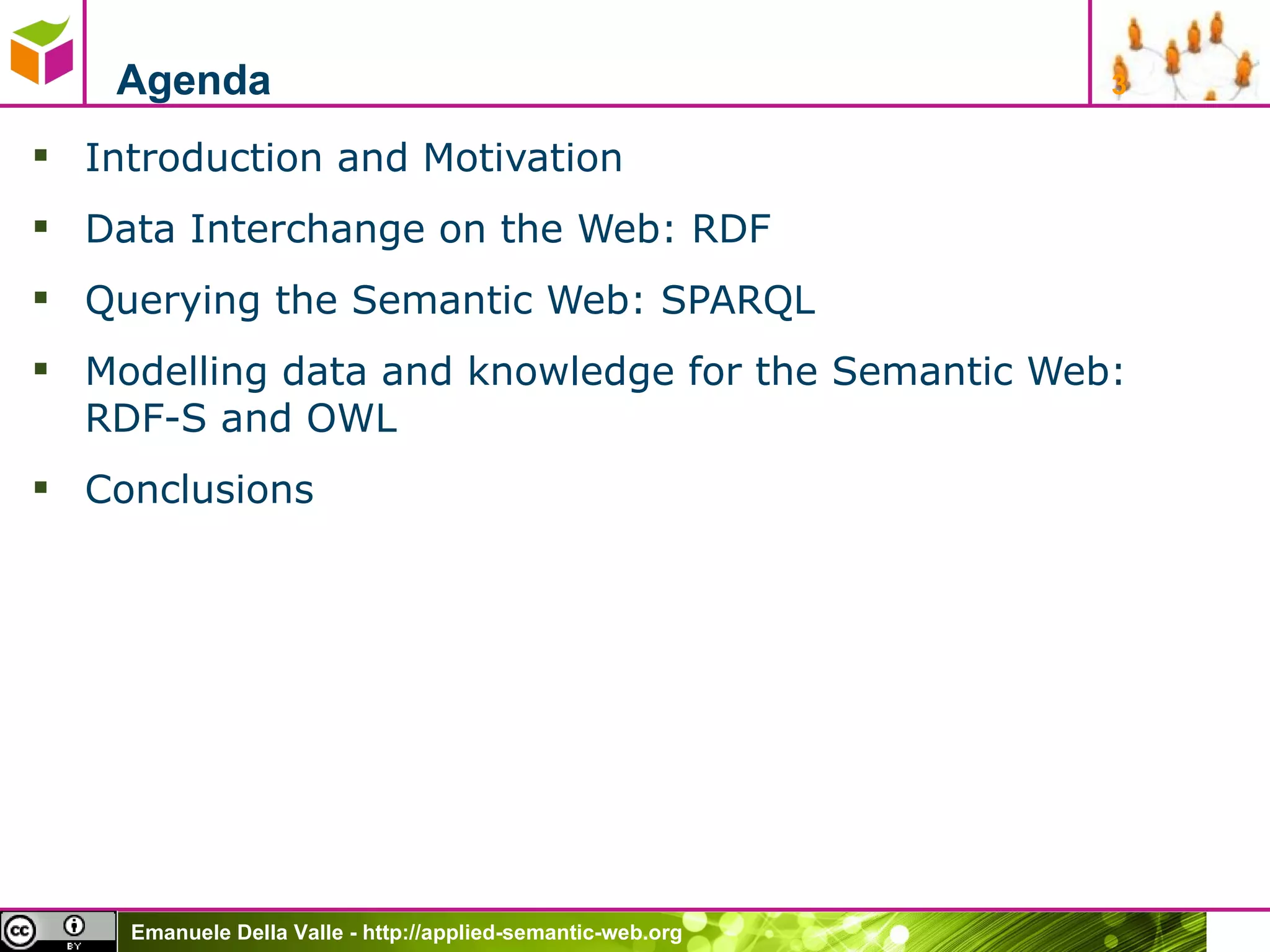
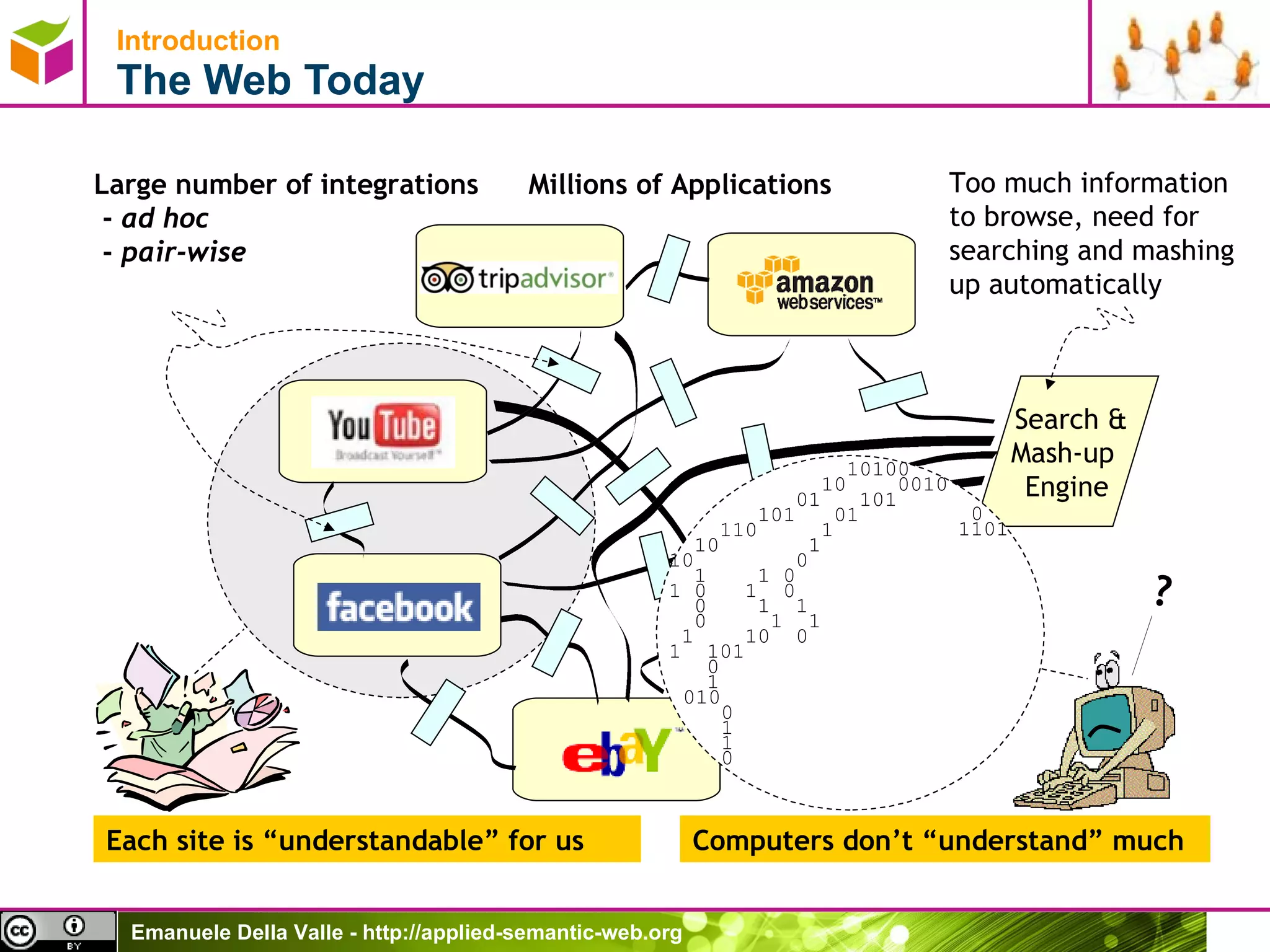
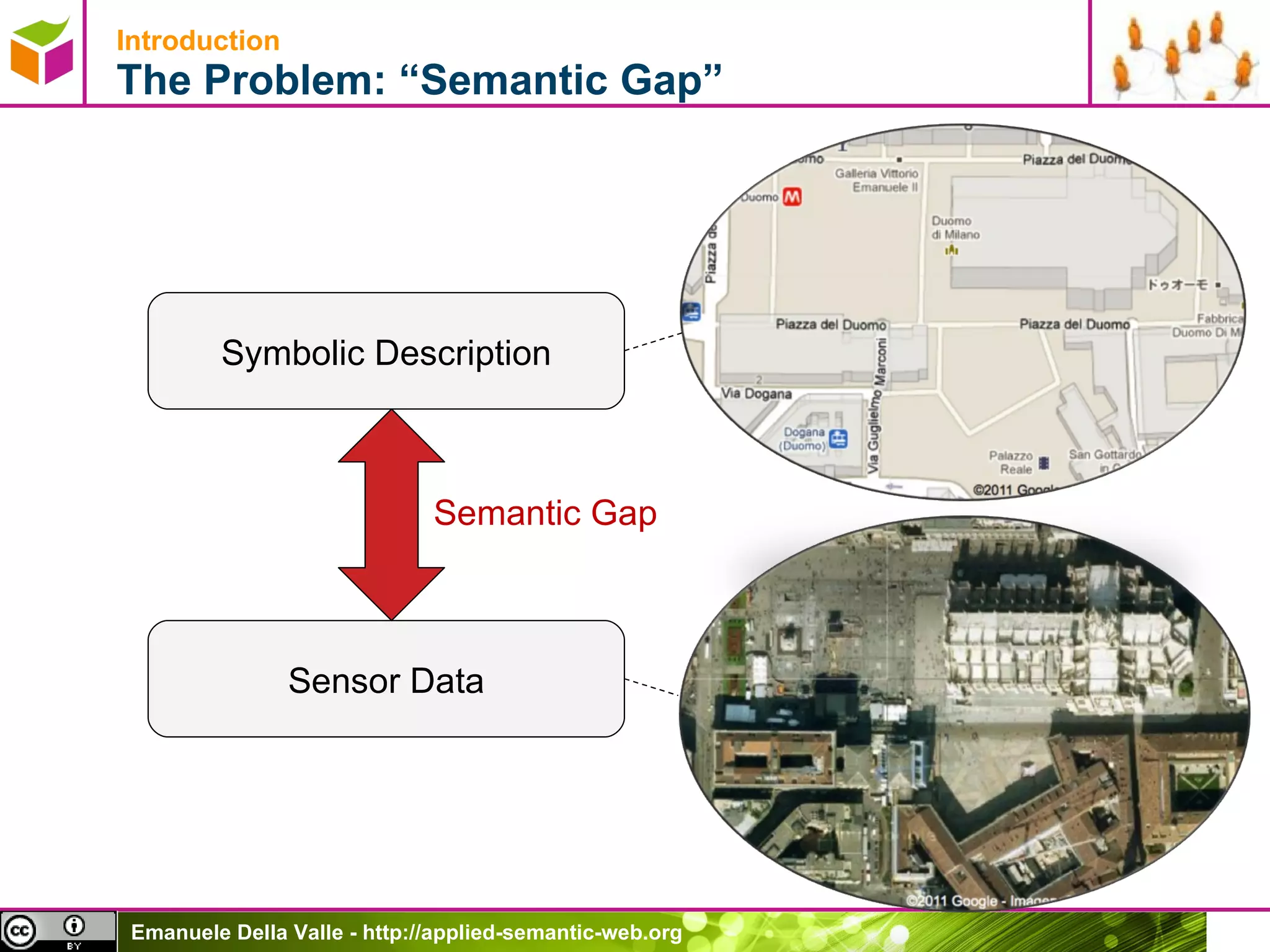
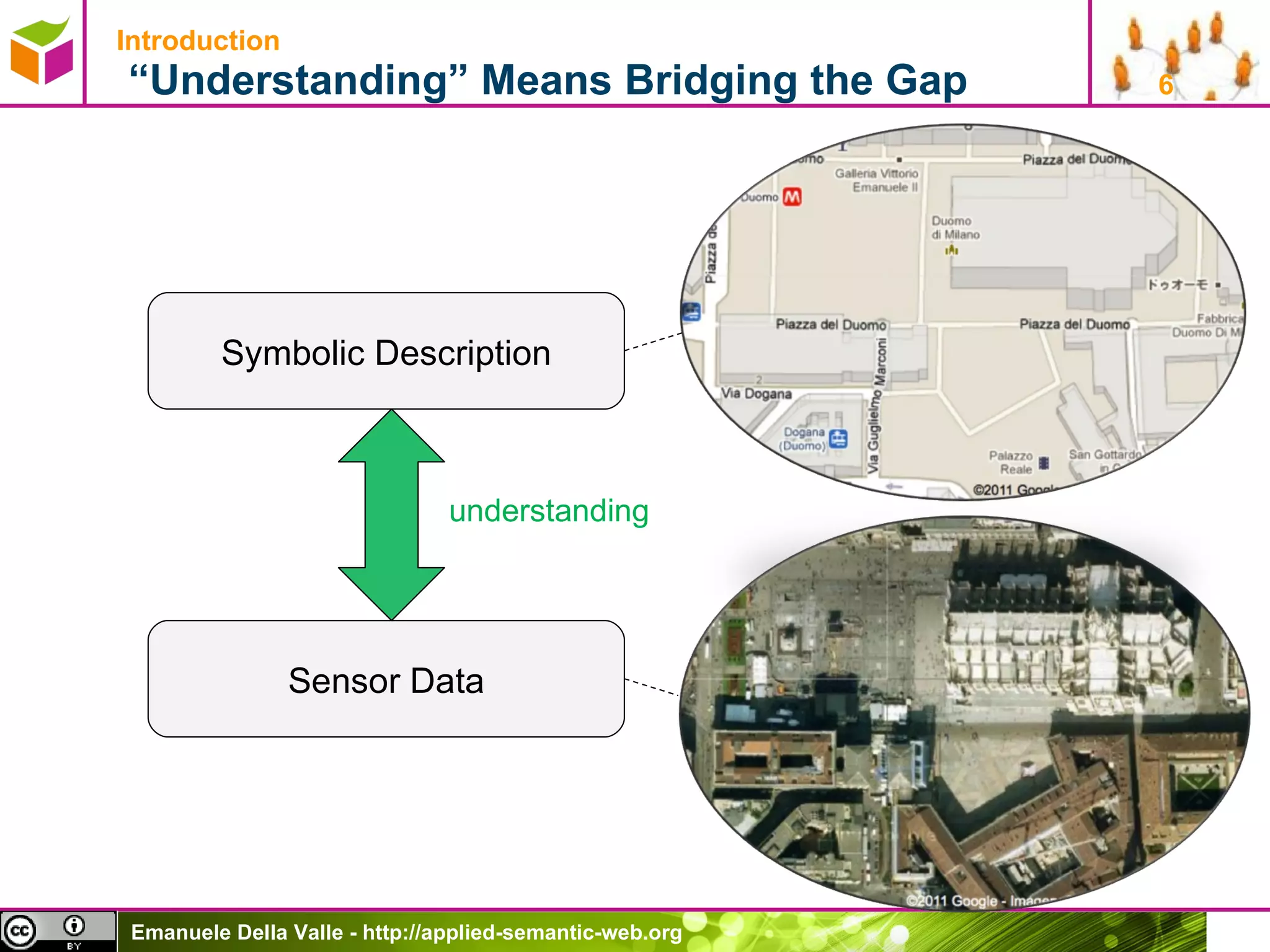
![Introduction Do We Really Know What “Understanding” means? [ source http://www.thefarside.com/ ]](https://image.slidesharecdn.com/semanticweb4gis-110504153905-phpapp02/75/Introduction-to-Semantic-Web-for-GIS-Practitioners-7-2048.jpg)
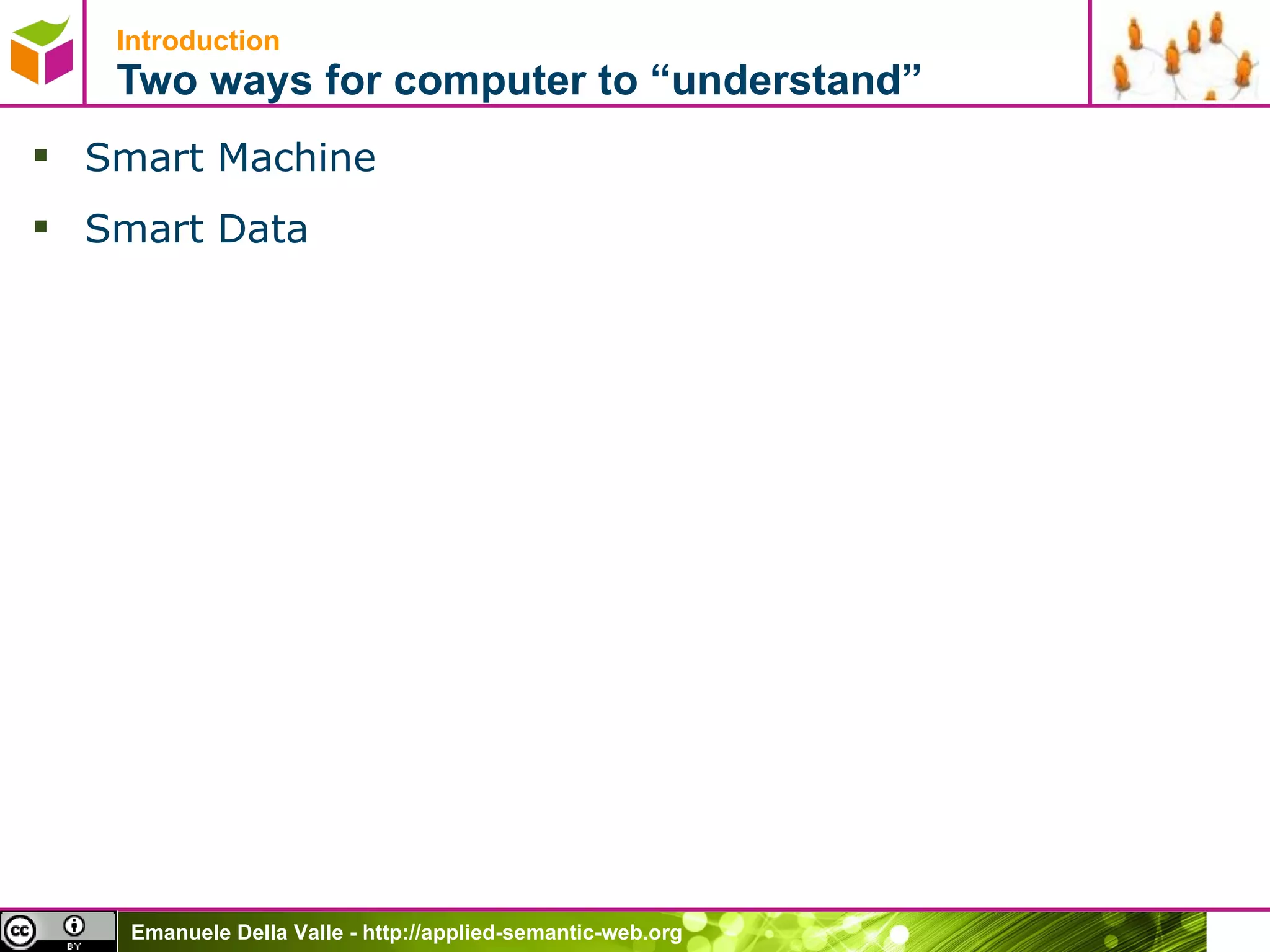
![Introduction Smart Machines Working examples found on the Web Image Processing retrievr: find by sketching http://labs.systemone.at/retrievr/ Audio Processing midomi: find by singing http://www.midomi.com/ […] Natural Language Processing semantic proxy: http://semanticproxy.opencalais.com/about.html Sensor Data Symbolic Description Image Processing Audio Processing Natural Language Processing […]](https://image.slidesharecdn.com/semanticweb4gis-110504153905-phpapp02/75/Introduction-to-Semantic-Web-for-GIS-Practitioners-9-2048.jpg)
![Introduction Smart Machines alone cannot bridge the gap … Natural Language Processing (NLP) meets Image Processing (IP) NLP : What does your eye see? IP : I see a sea NLP : You see a “c”? IP : Yes, what else could it be? [Source NLP Related Entertainment http://www.cl.cam.ac.uk/Research/NL/amusement.html] Sensor Data Symbolic Description Image Processing Natural Language Processing sea “ c” Semantic Gap](https://image.slidesharecdn.com/semanticweb4gis-110504153905-phpapp02/75/Introduction-to-Semantic-Web-for-GIS-Practitioners-10-2048.jpg)
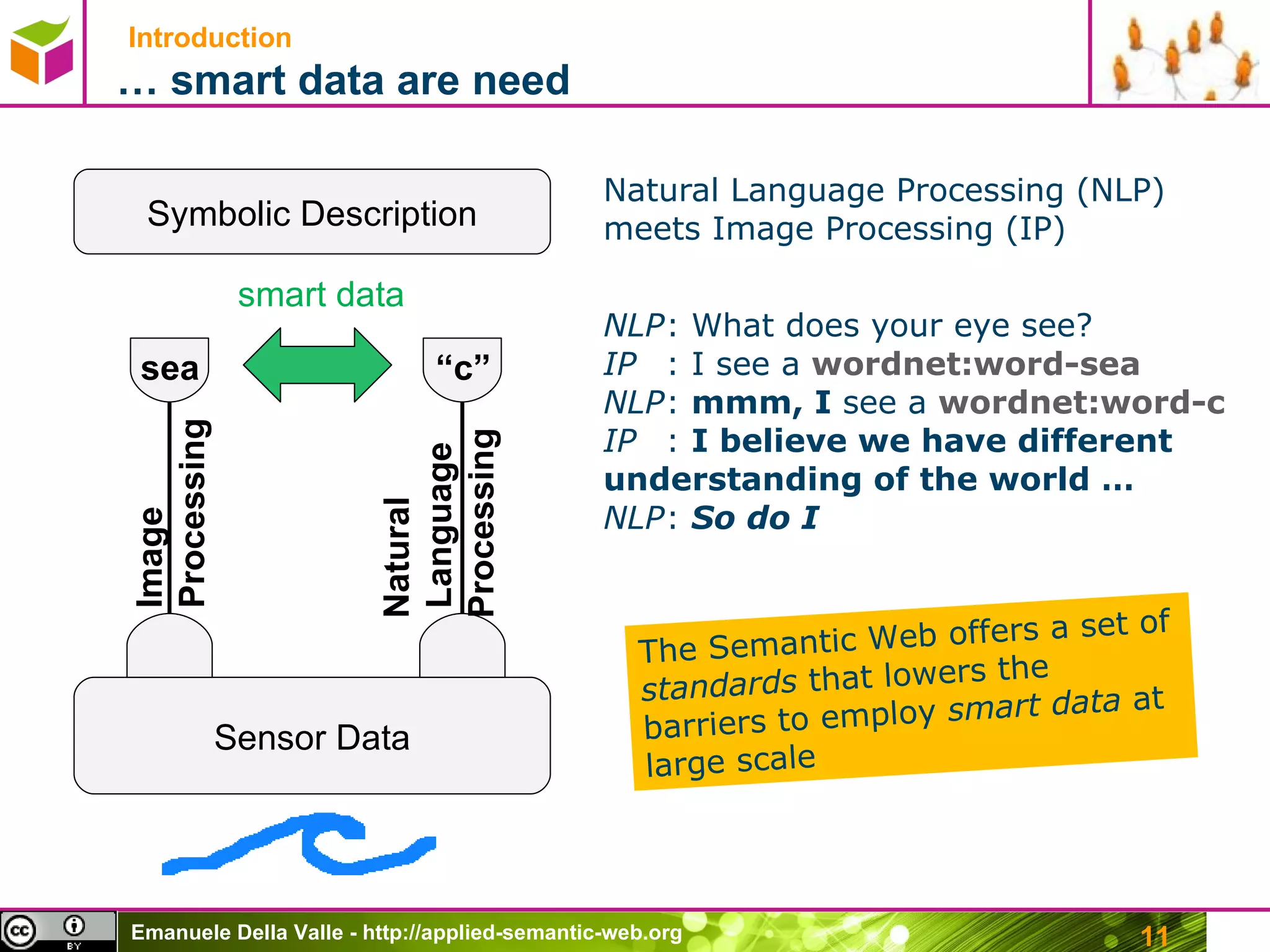
![Introduction What a machine “understands” of the Web What we say to Web agents " For more information visit <a href= “http://www.ex.org”> my company </a> Web site. . .” What they “hear” " blah blah blah blah blah <a href= “http://www.ex.org”> blah blah blah </a> blah blah. . .” Jet this is enought to train them to achive tasks for us [ source http://www.thefarside.com/ ]](https://image.slidesharecdn.com/semanticweb4gis-110504153905-phpapp02/75/Introduction-to-Semantic-Web-for-GIS-Practitioners-12-2048.jpg)
![Introduction What does Google “understand”? Understanding that [page1] links [page2] page2 is interesting Google is able to rank results! “ The heart of our software is PageRank™, a system for ranking web pages […] (that) relies on the uniquely democratic nature of the web by using its vast link structure as an indicator of an individual page's value .” http://www.google.com/technology/](https://image.slidesharecdn.com/semanticweb4gis-110504153905-phpapp02/75/Introduction-to-Semantic-Web-for-GIS-Practitioners-13-2048.jpg)
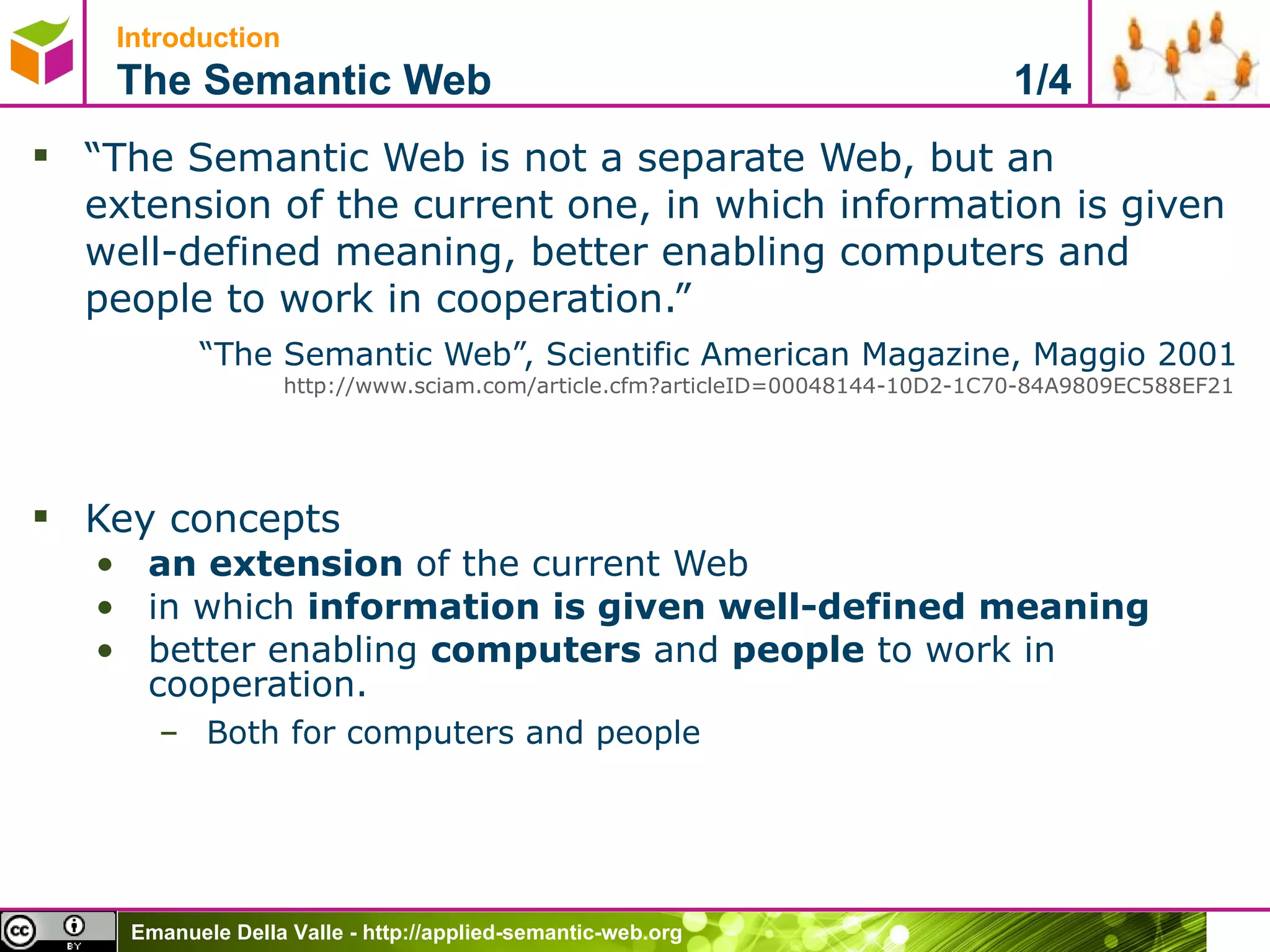
![Introduction The Semantic Web 2/4 “ The Semantic Web is not a separate Web, but an extension of the current one […] ” Web 1.0 The Web Today](https://image.slidesharecdn.com/semanticweb4gis-110504153905-phpapp02/75/Introduction-to-Semantic-Web-for-GIS-Practitioners-15-2048.jpg)
![Introduction The Semantic Web 3/4 “ The Semantic Web […] , in which information is given well-defined meaning […]” Human understandable but “only” machine-readable Human and machine “ understandable ” ? Web 1.0 Semantic Web](https://image.slidesharecdn.com/semanticweb4gis-110504153905-phpapp02/75/Introduction-to-Semantic-Web-for-GIS-Practitioners-16-2048.jpg)
![Introduction The Semantic Web 4/4 Semantic Web Fewer Integration - standard - multi-lateral […] better enabling computers and people to work in cooperation. Even More Applications Easier to understand for people More “understandable” for computers Semantic Mash-ups & Search](https://image.slidesharecdn.com/semanticweb4gis-110504153905-phpapp02/75/Introduction-to-Semantic-Web-for-GIS-Practitioners-17-2048.jpg)
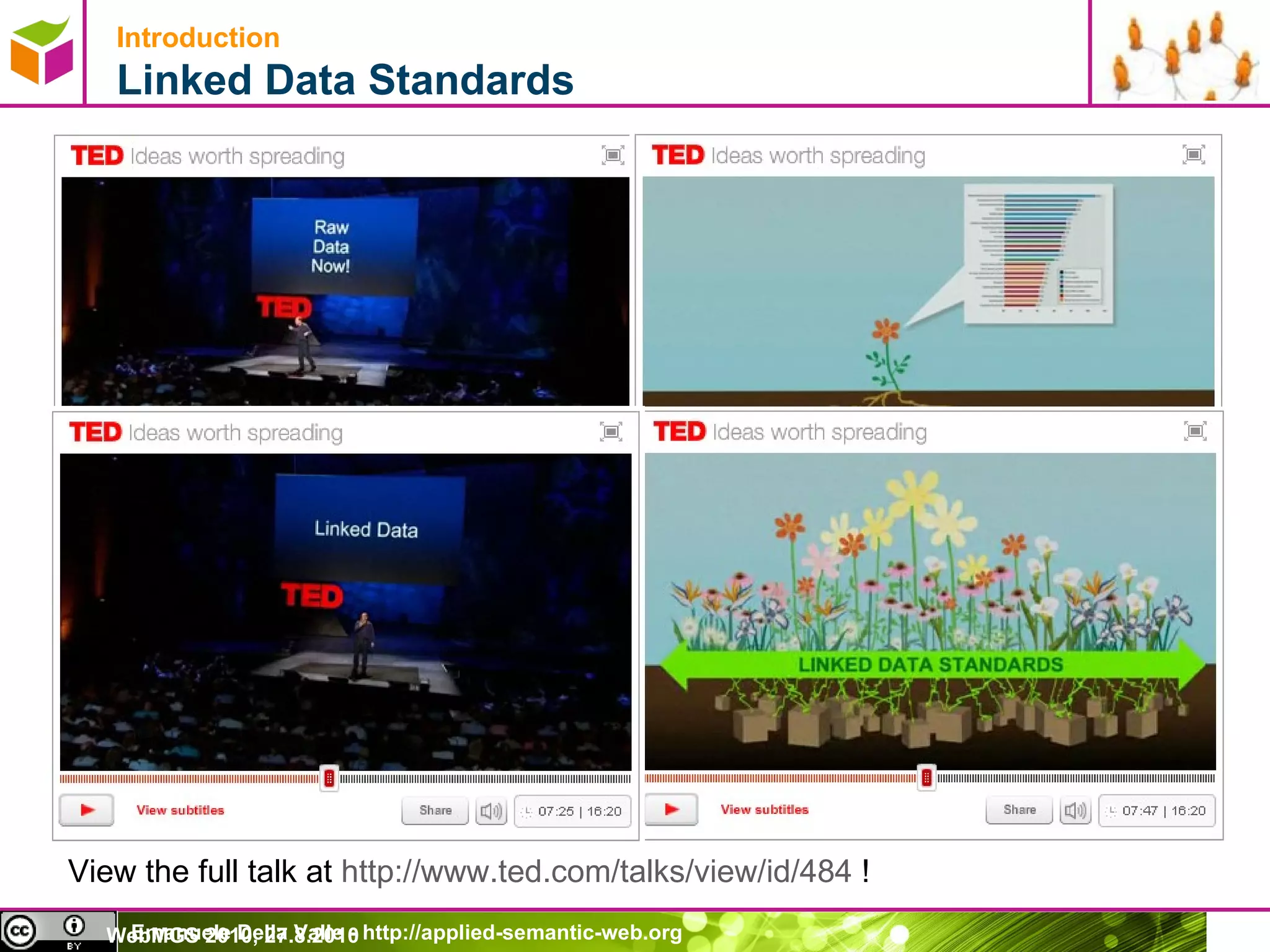
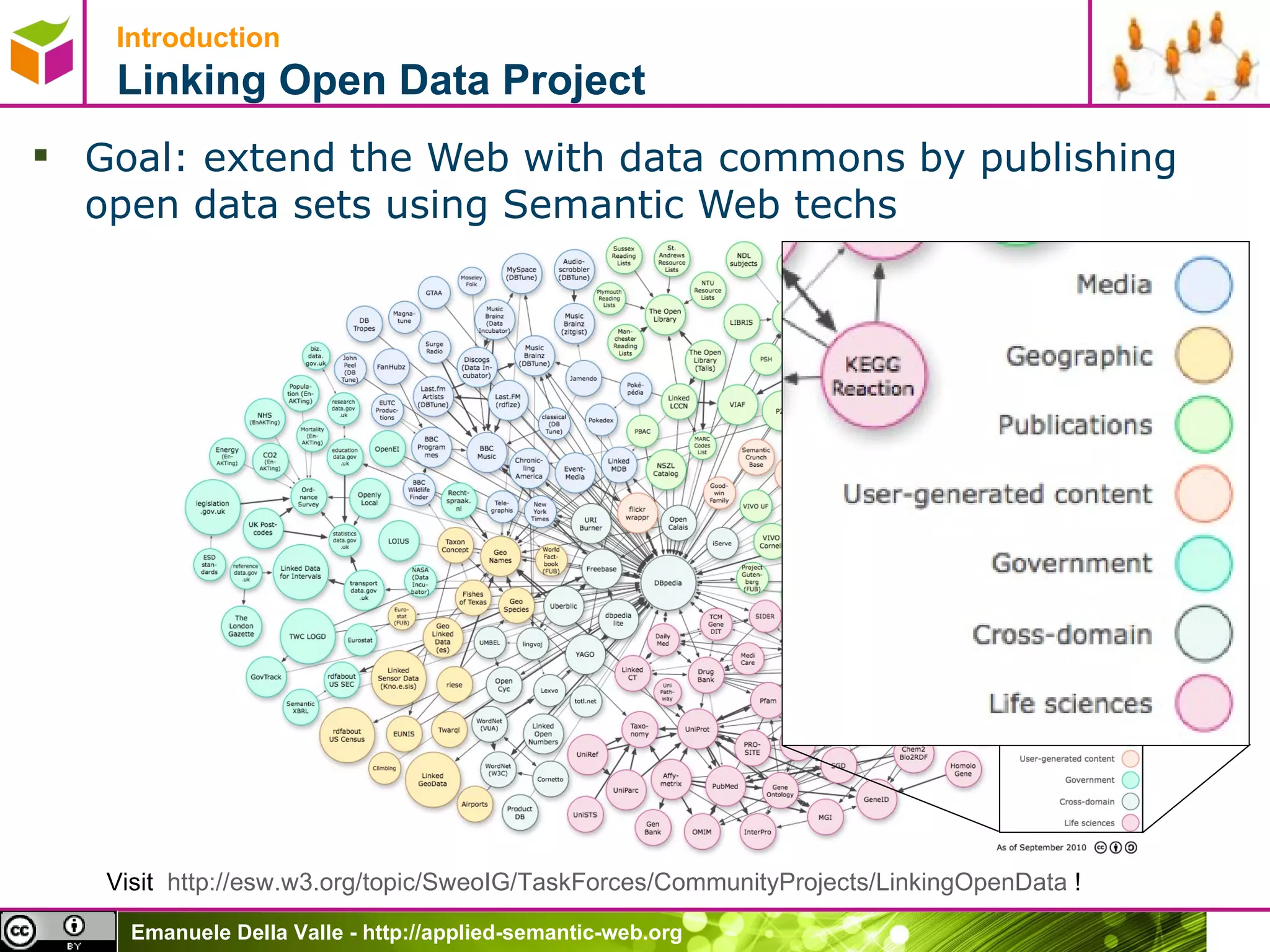
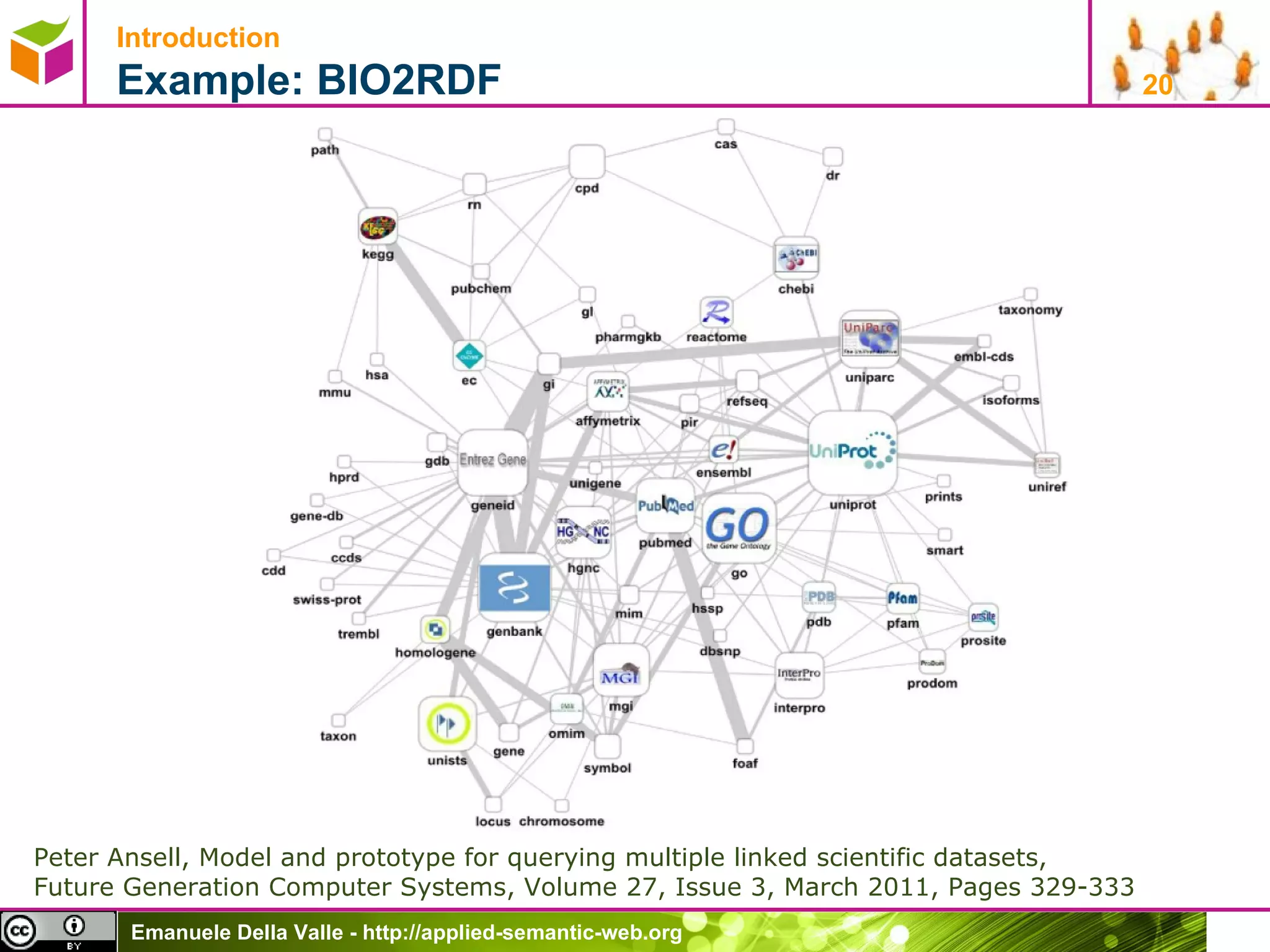

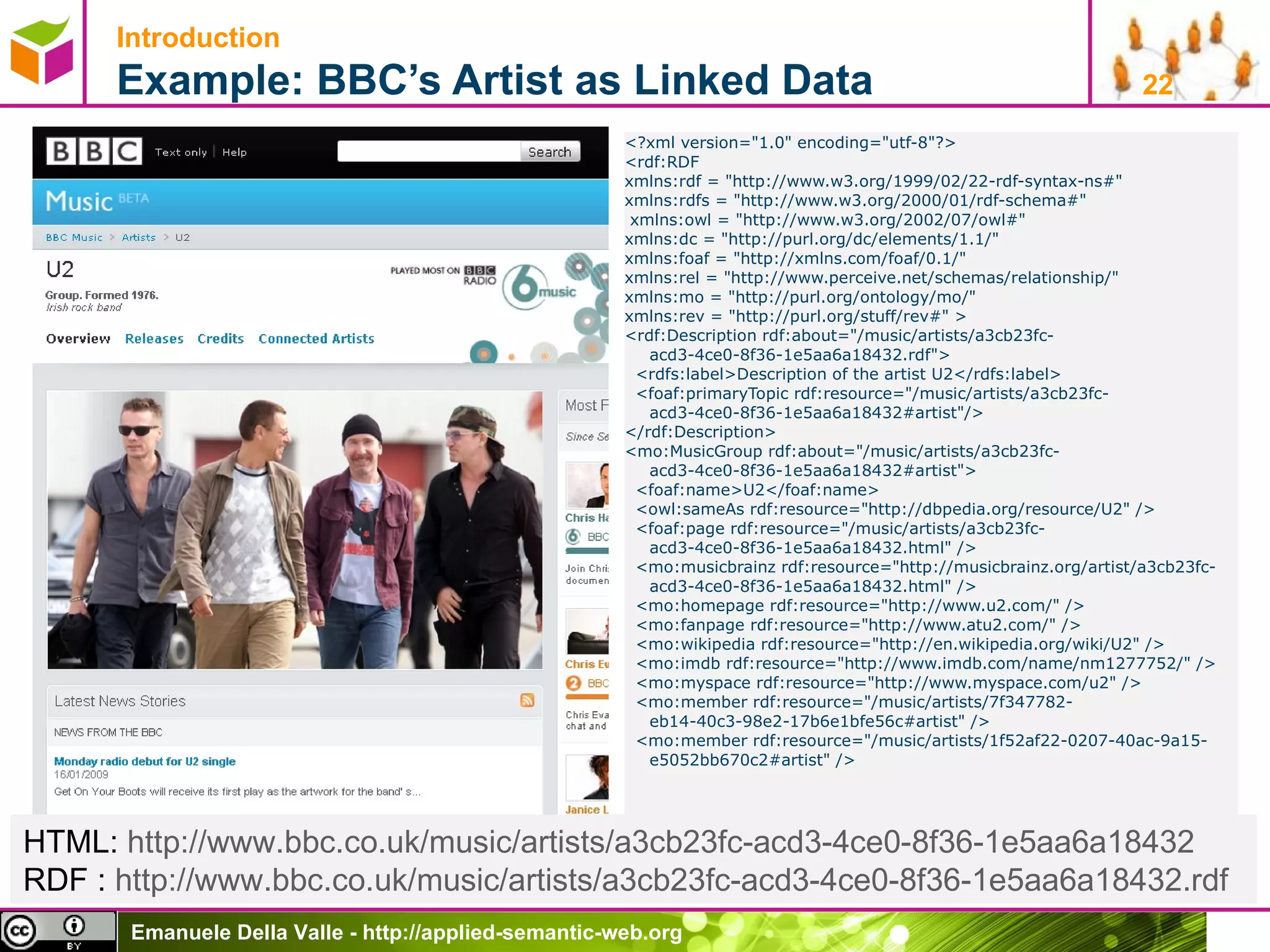
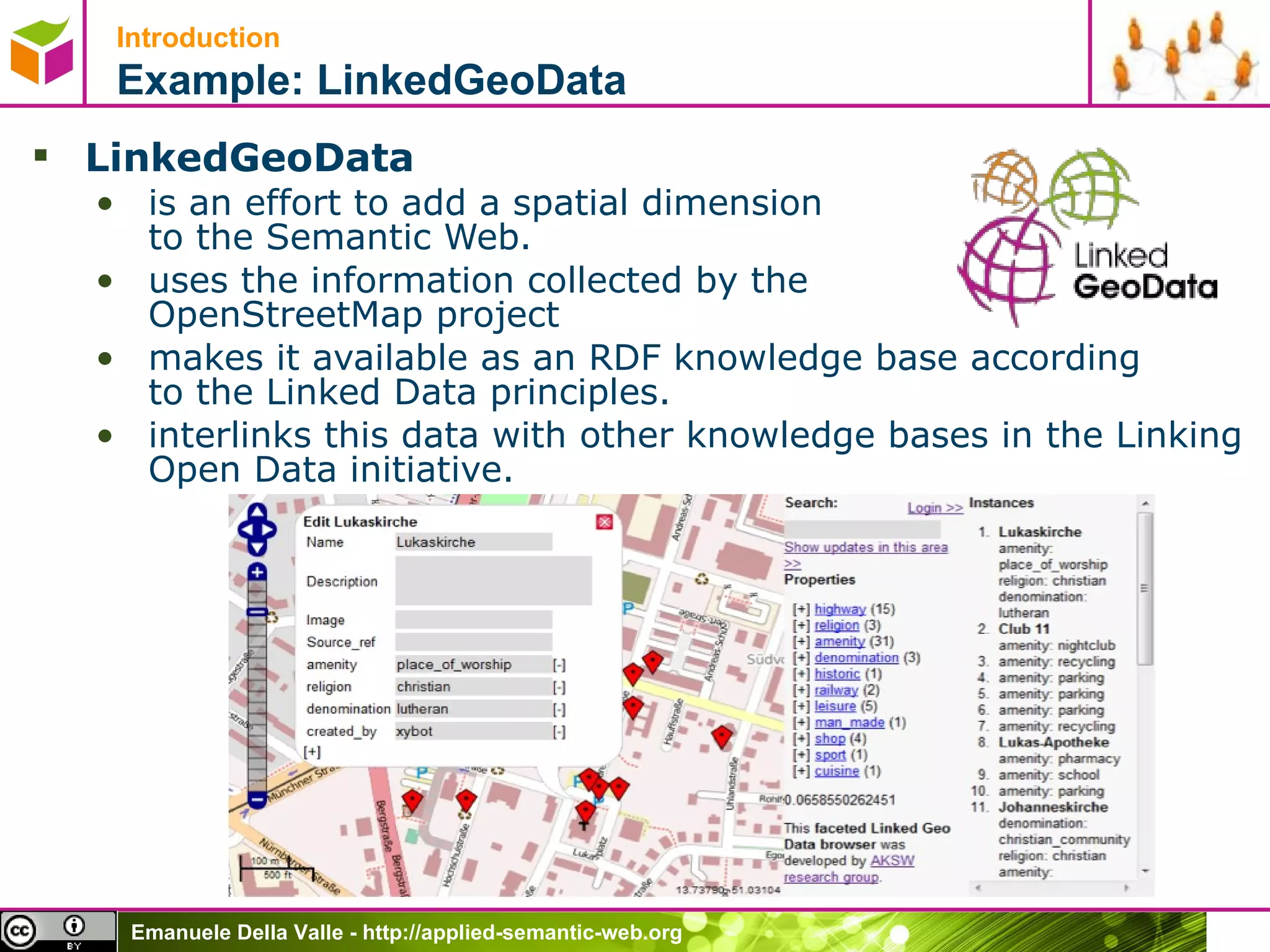
![Introduction Semantic Web “layer cake” Standardized Under Investigation Already Possible [ source http://www.w3.org/2007/03/layerCake.png ]](https://image.slidesharecdn.com/semanticweb4gis-110504153905-phpapp02/75/Introduction-to-Semantic-Web-for-GIS-Practitioners-24-2048.jpg)
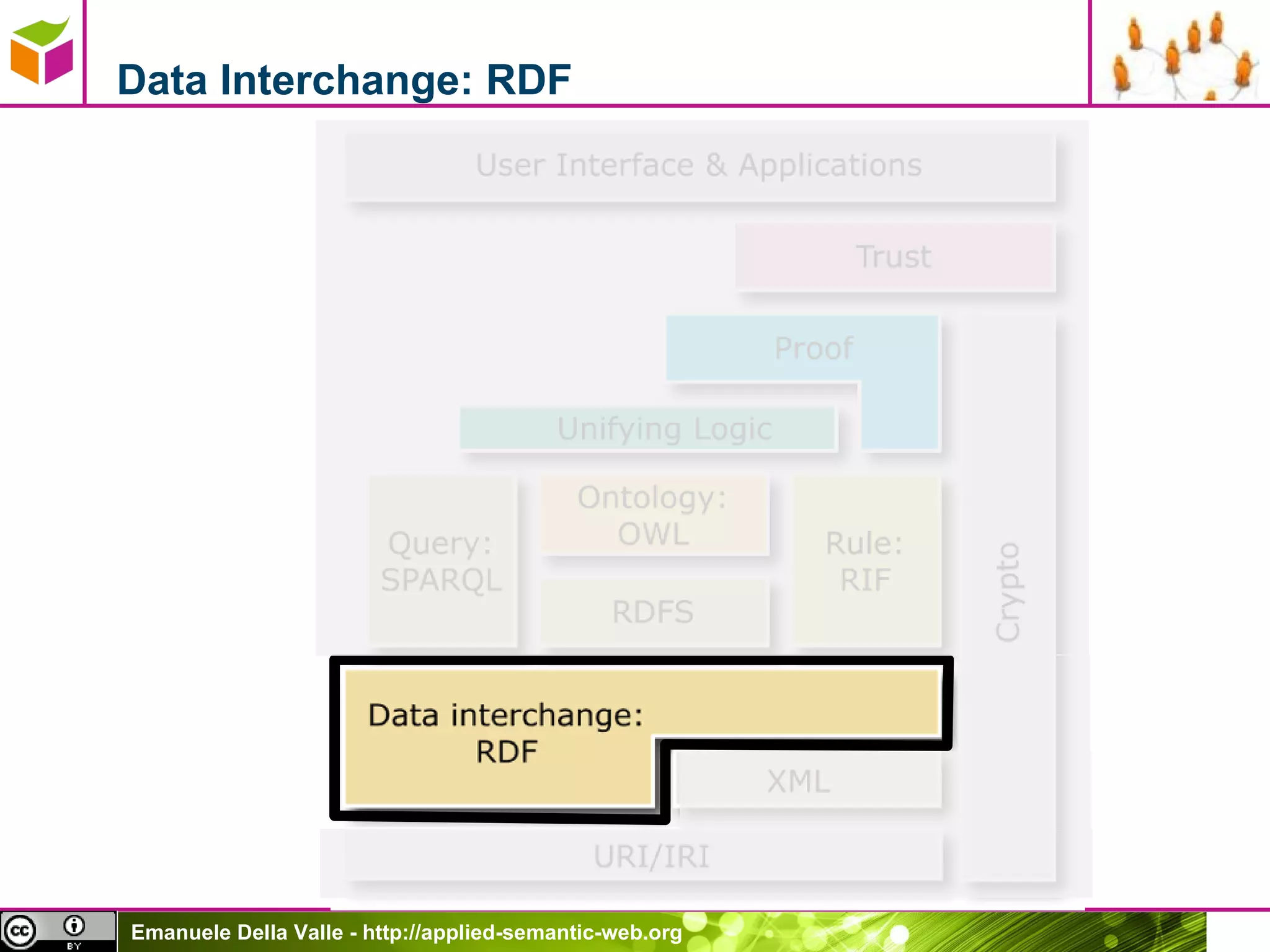
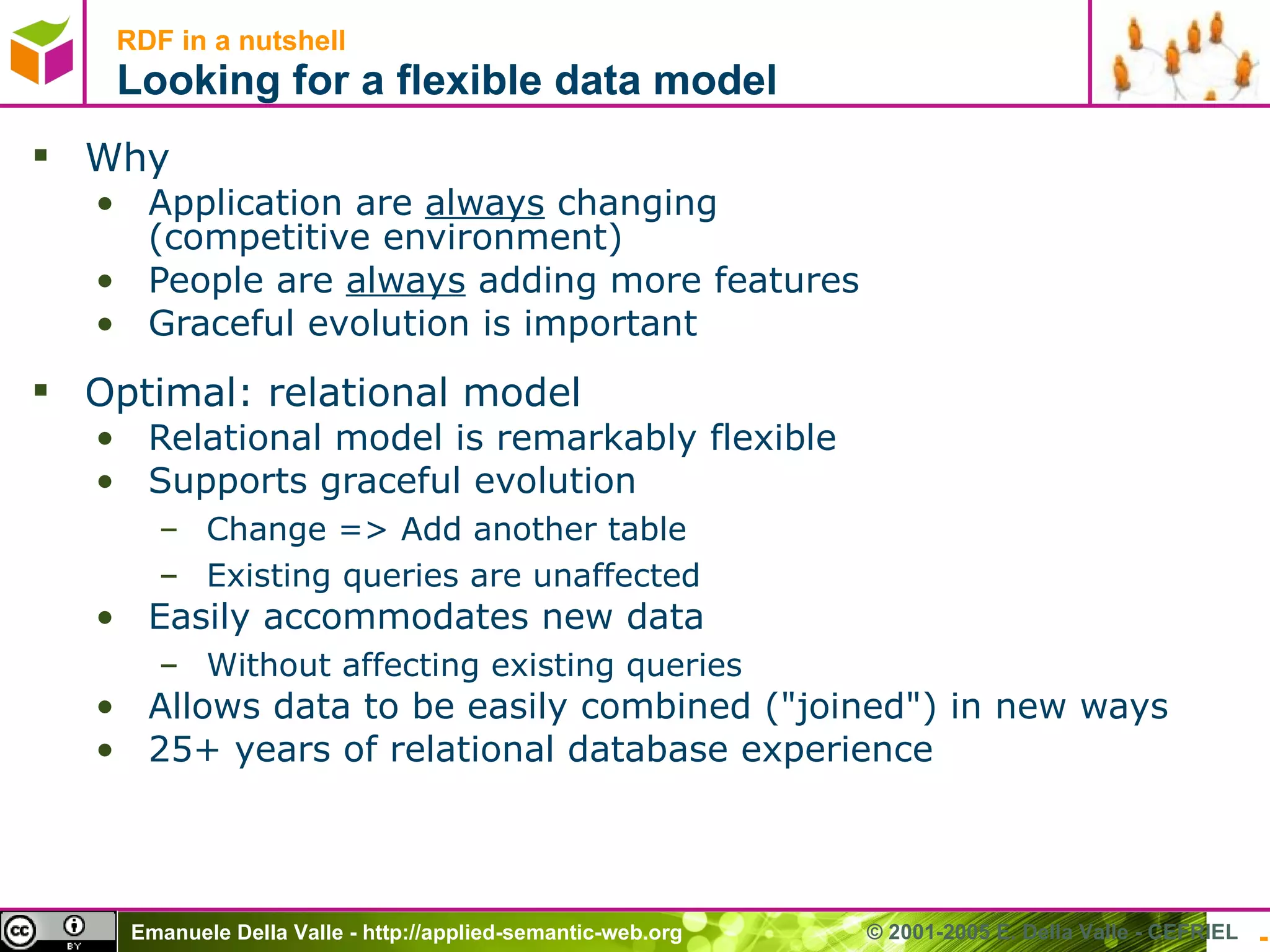
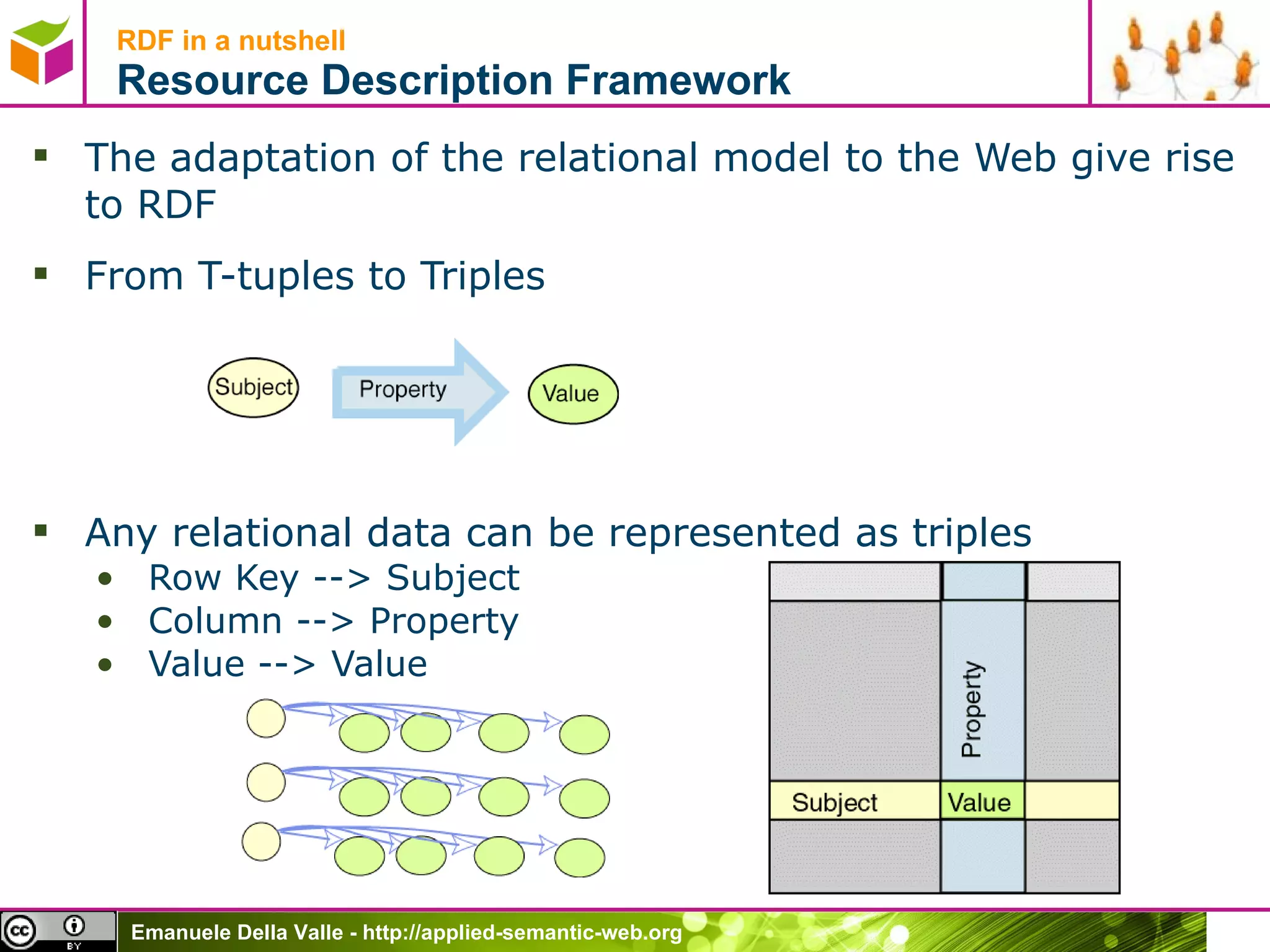
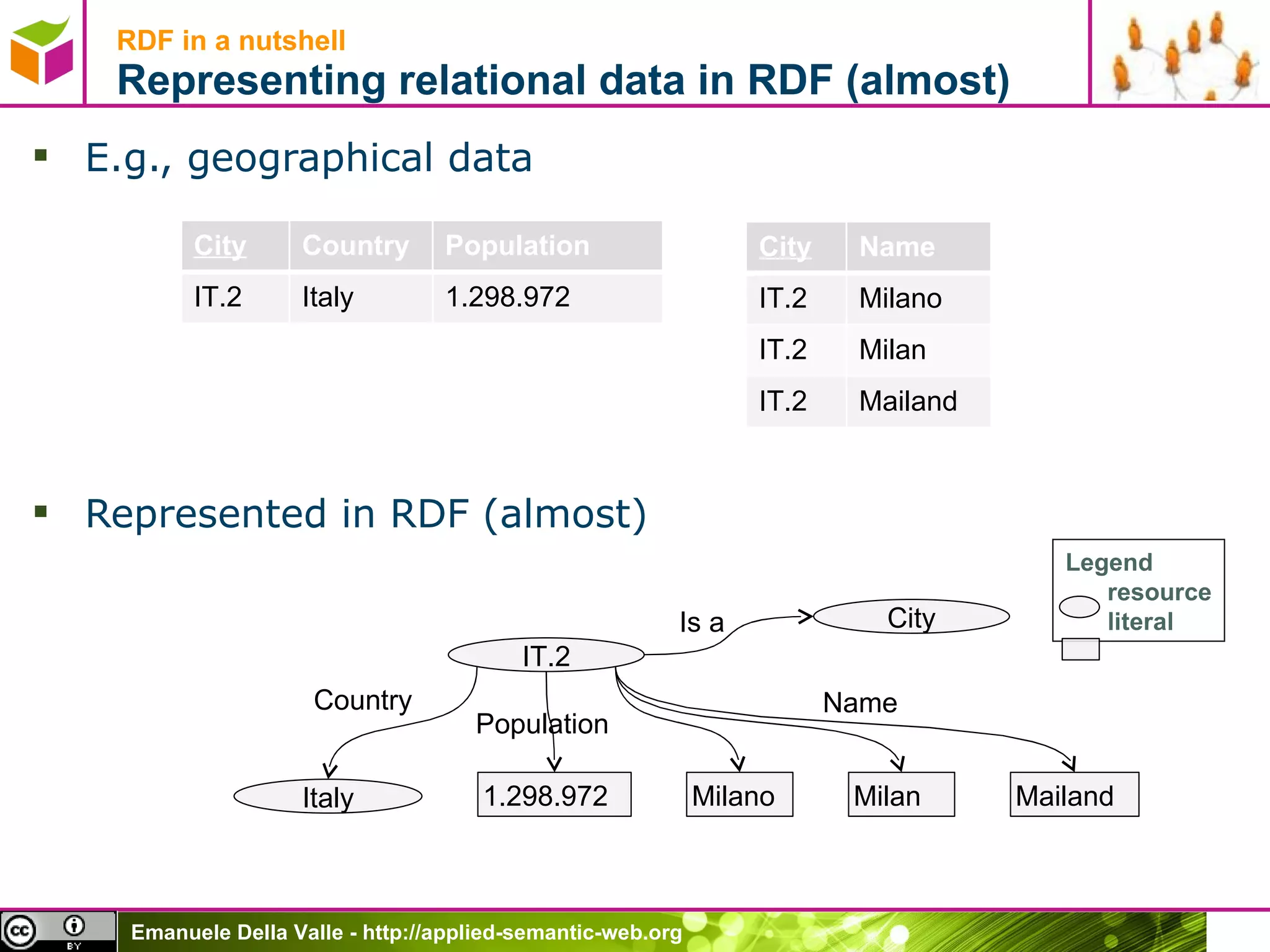
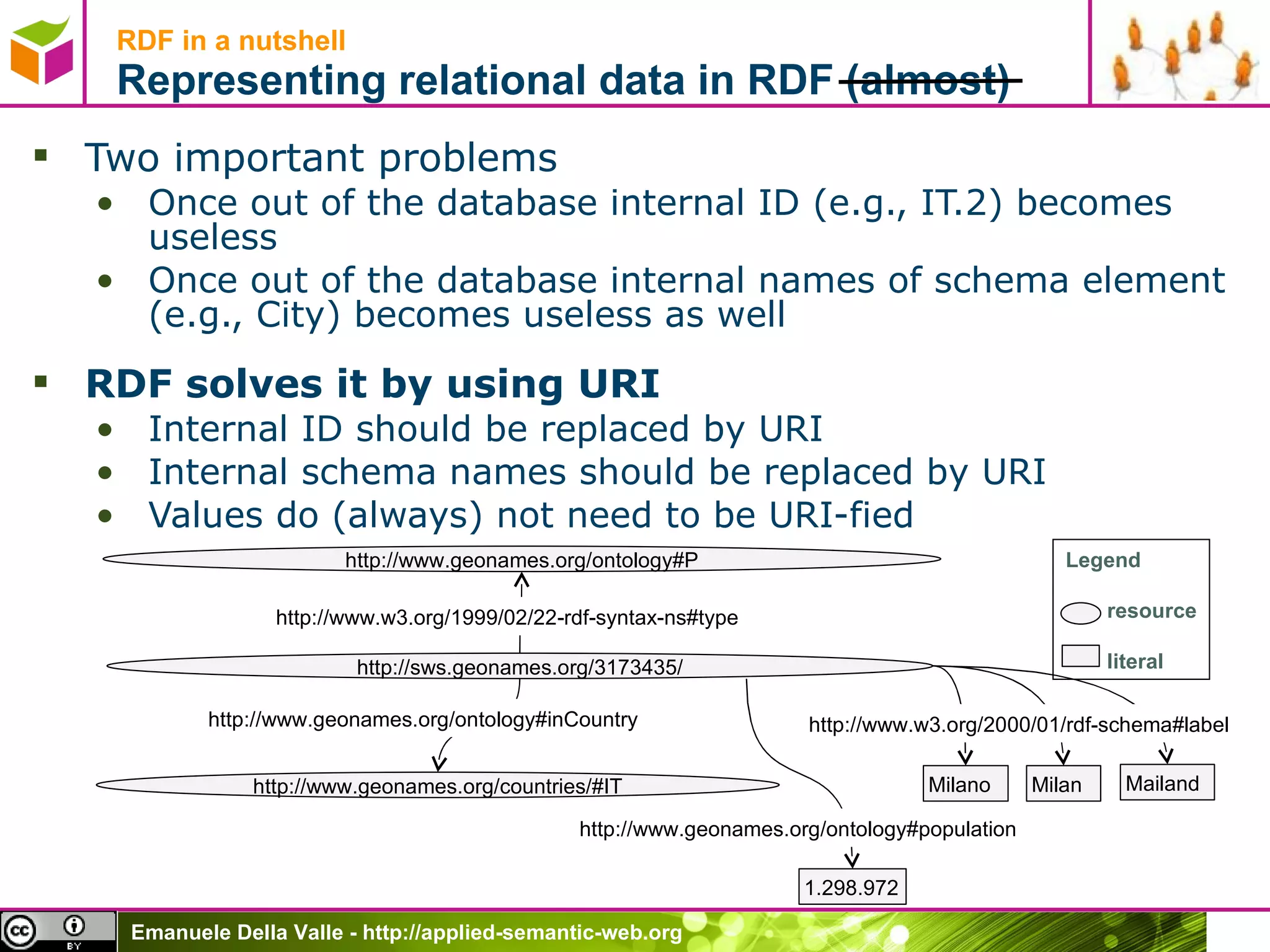
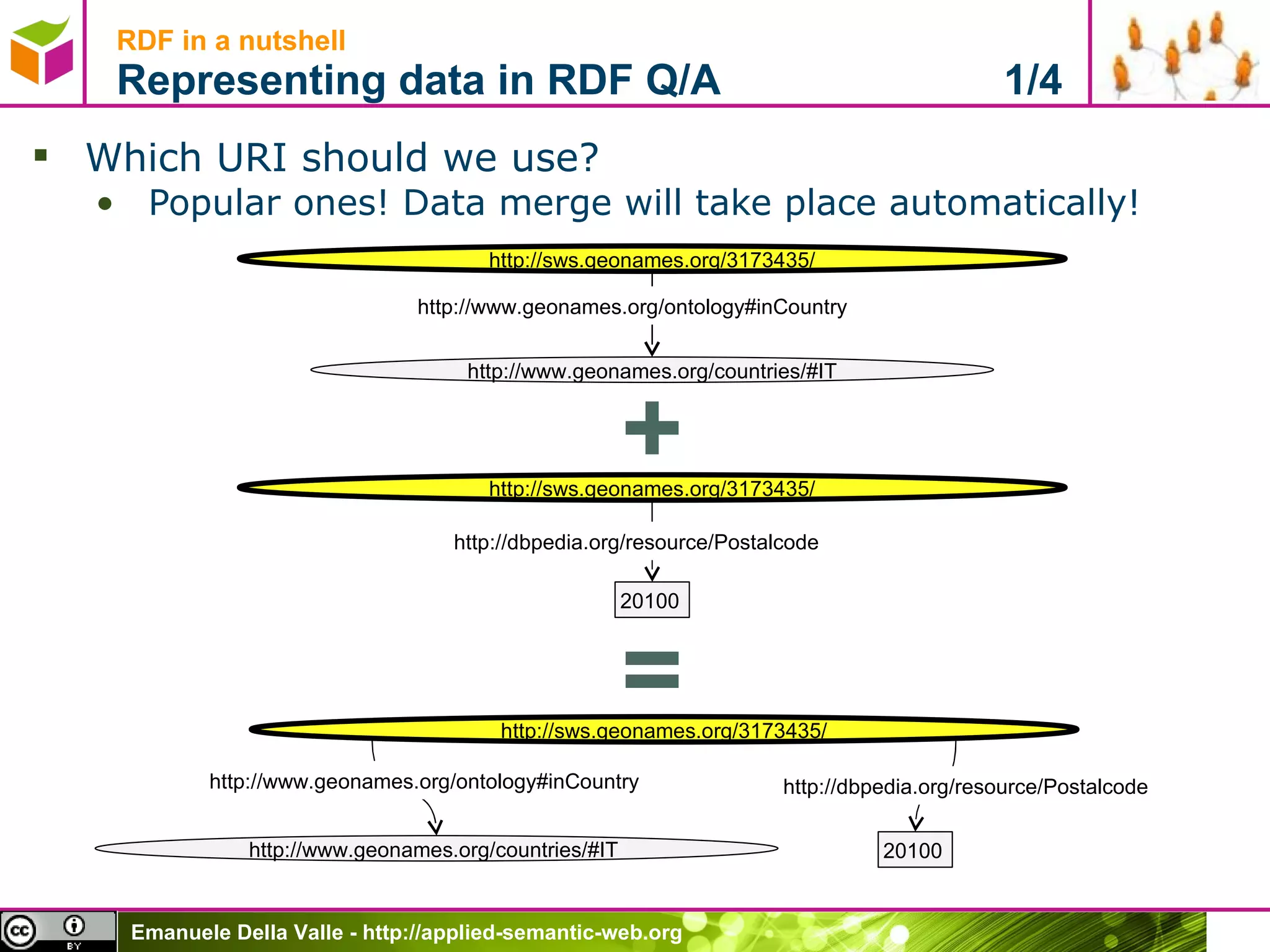
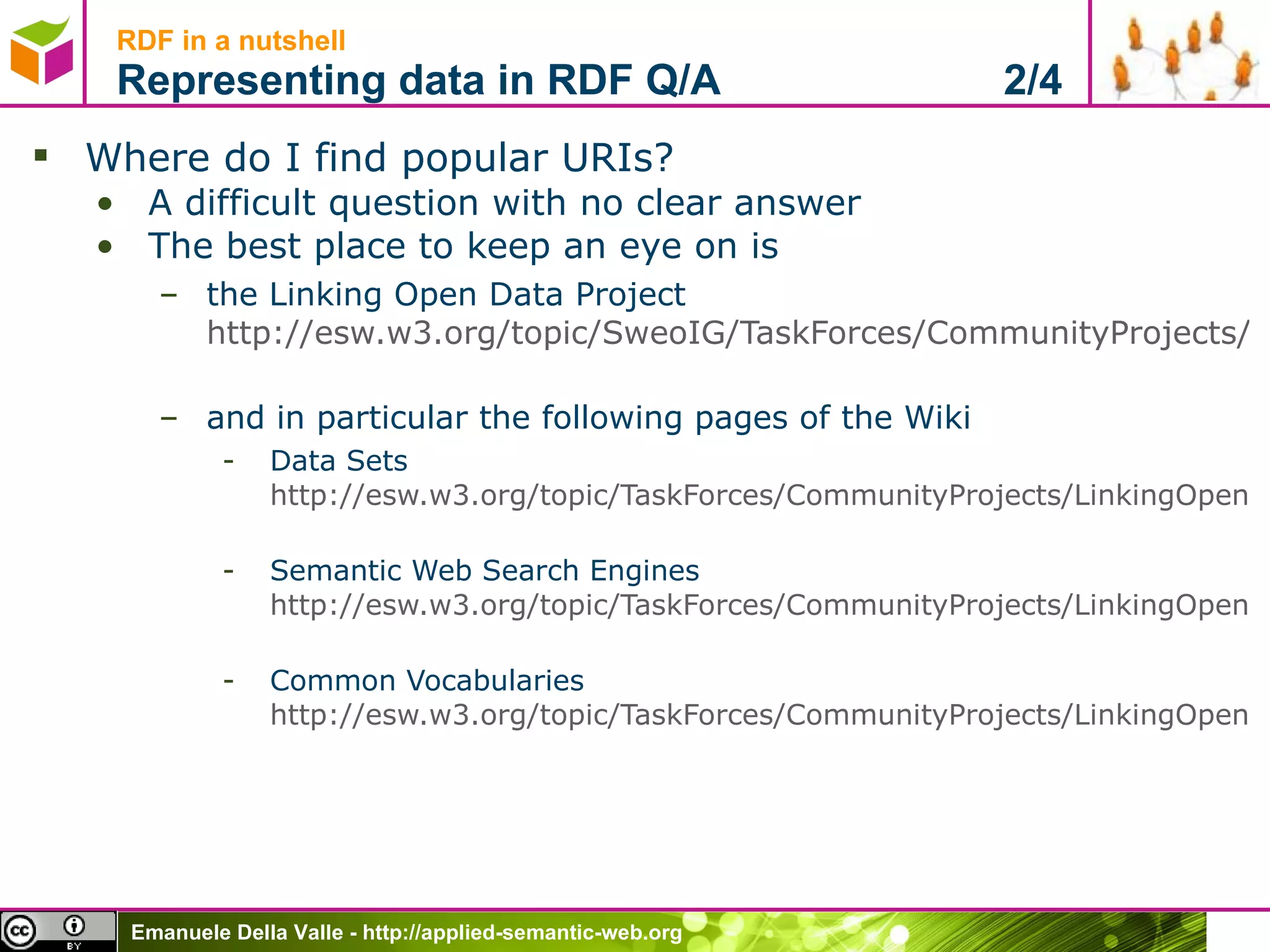
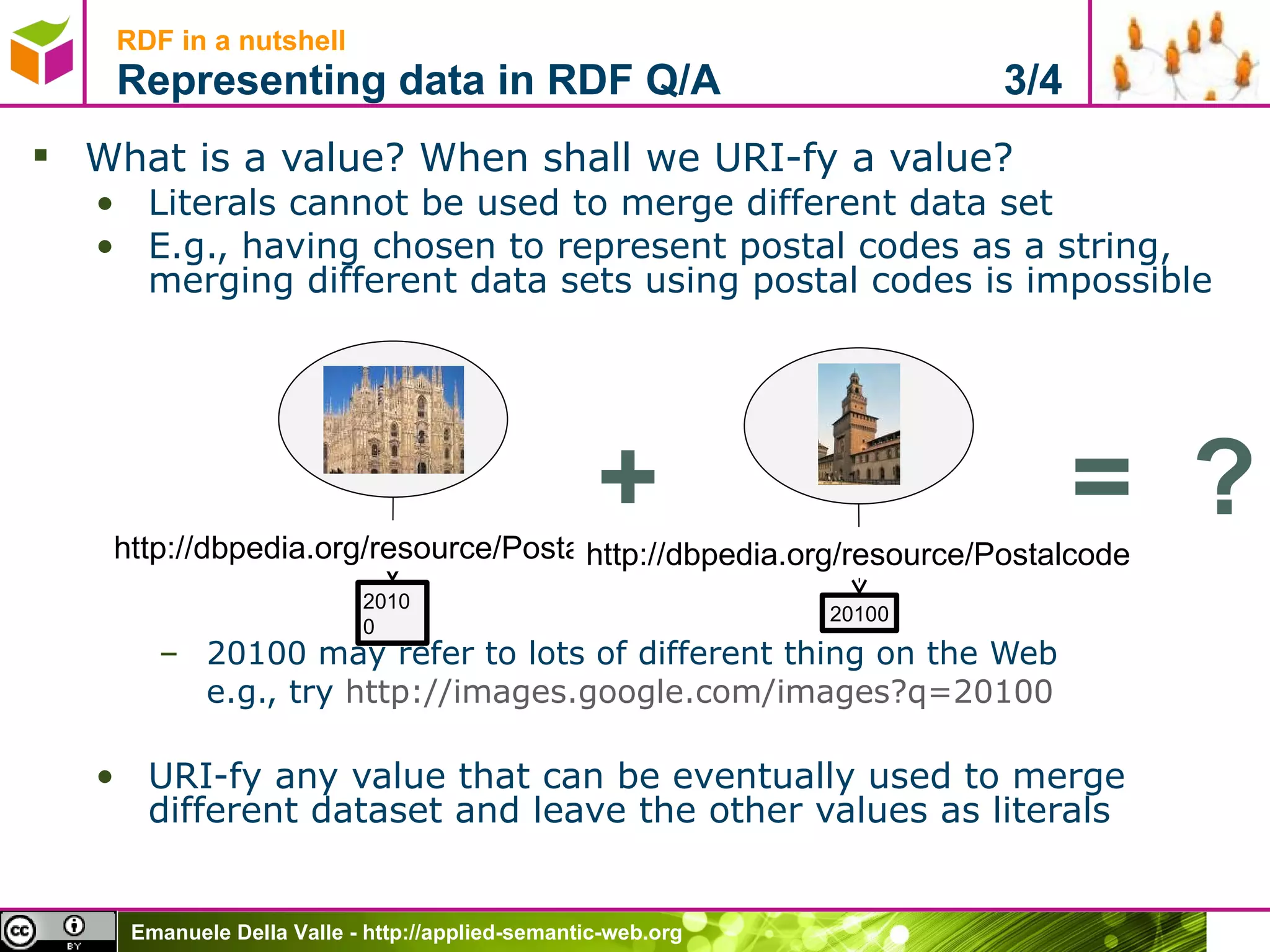
![What if I cannot thing about a good URI? When no go URI exists, you can use blank nodes ( ) The following relational data … … can be translated in RDF, in the BIO vocabulary [1], as follows [1] http://vocab.org/bio/0.1.html RDF in a nutshell Representing data in RDF Q/A 4/4 1974-02-28 http://www.sofia.org/#me http://purl.org/vocab/bio/0.1/Birth http://purl.org/vocab/bio/0.1/Marriage 1995-08-04 http://purl.org/vocab/bio/0.1/event http://purl.org/vocab/bio/0.1/event http://www.w3.org/1999/02/22-rdf-syntax-ns#type http://purl.org/vocab/bio/0.1/date http://purl.org/vocab/bio/0.1/event http://purl.org/vocab/bio/0.1/date Advanced Person Bio Event Date Sofia Birth 1974-02-28 Sofia Marriage 1995-08-04](https://image.slidesharecdn.com/semanticweb4gis-110504153905-phpapp02/75/Introduction-to-Semantic-Web-for-GIS-Practitioners-33-2048.jpg)
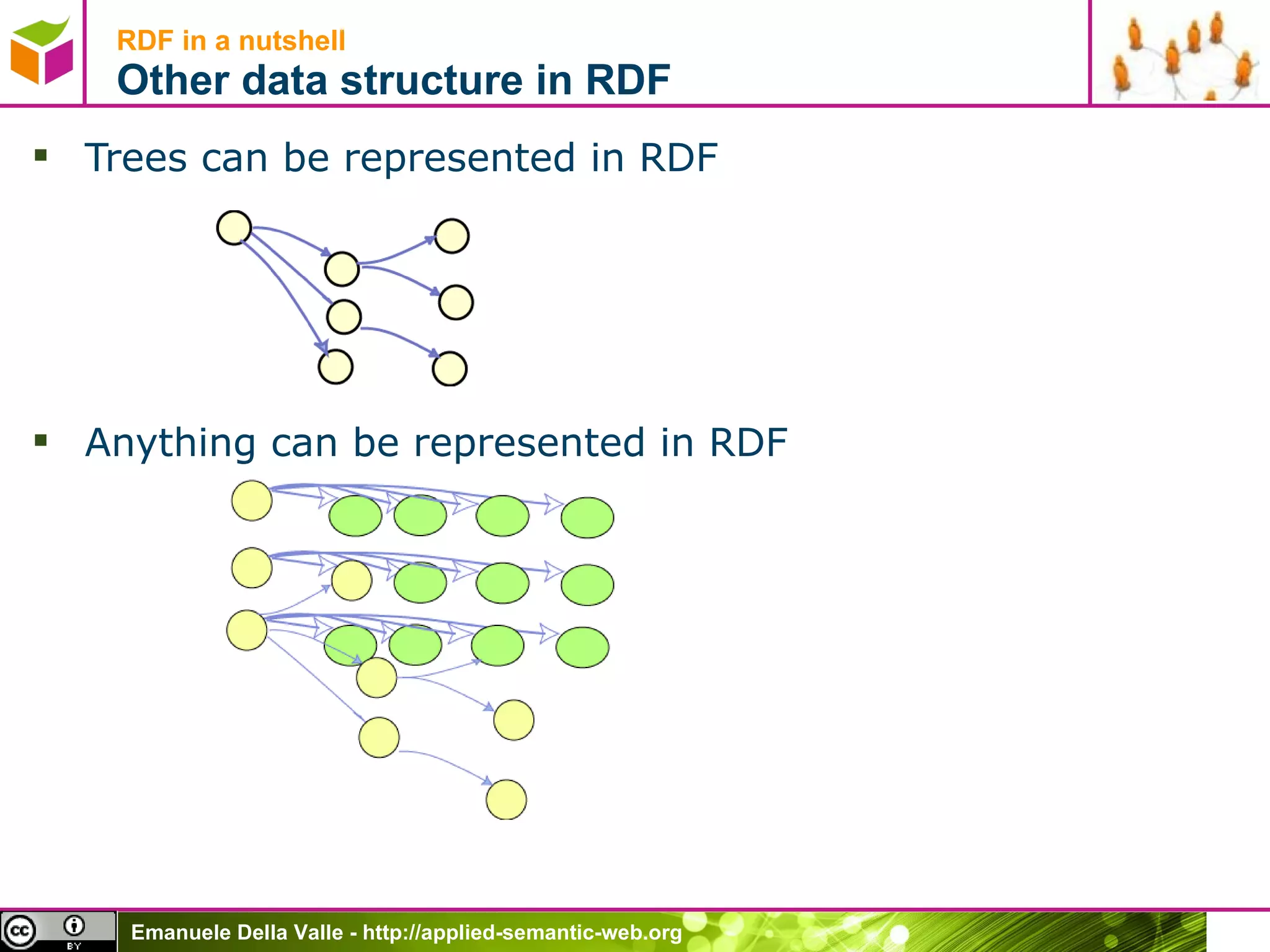
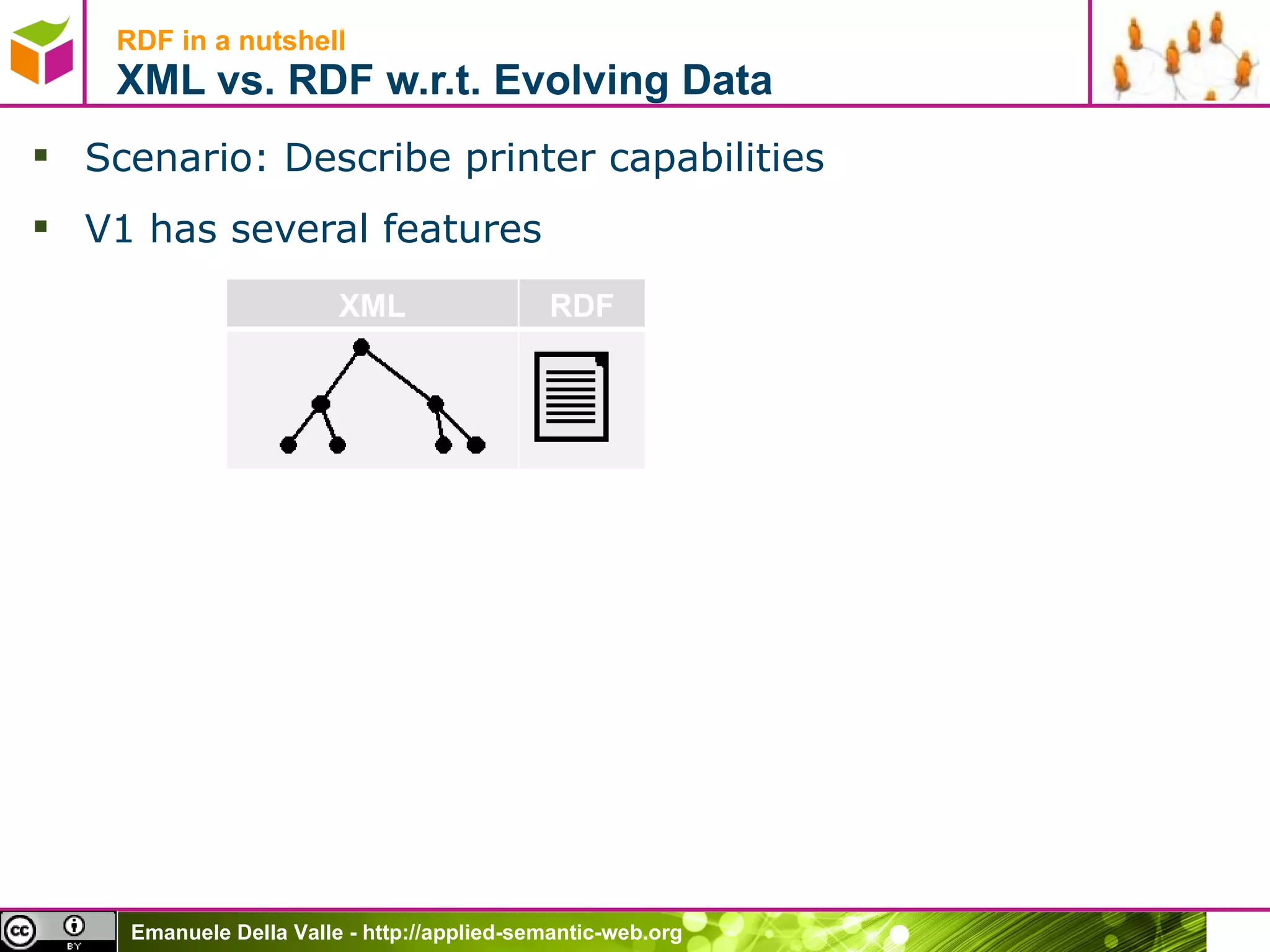
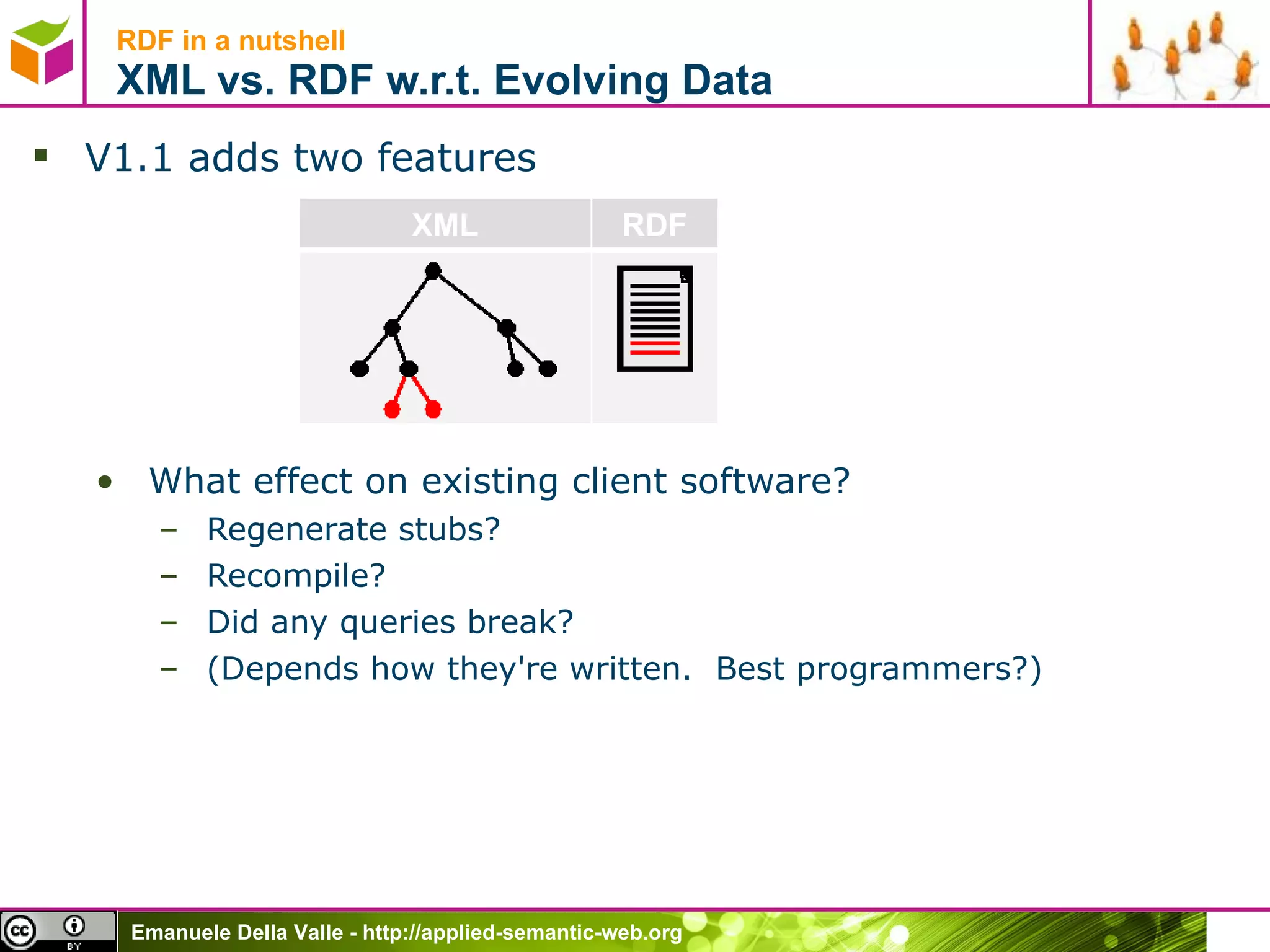
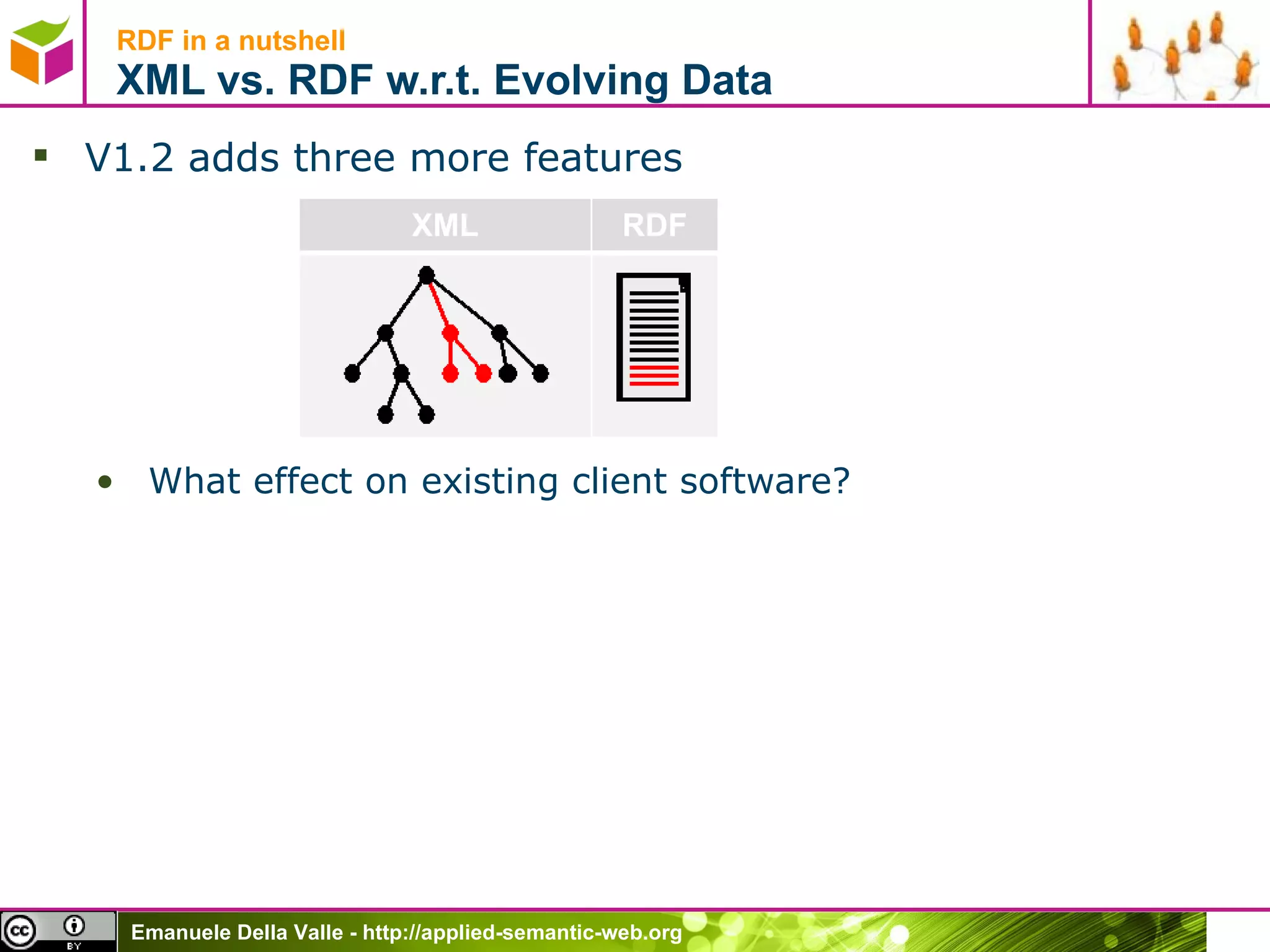
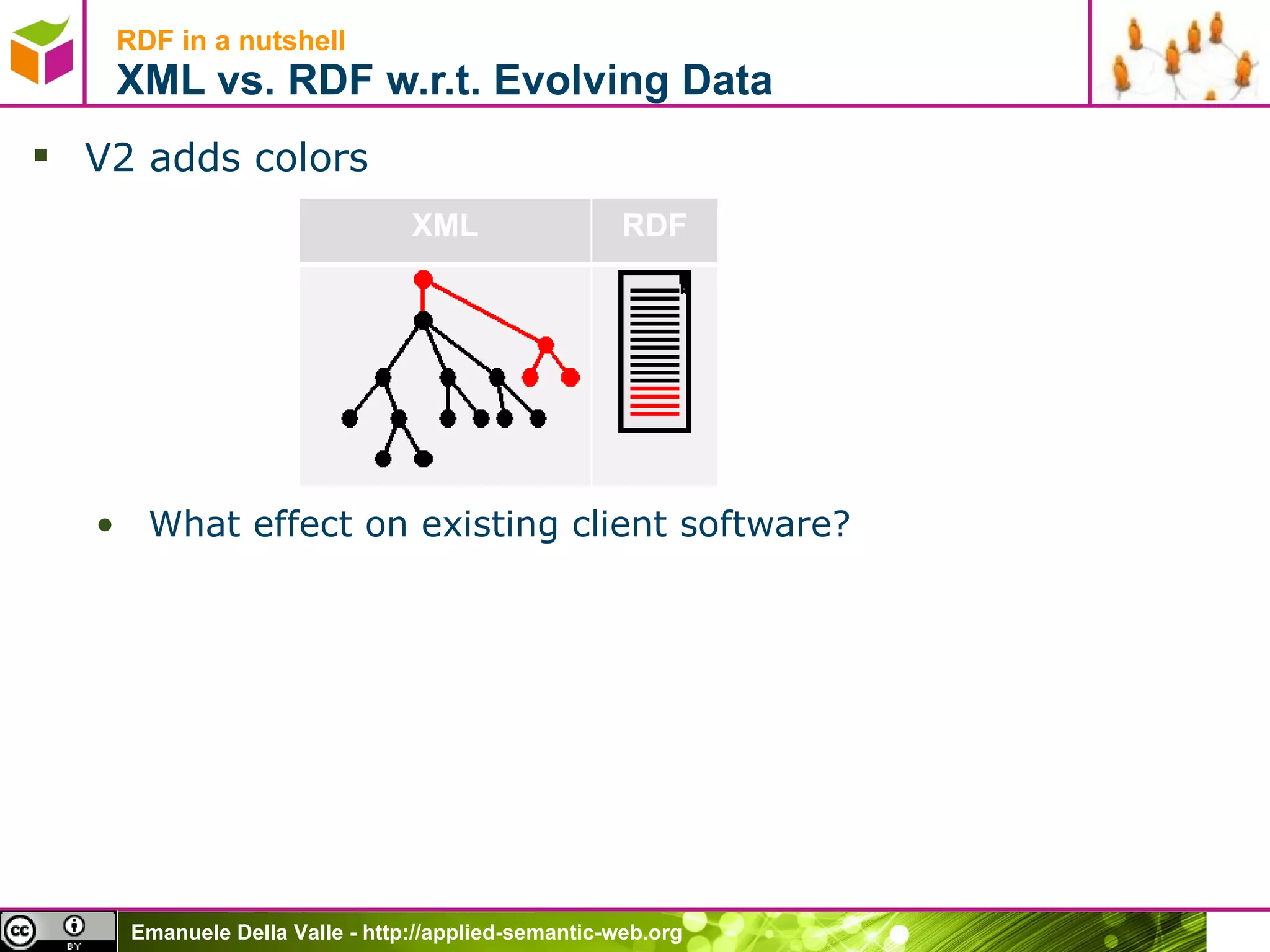
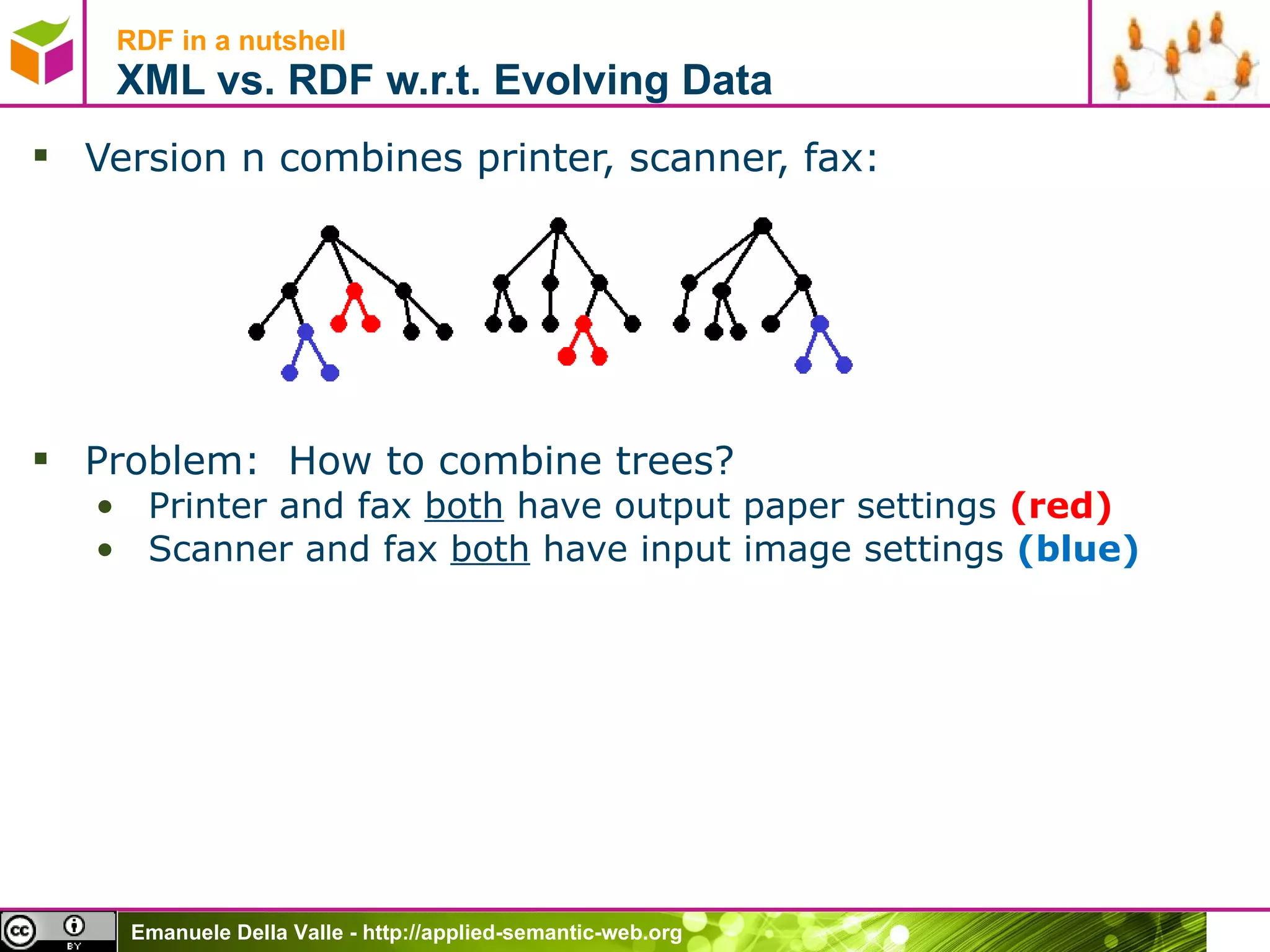
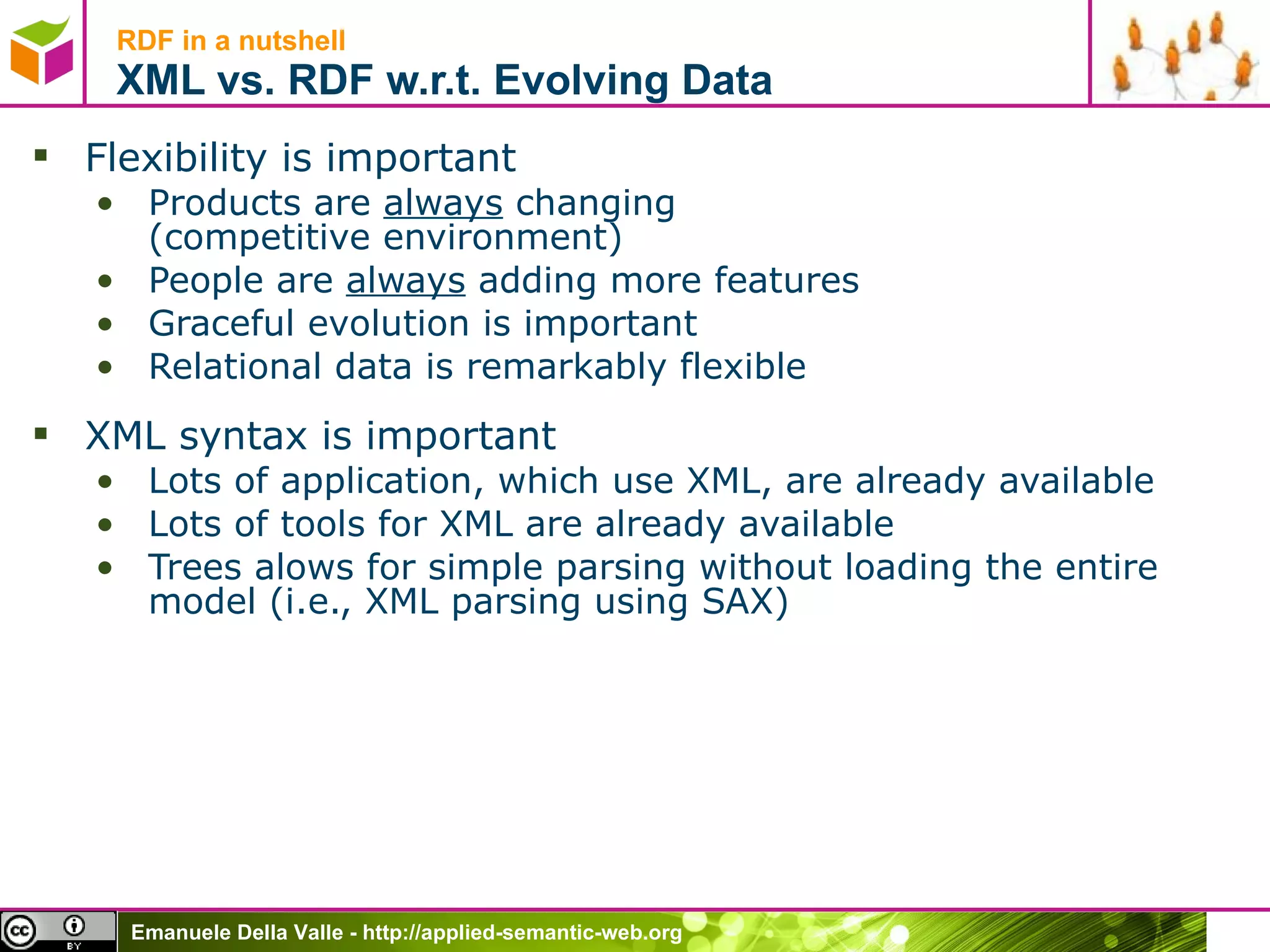
![RDF in a nutshell Serializing RDF in XML W3C standardized an RDF/XML syntax [1] The basic idea is to insert an XML element for each node (sobject and value) and arc (predicate) Es. < rdf:RDF xmlns:rdf= ”http://www.w3.org/1999/02/22-rdf-syntax-ns#” xmlns:ex= ”http://www.example.org/” xmlns:sid= “URN:org:example:staffid:” xmlns:dc= ”http://purl.org/dc/elements/1.1/”> < rdf:Description rdf:about ="http://www.example.org/index.html "> < dc:creator > < rdf:Description rdf:about ="URN:org:example:staffid:85740"/> </ dc:creator > </rdf:Description> </rdf:RDF> [1] RDF/XML Syntax Specification available at http://www.w3.org/TR/rdf-syntax-grammar/ ex:index.html sid:85740 dc:creator property element Root tag](https://image.slidesharecdn.com/semanticweb4gis-110504153905-phpapp02/75/Introduction-to-Semantic-Web-for-GIS-Practitioners-41-2048.jpg)
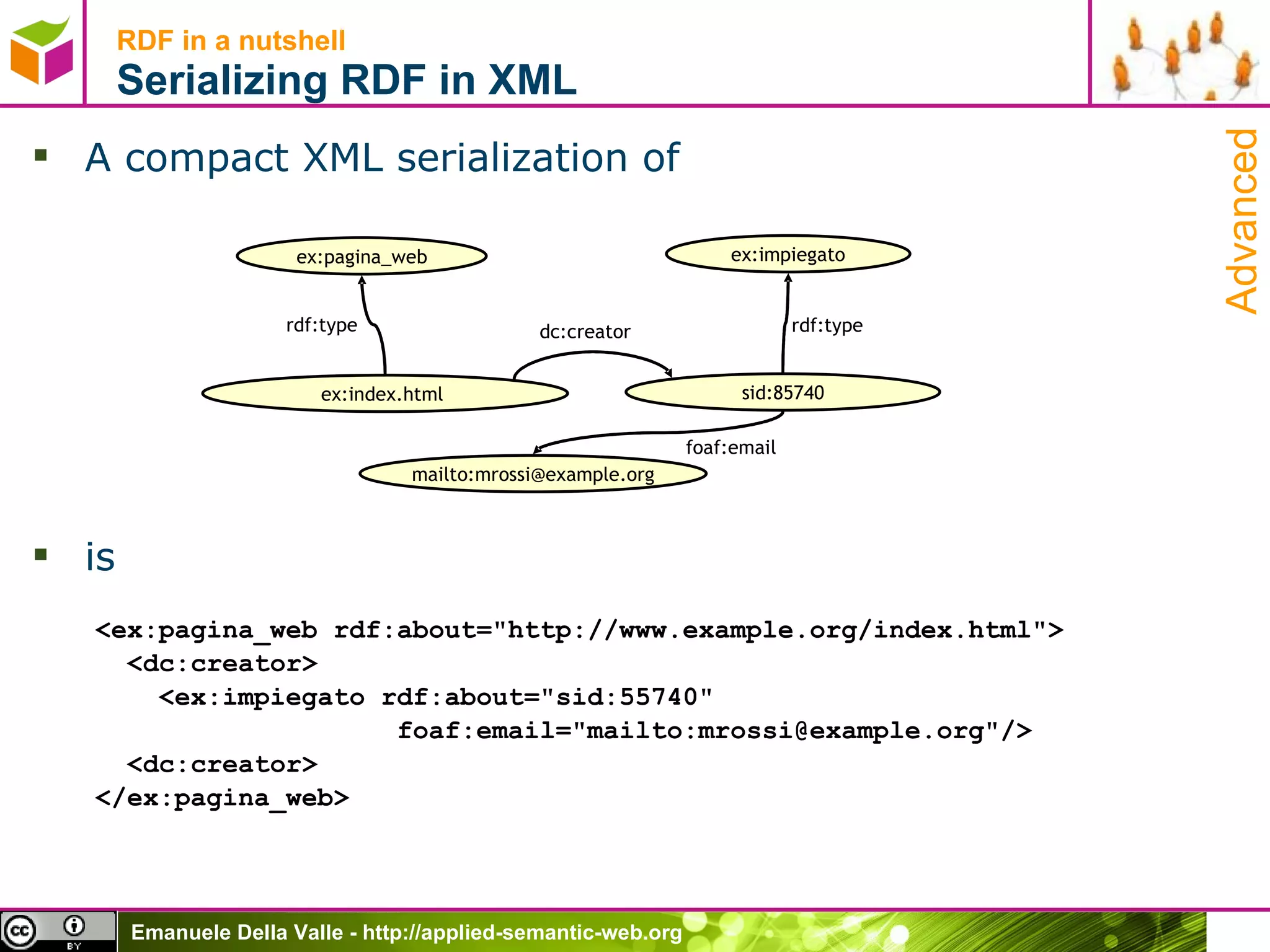
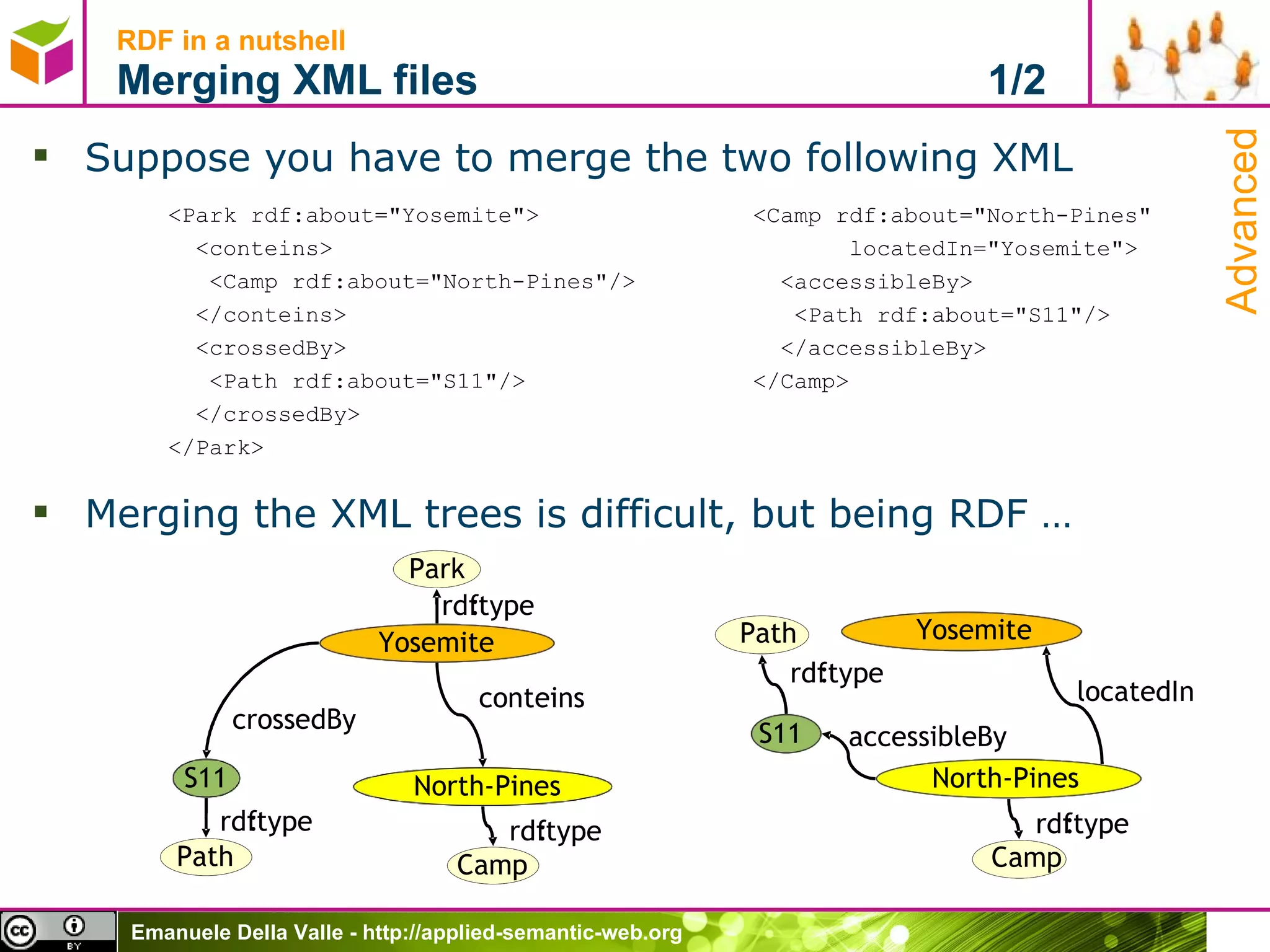
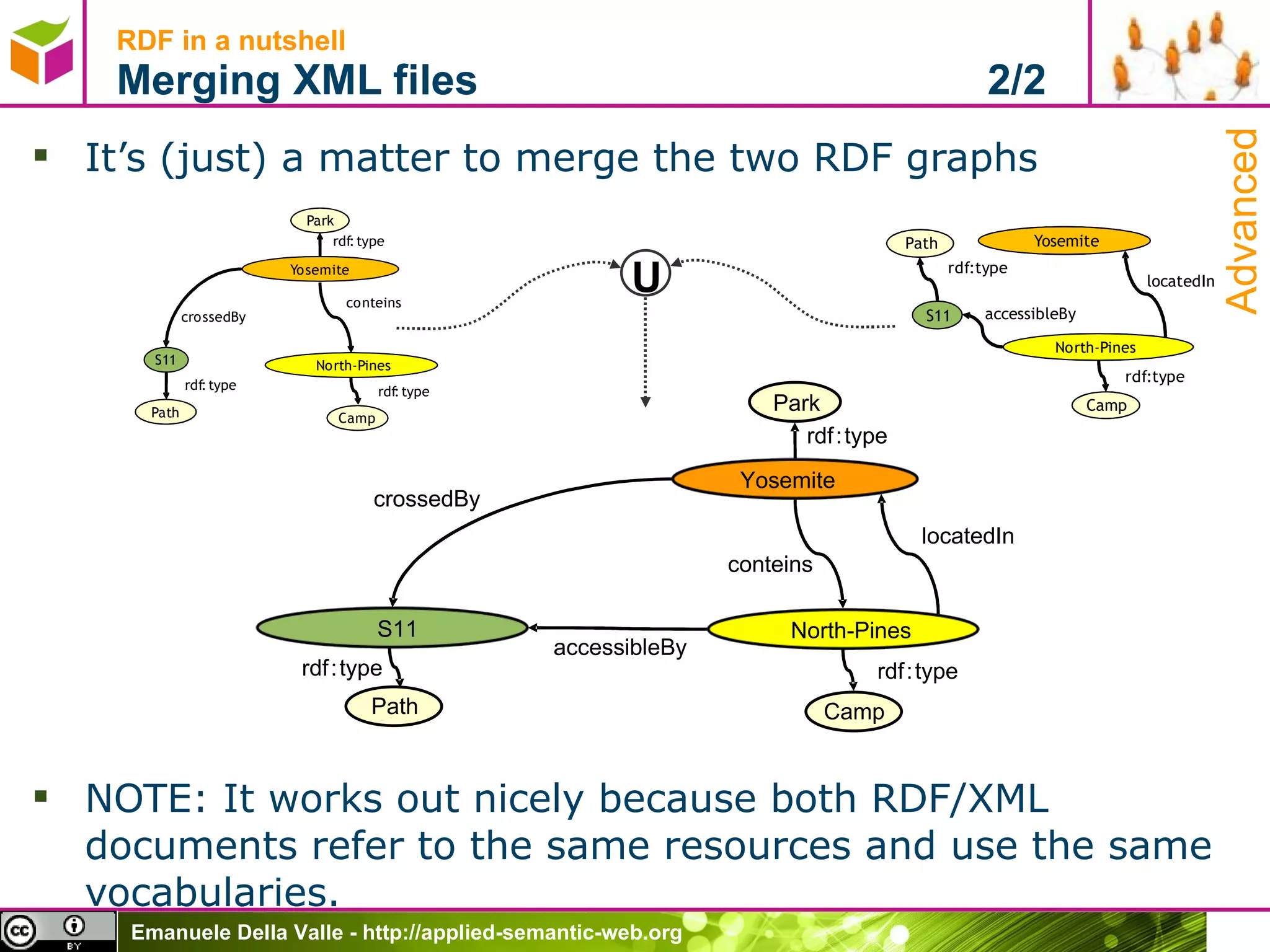
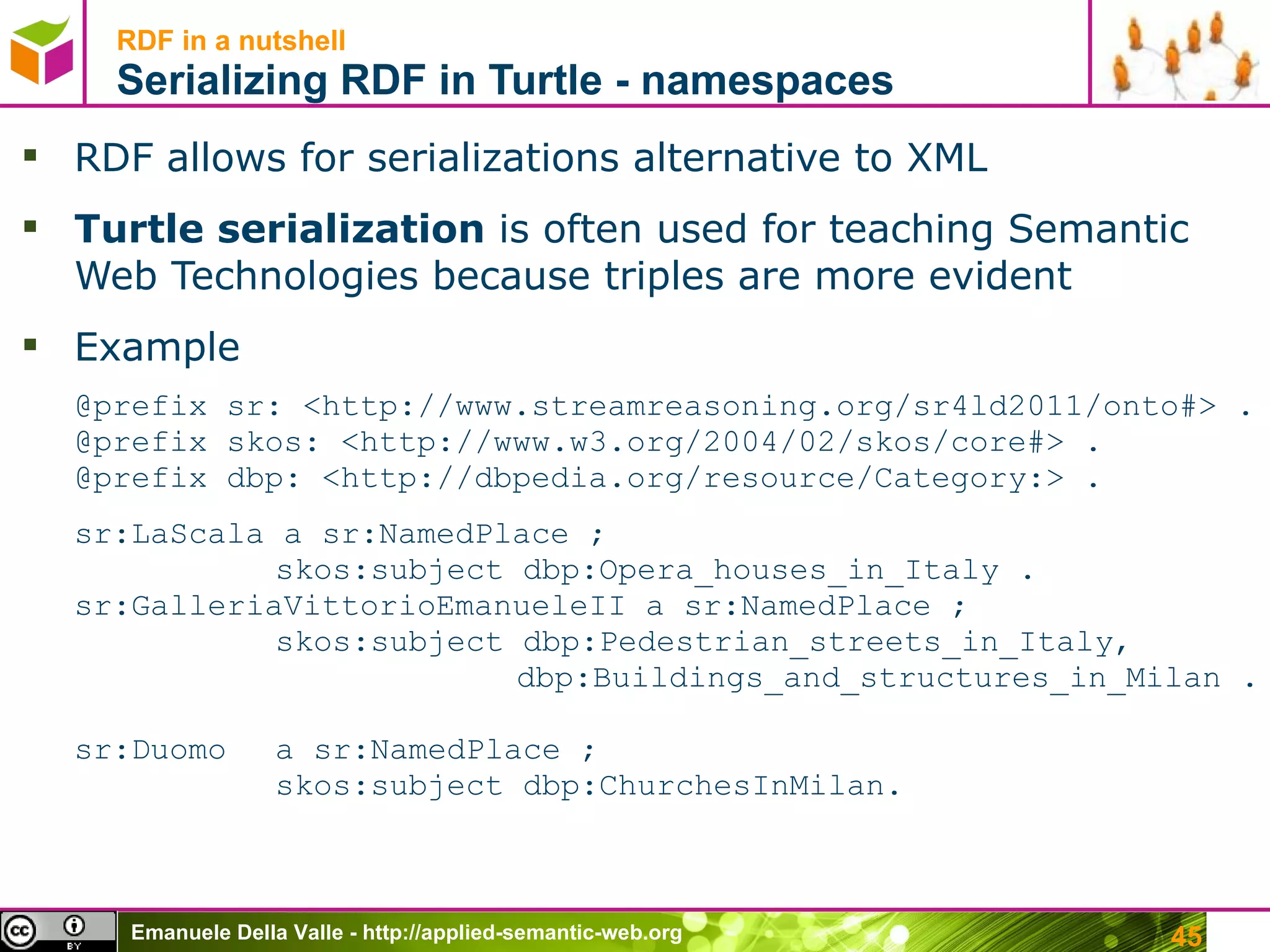
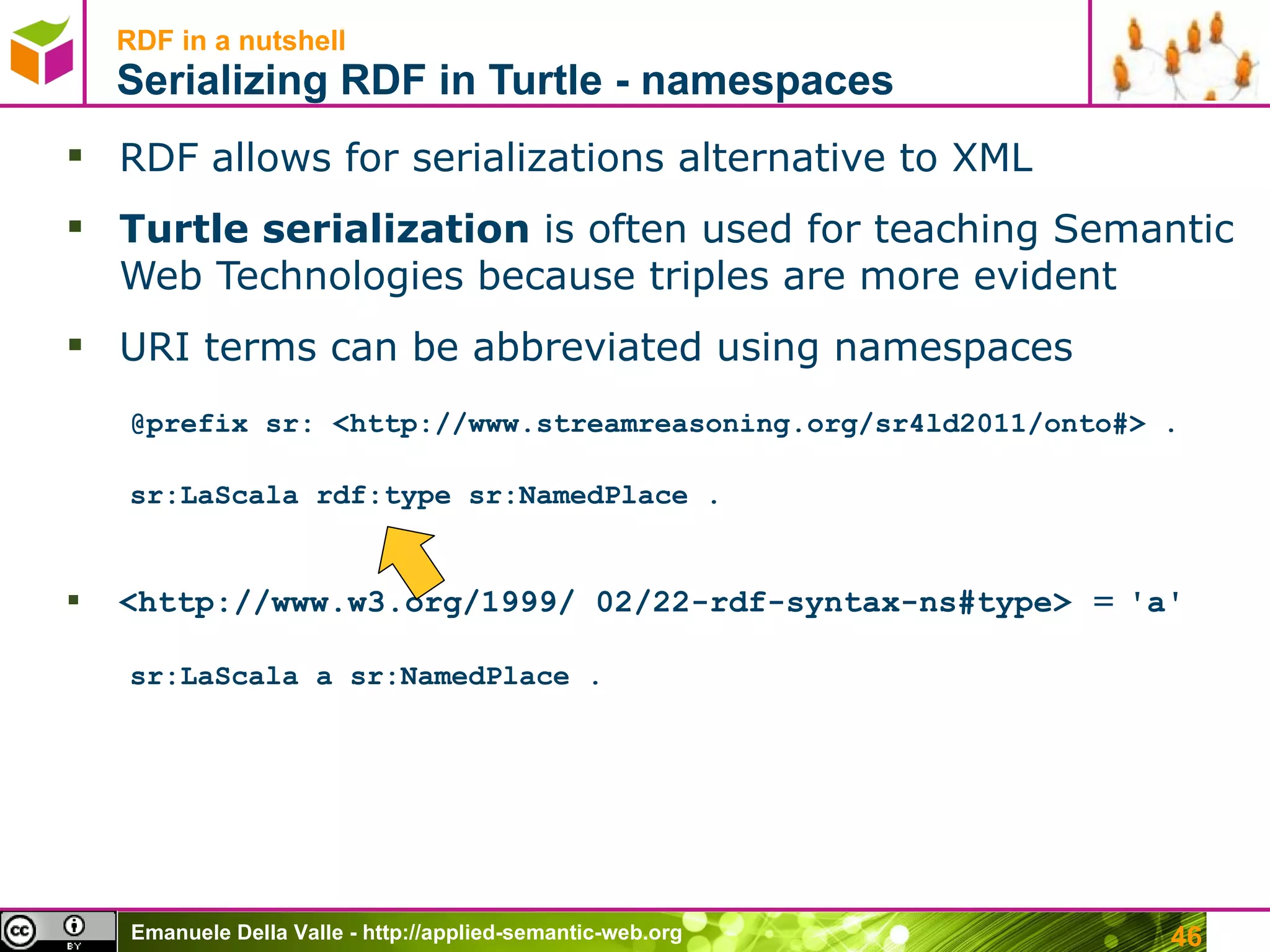
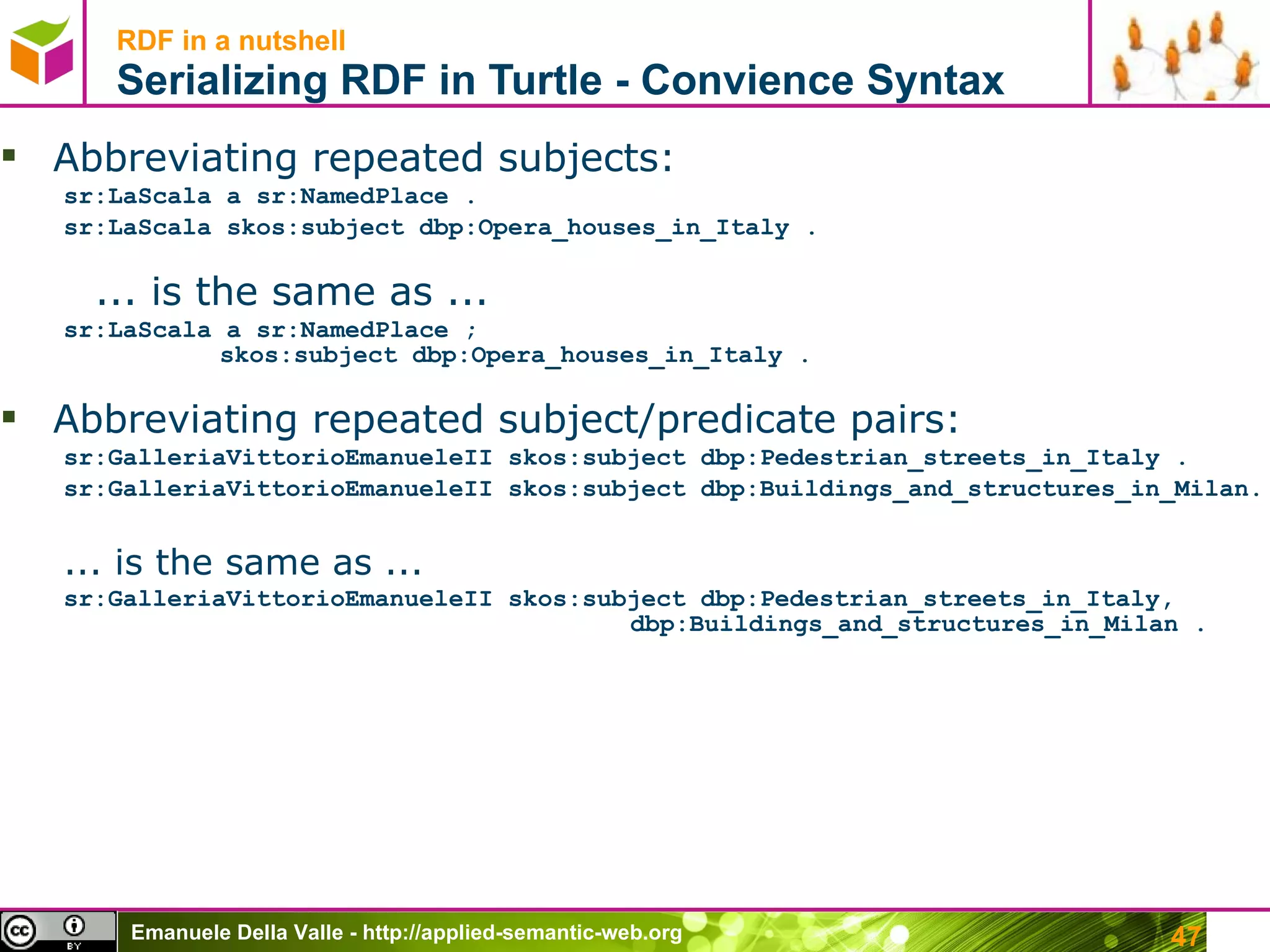
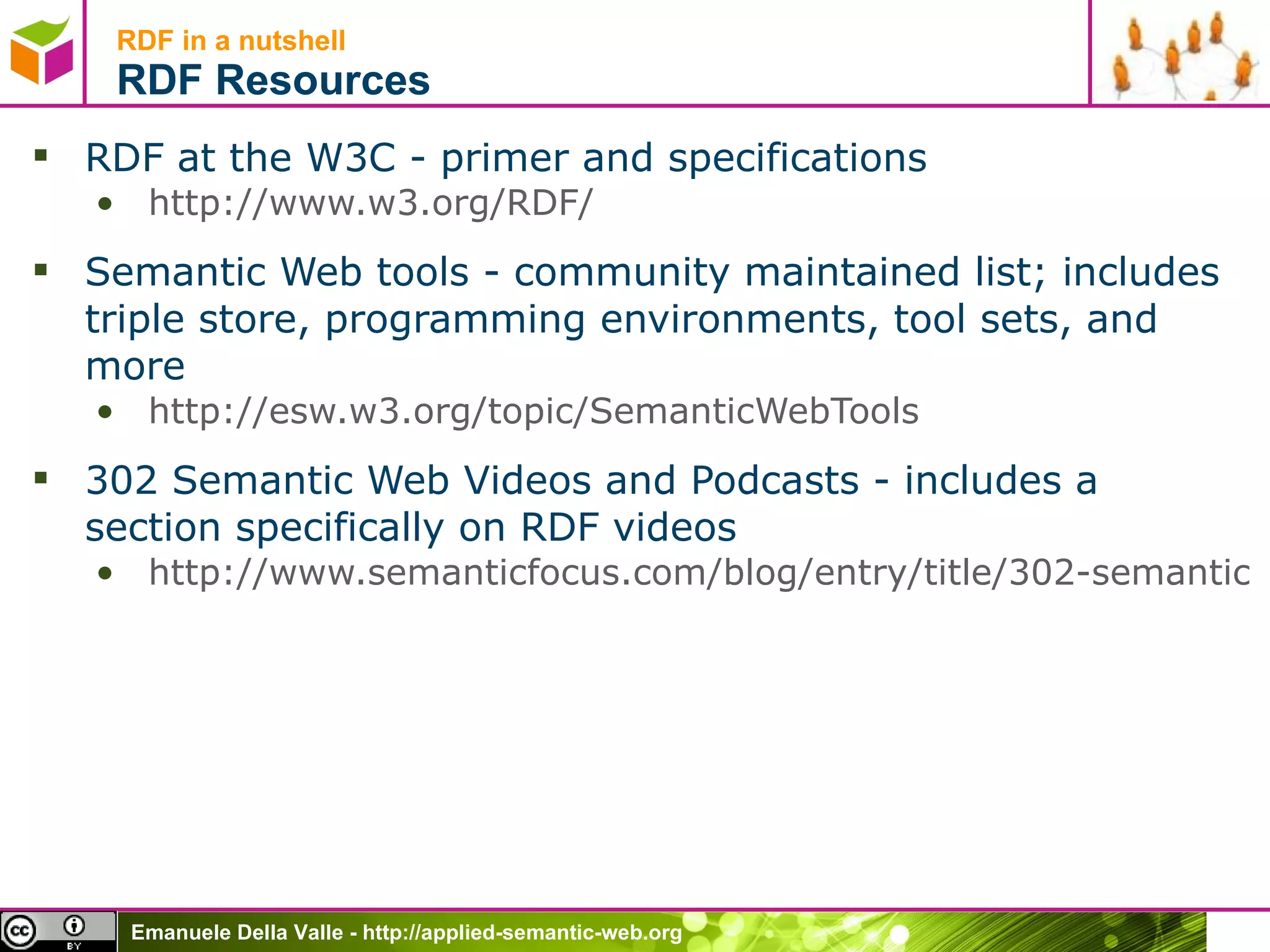
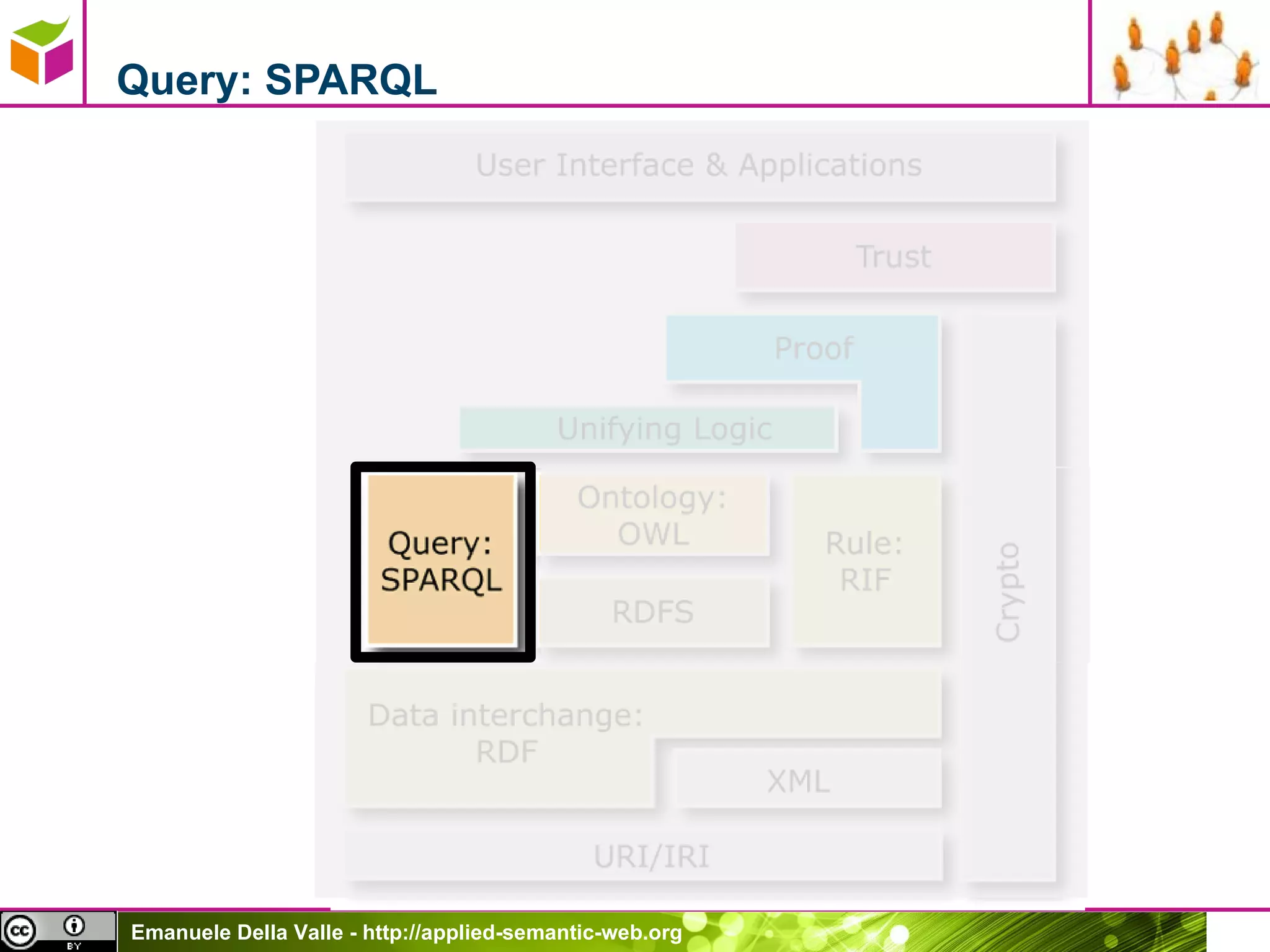
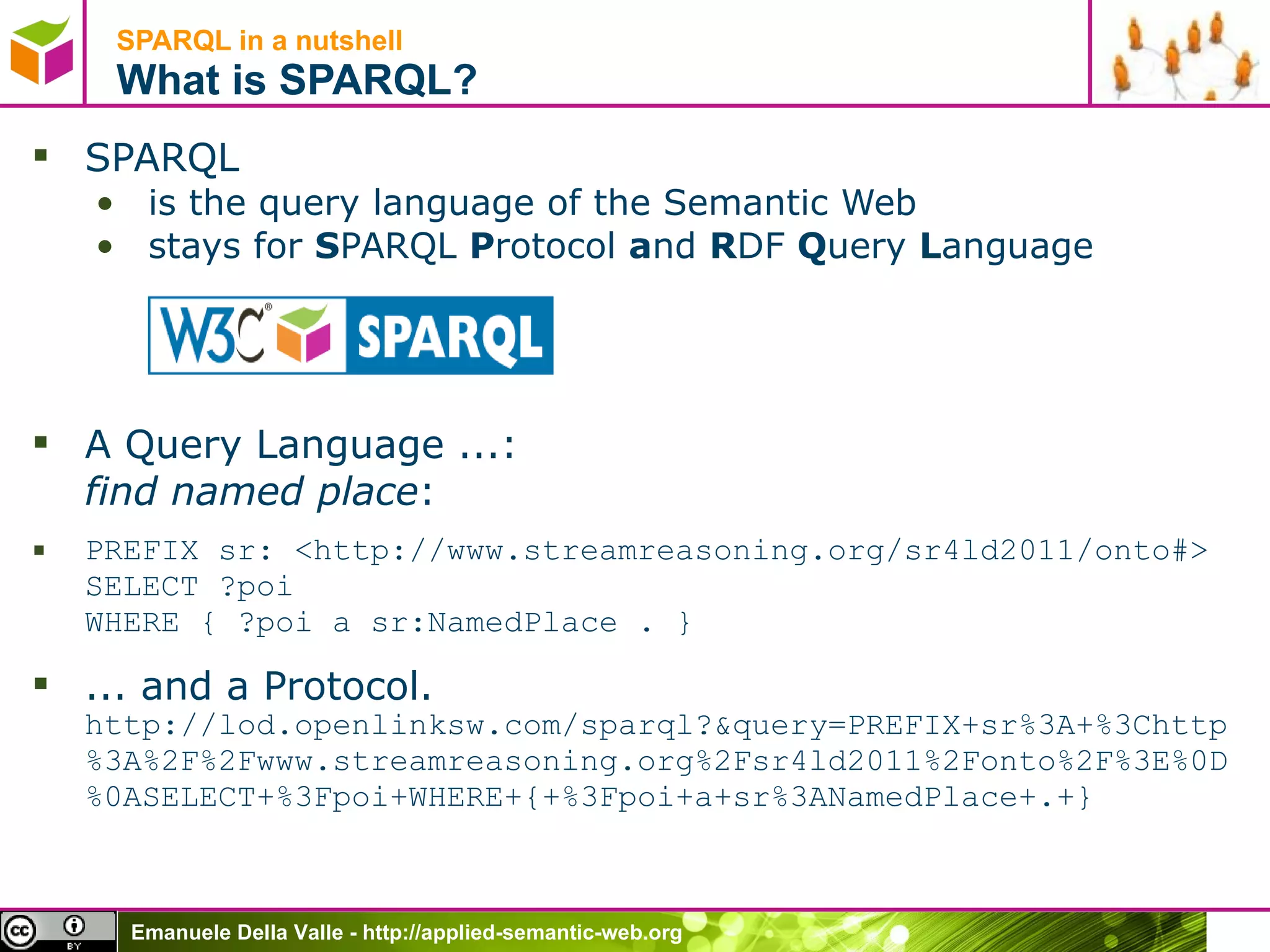
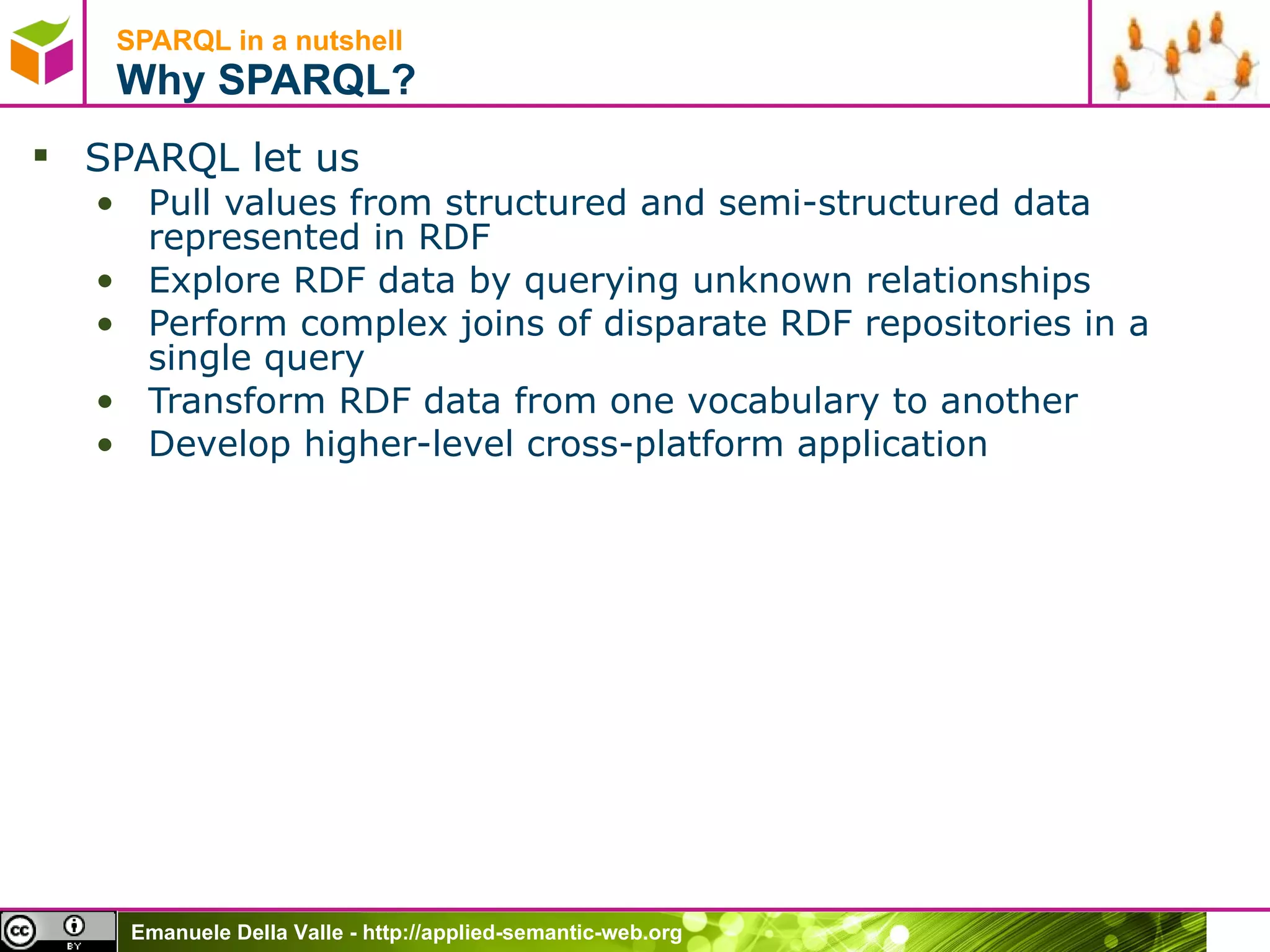
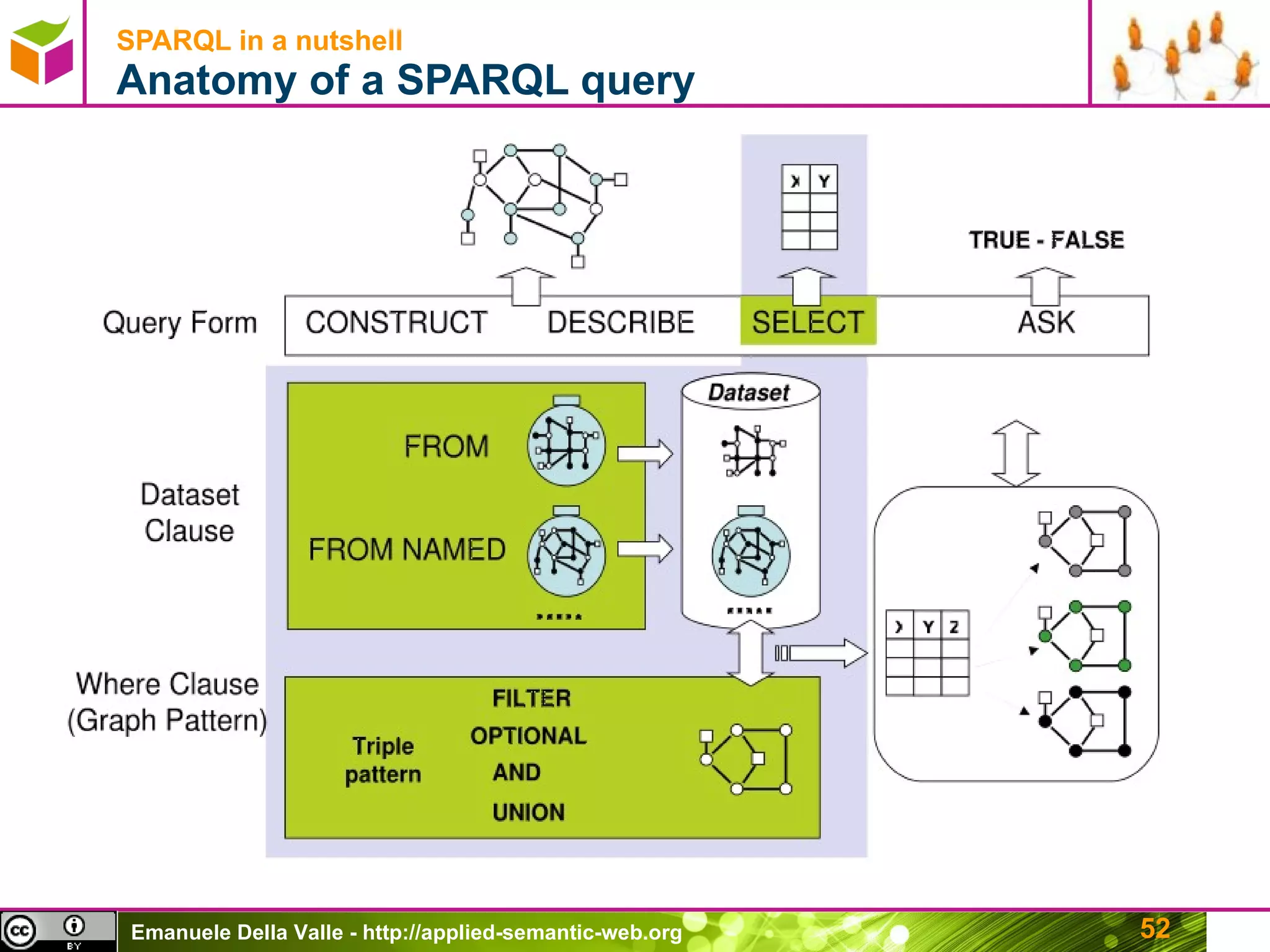
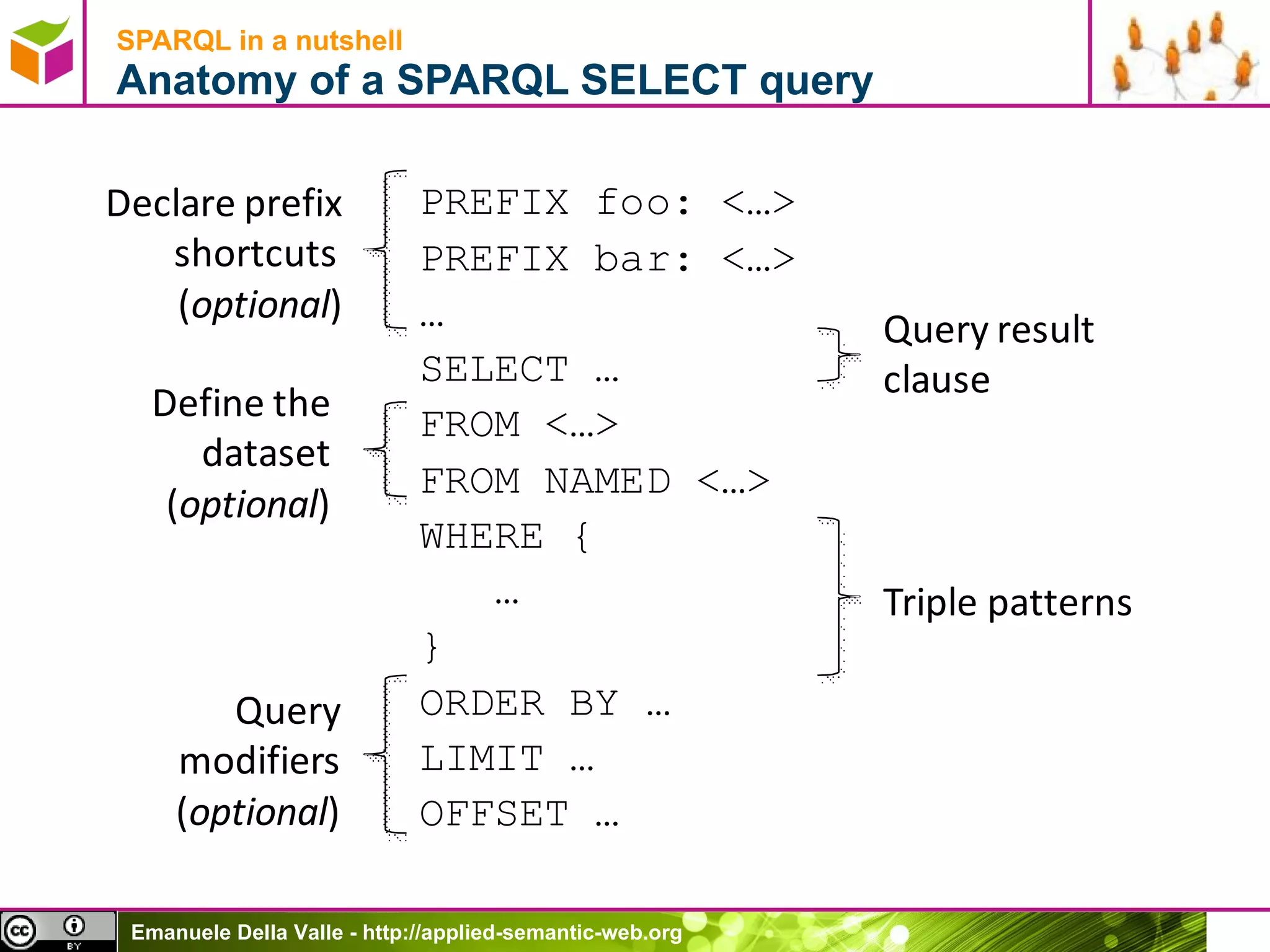
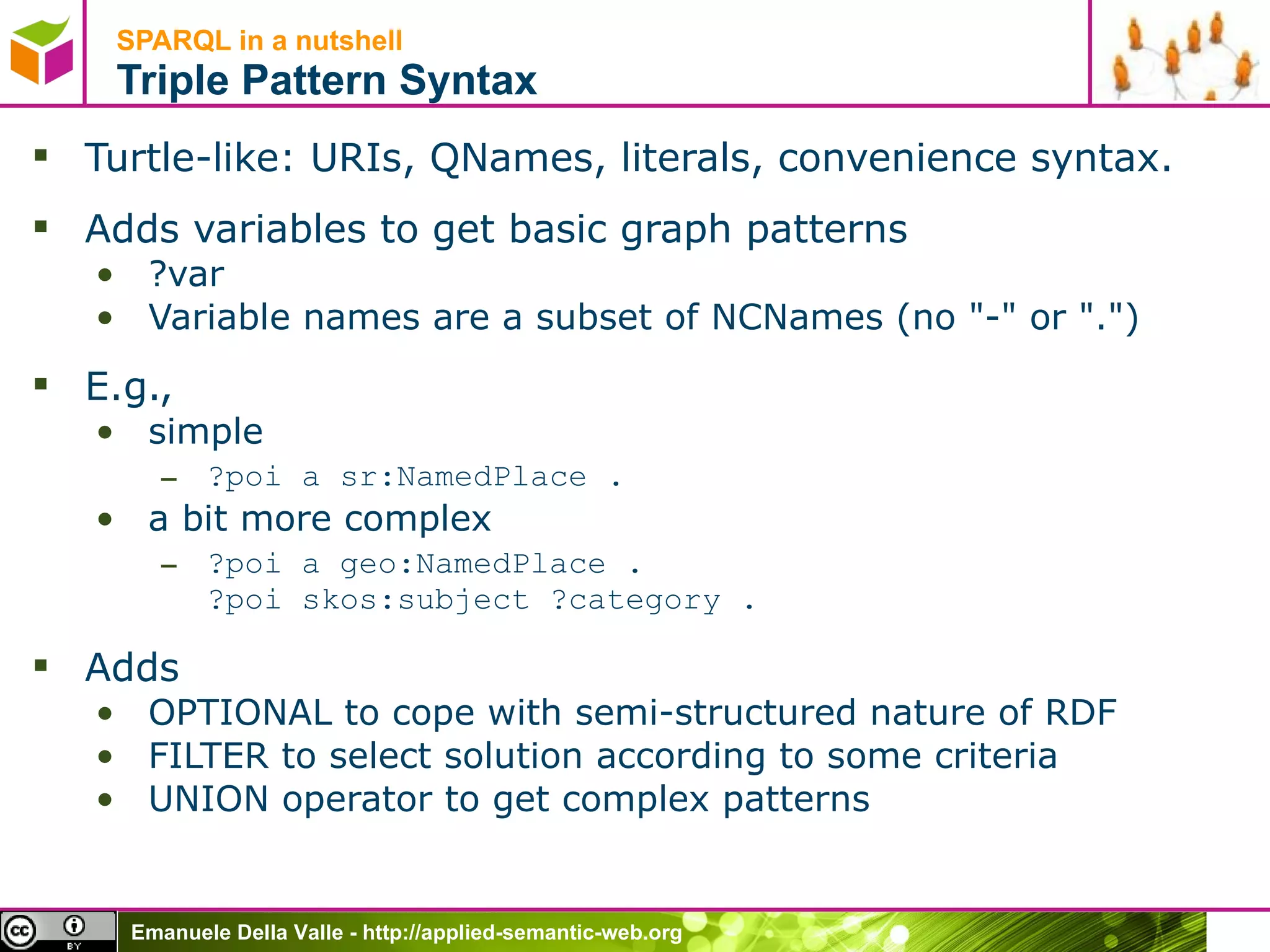
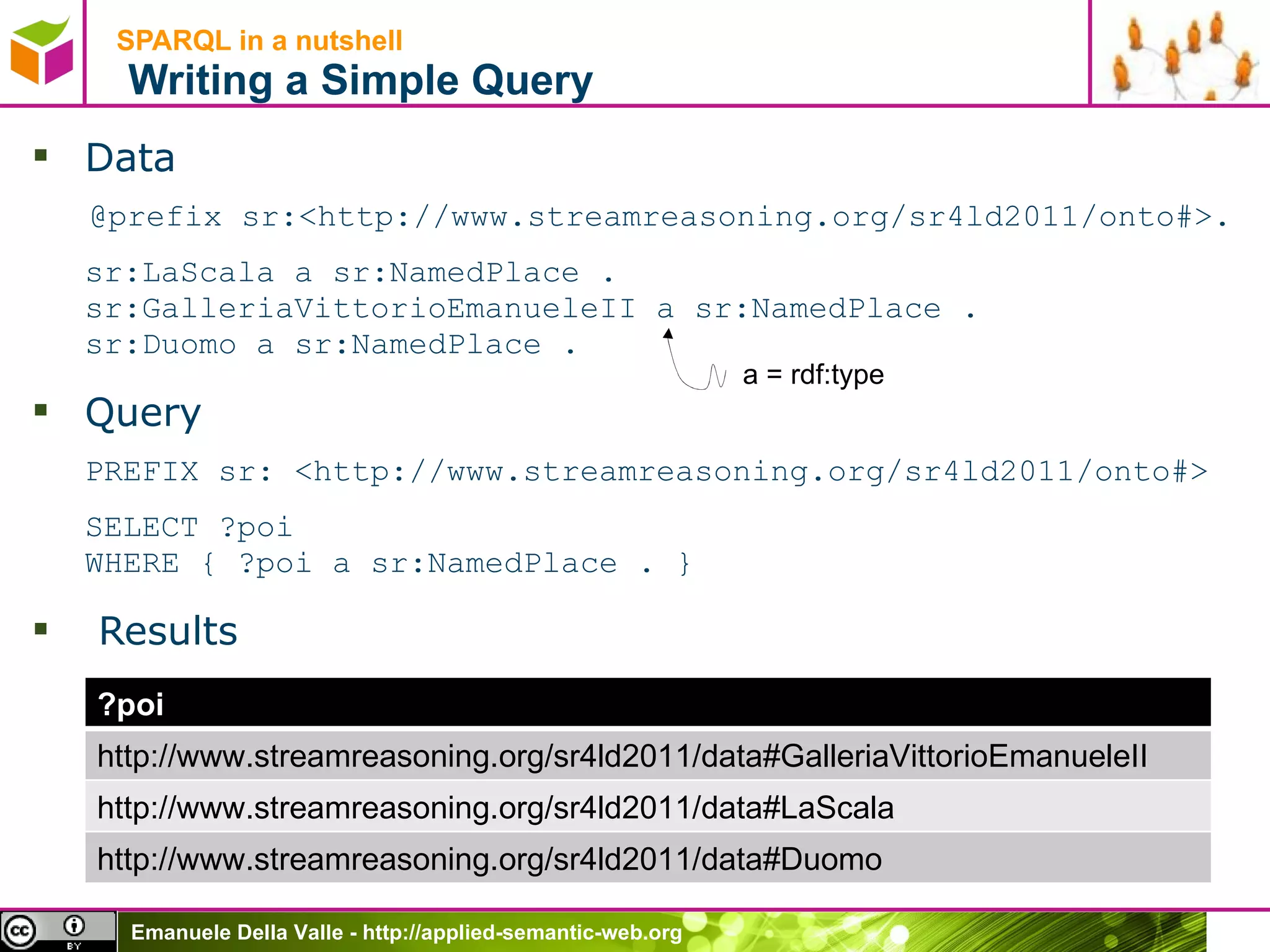
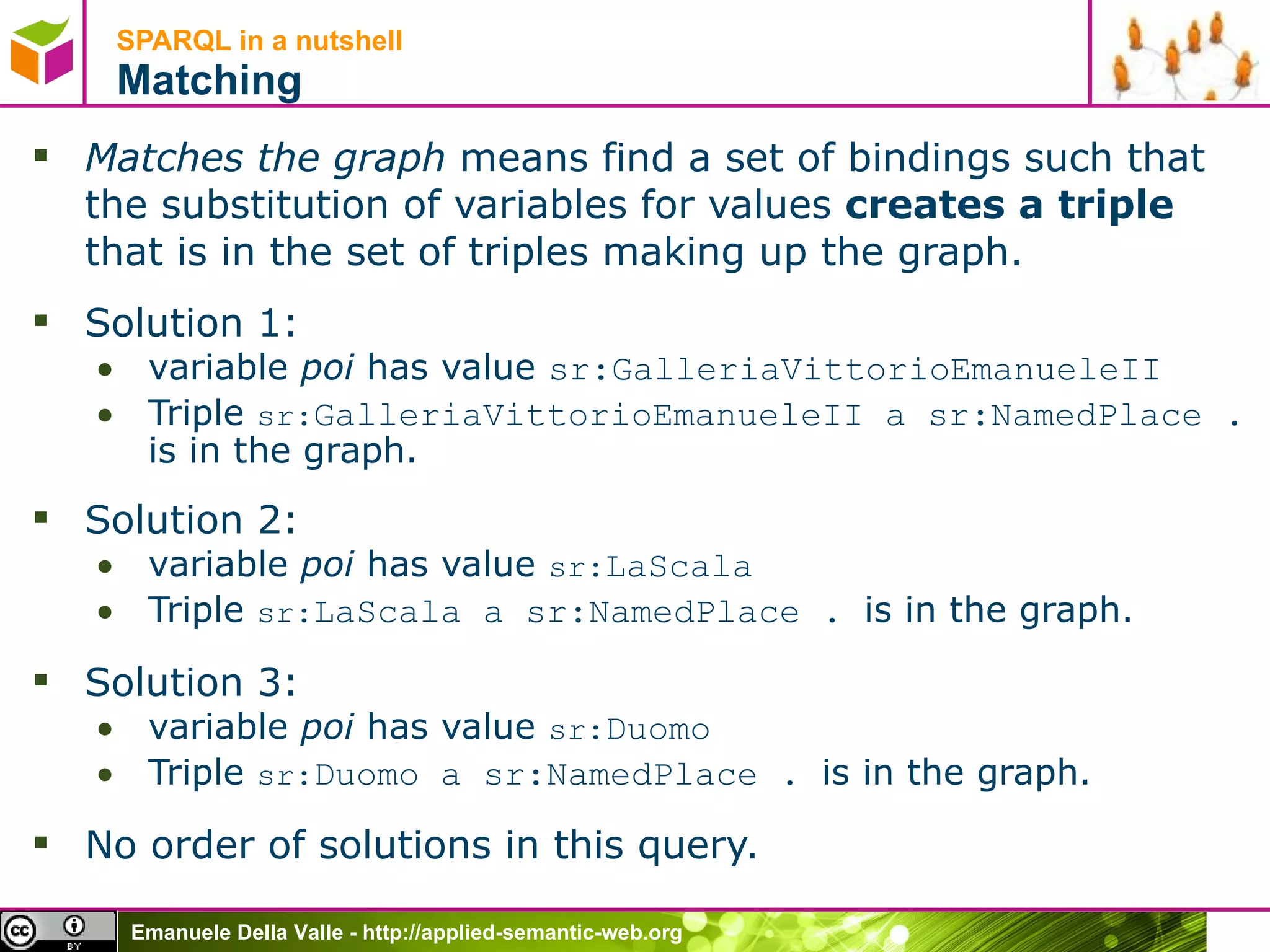
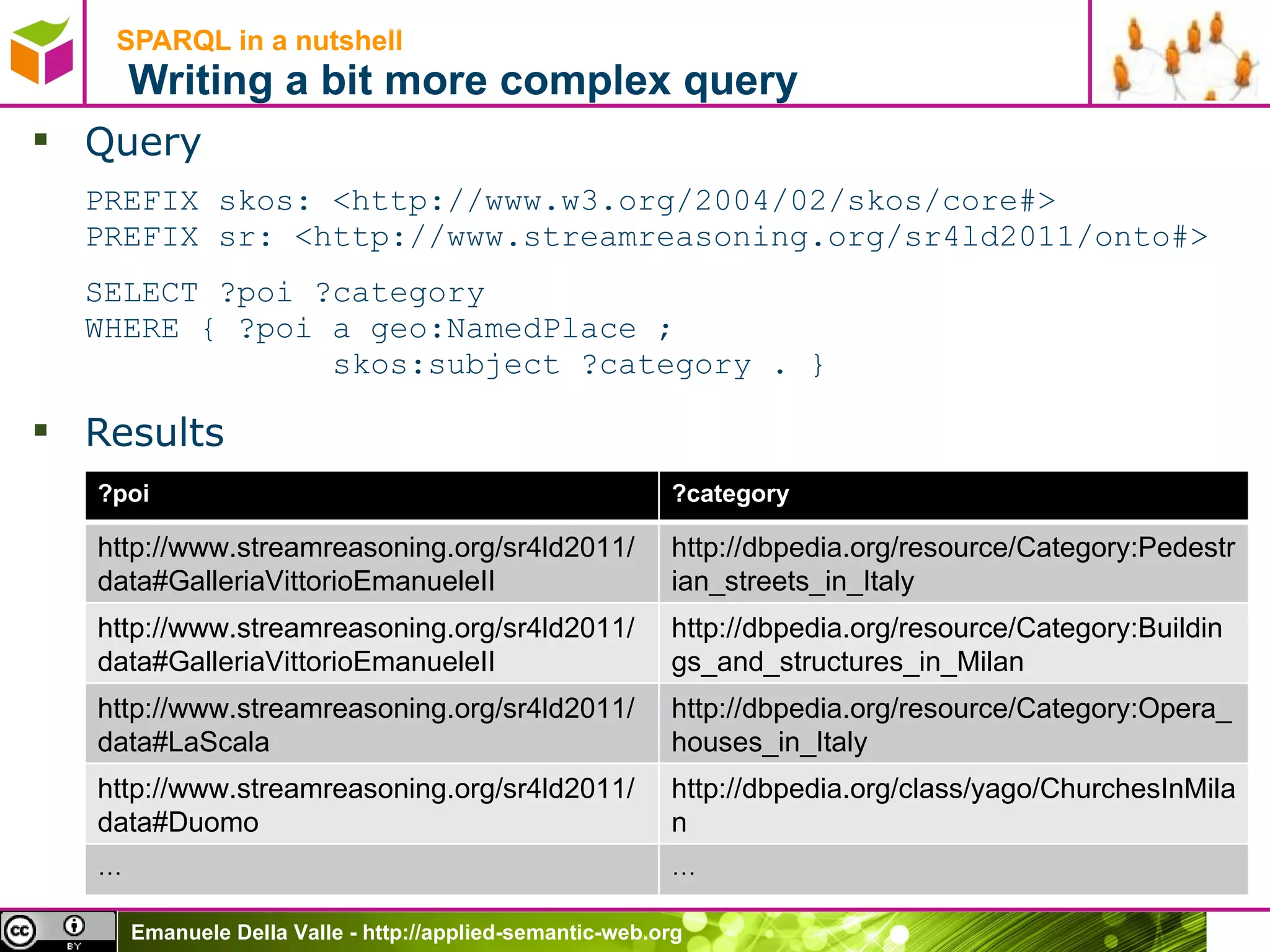
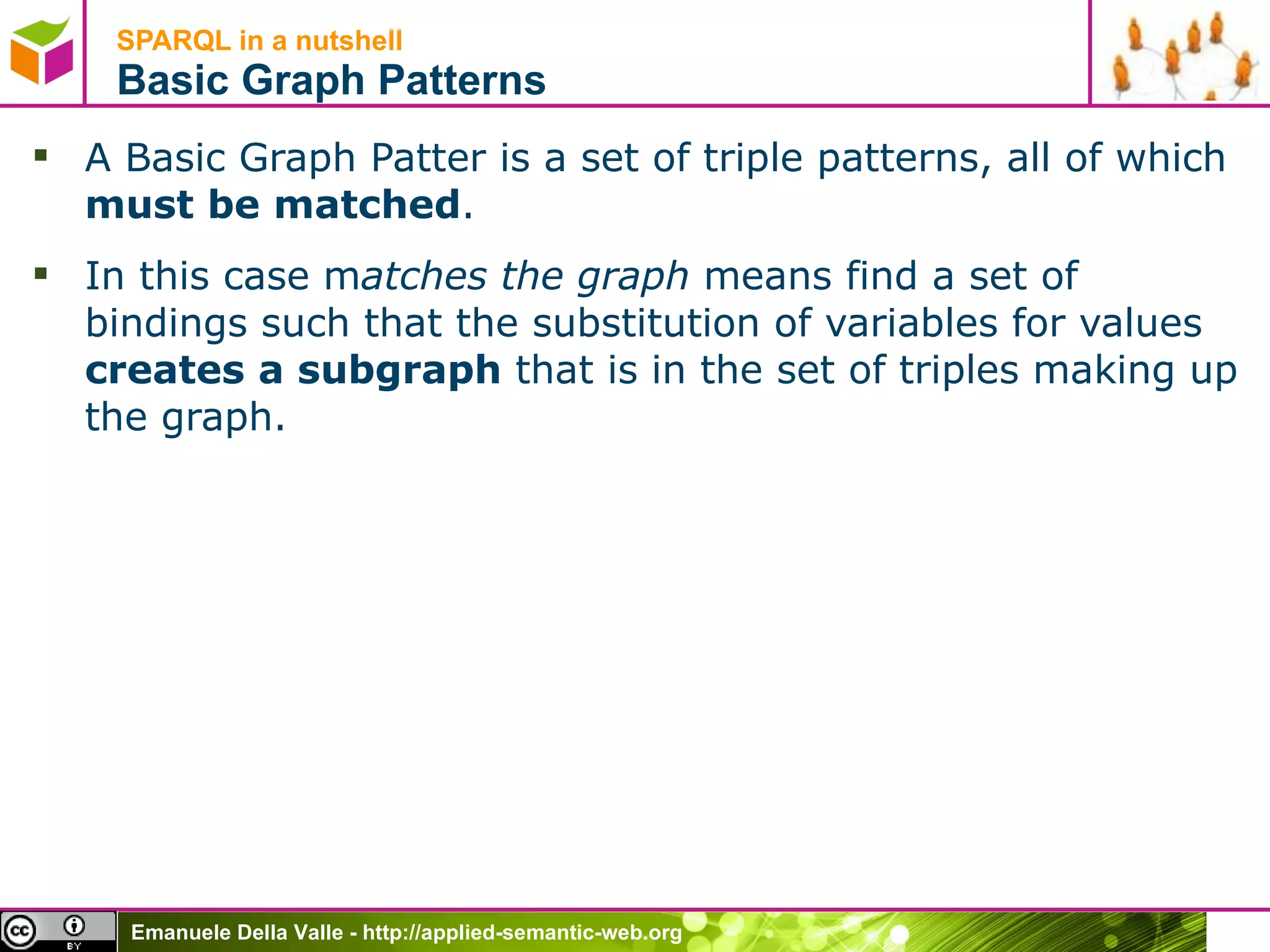
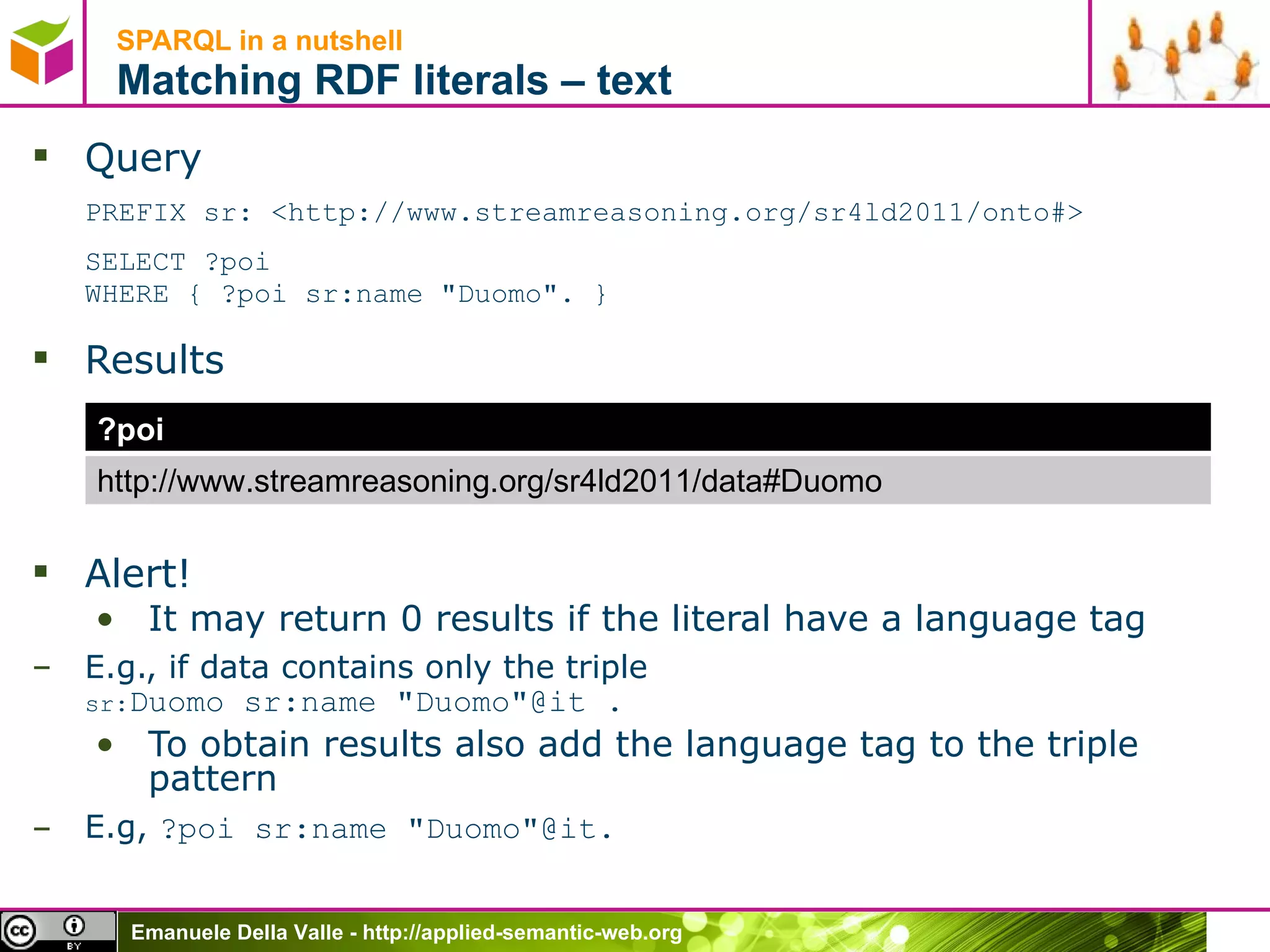
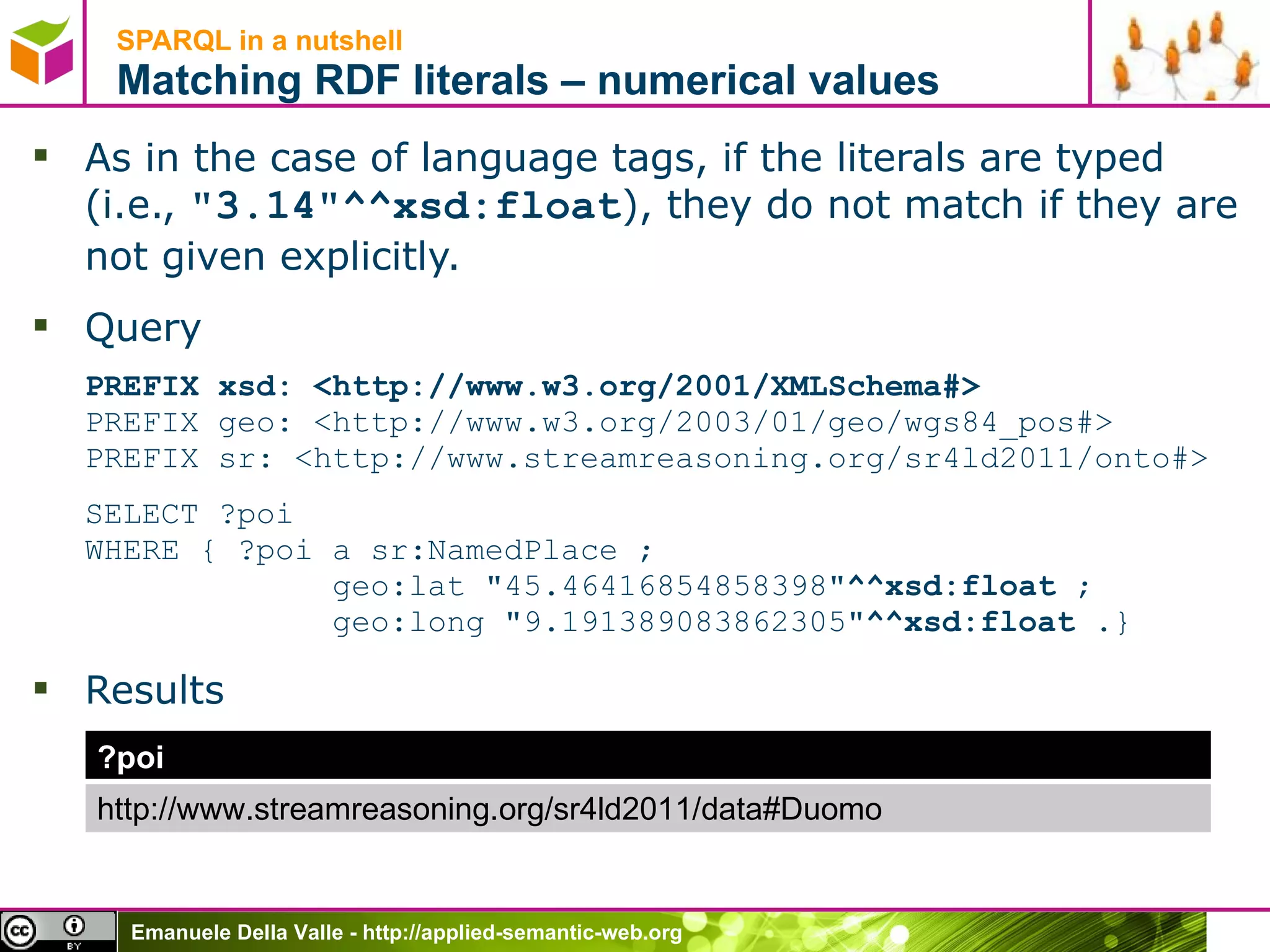
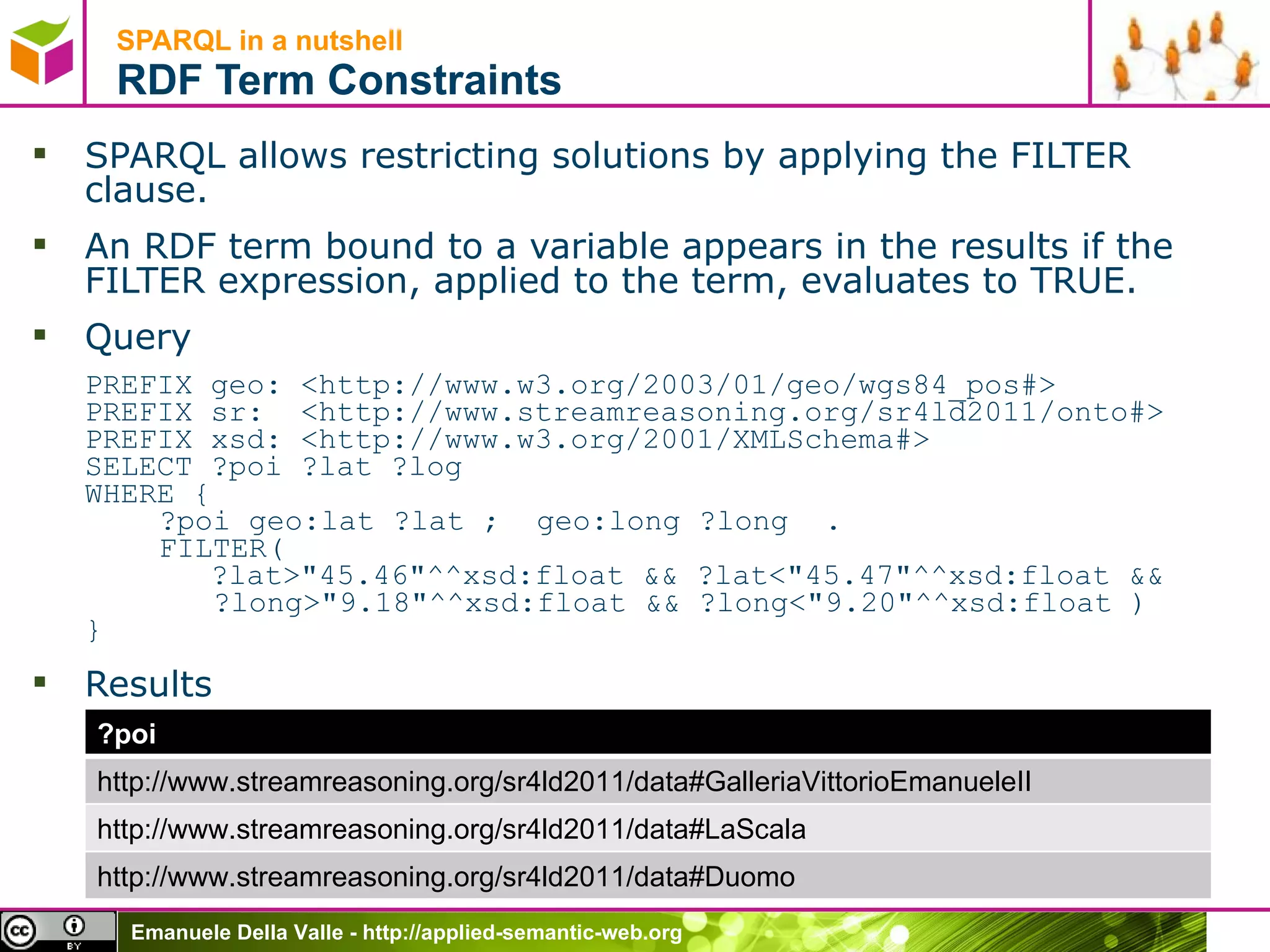
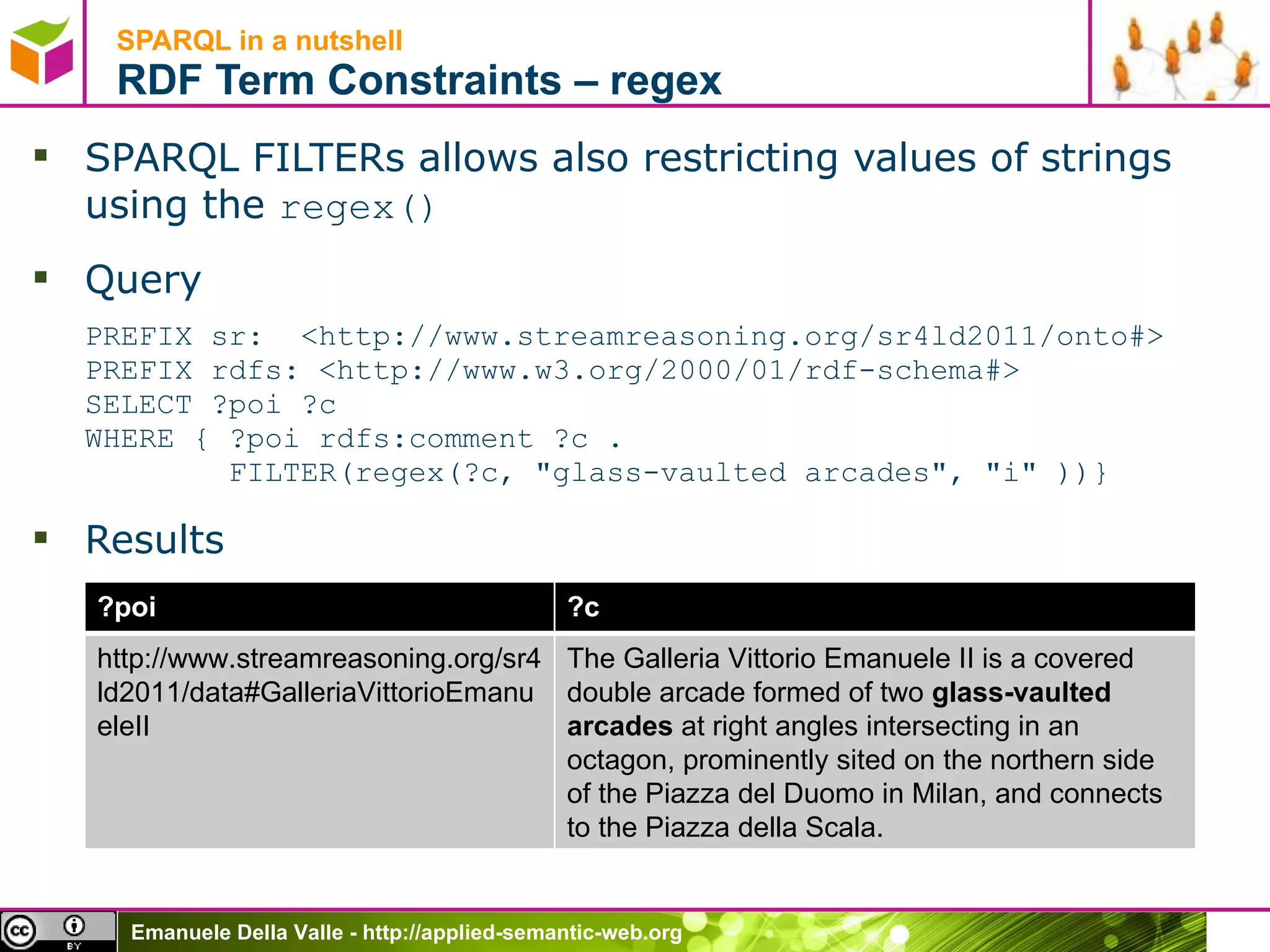
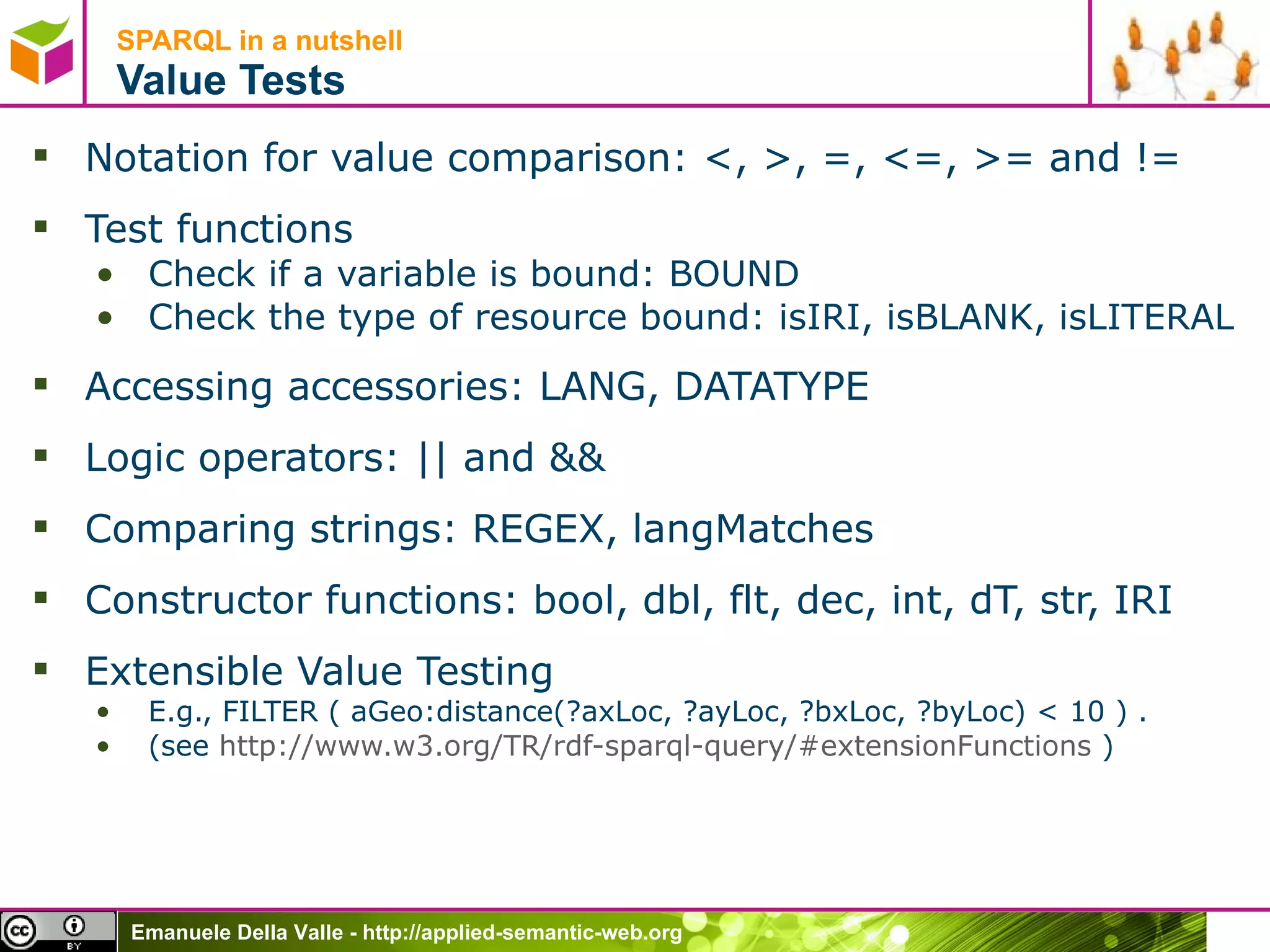
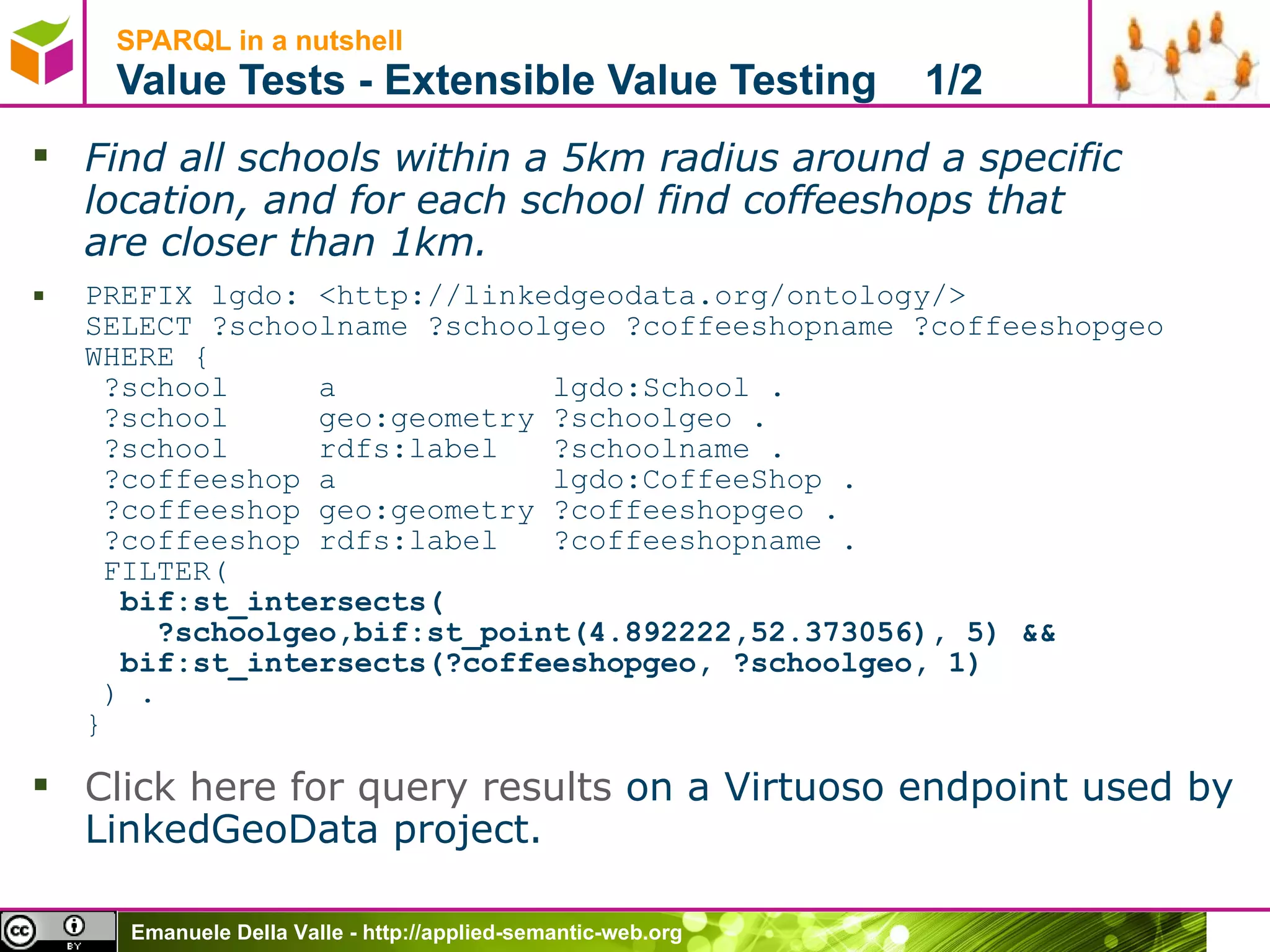
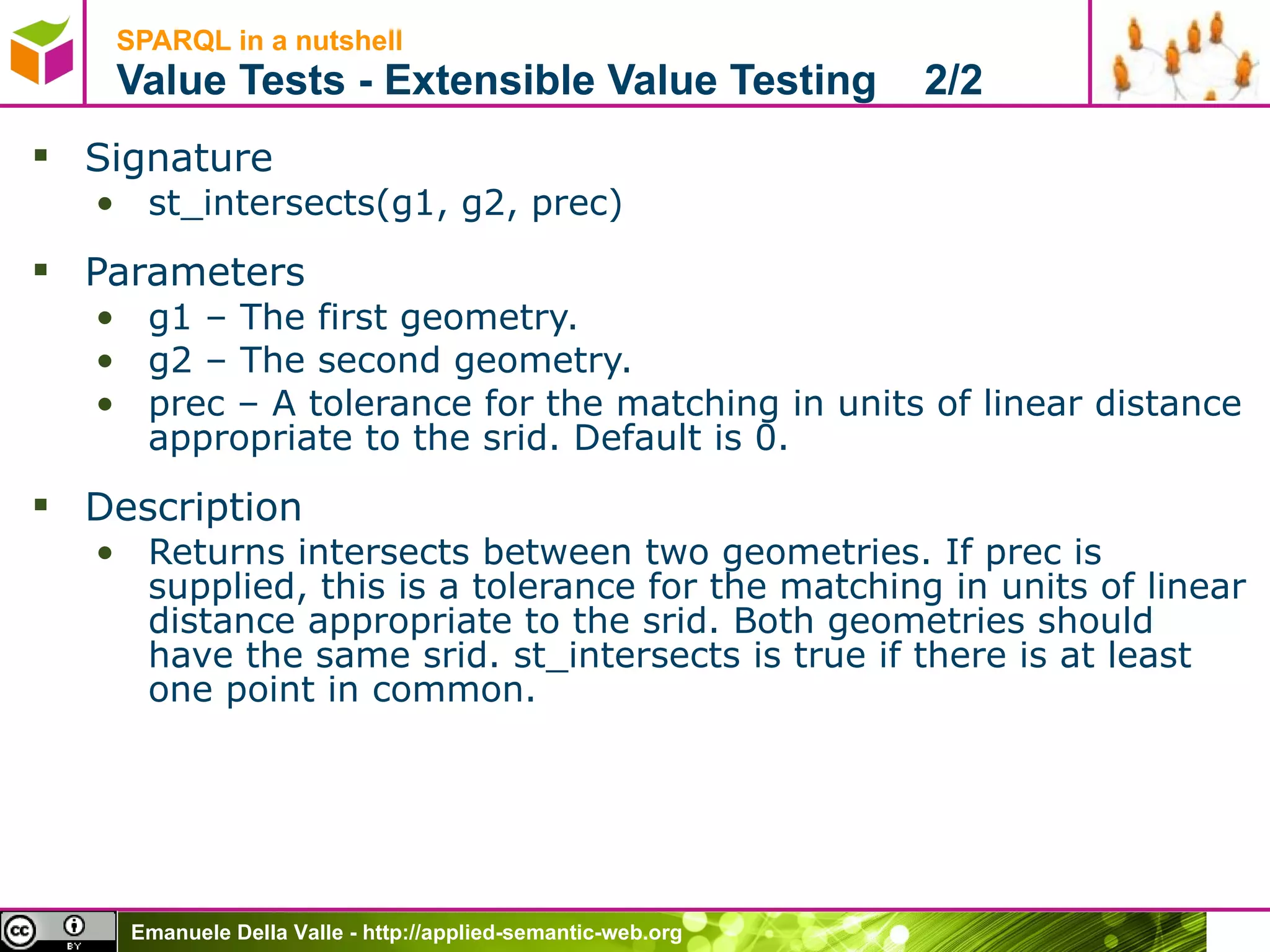
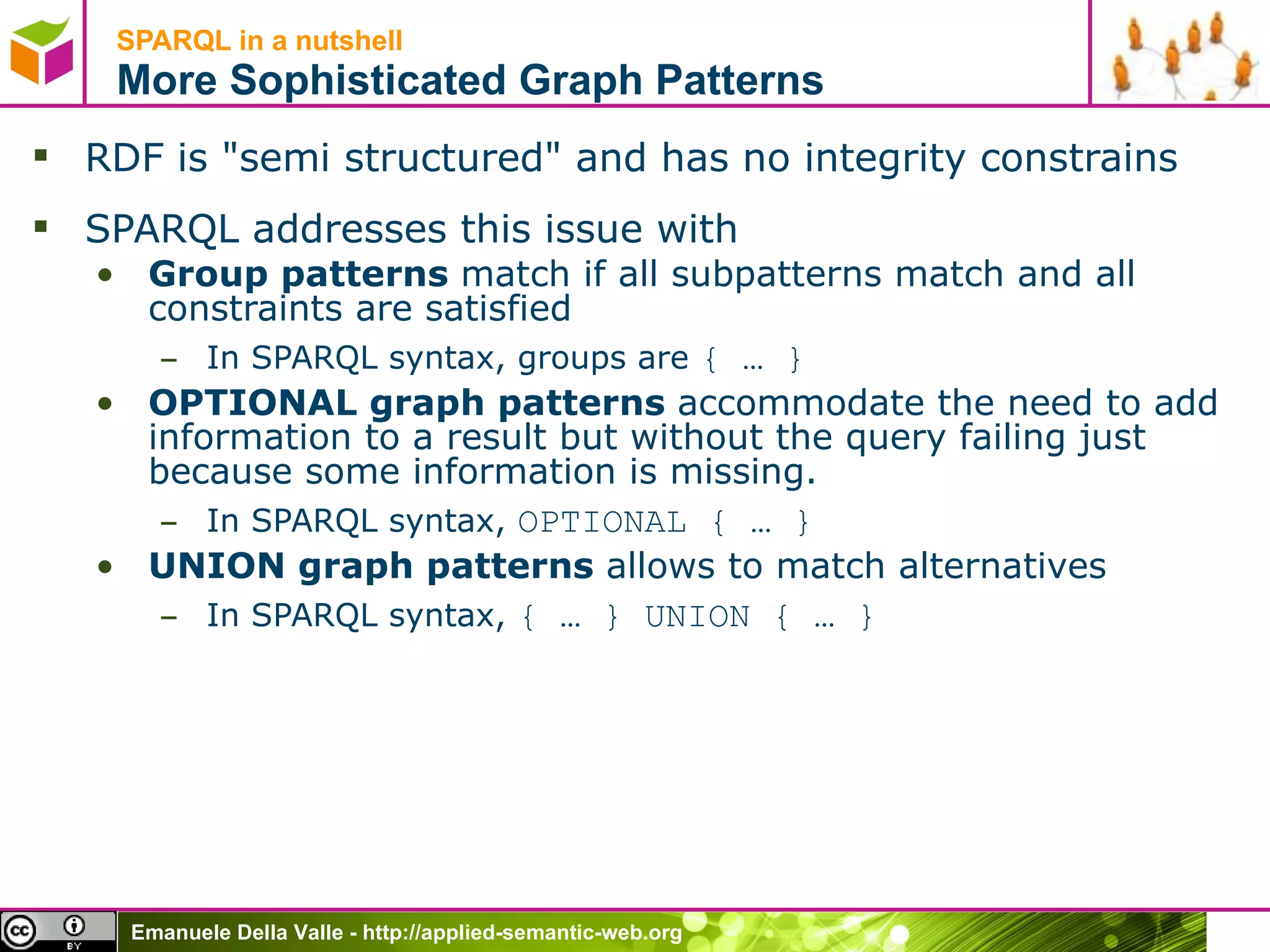
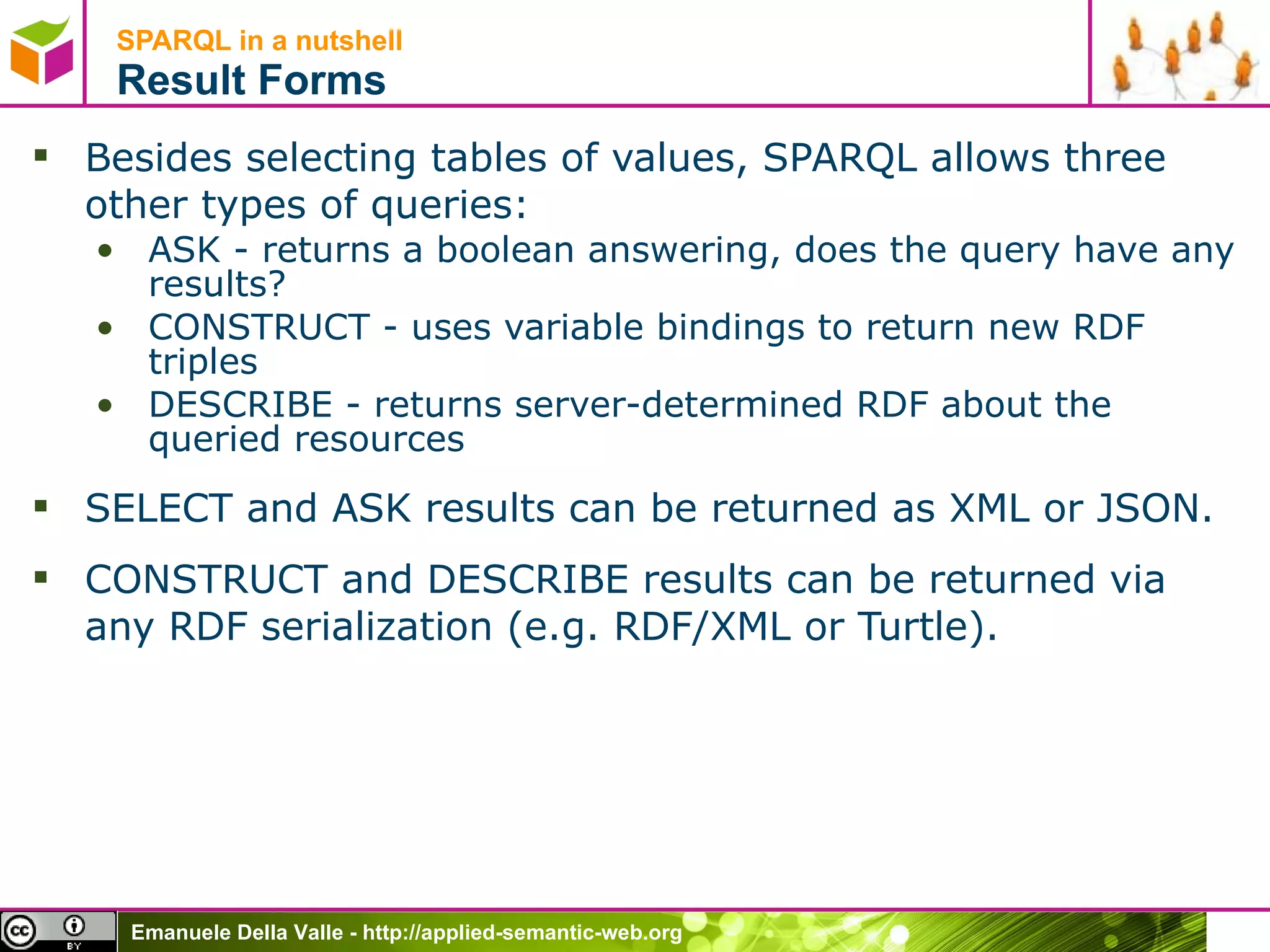
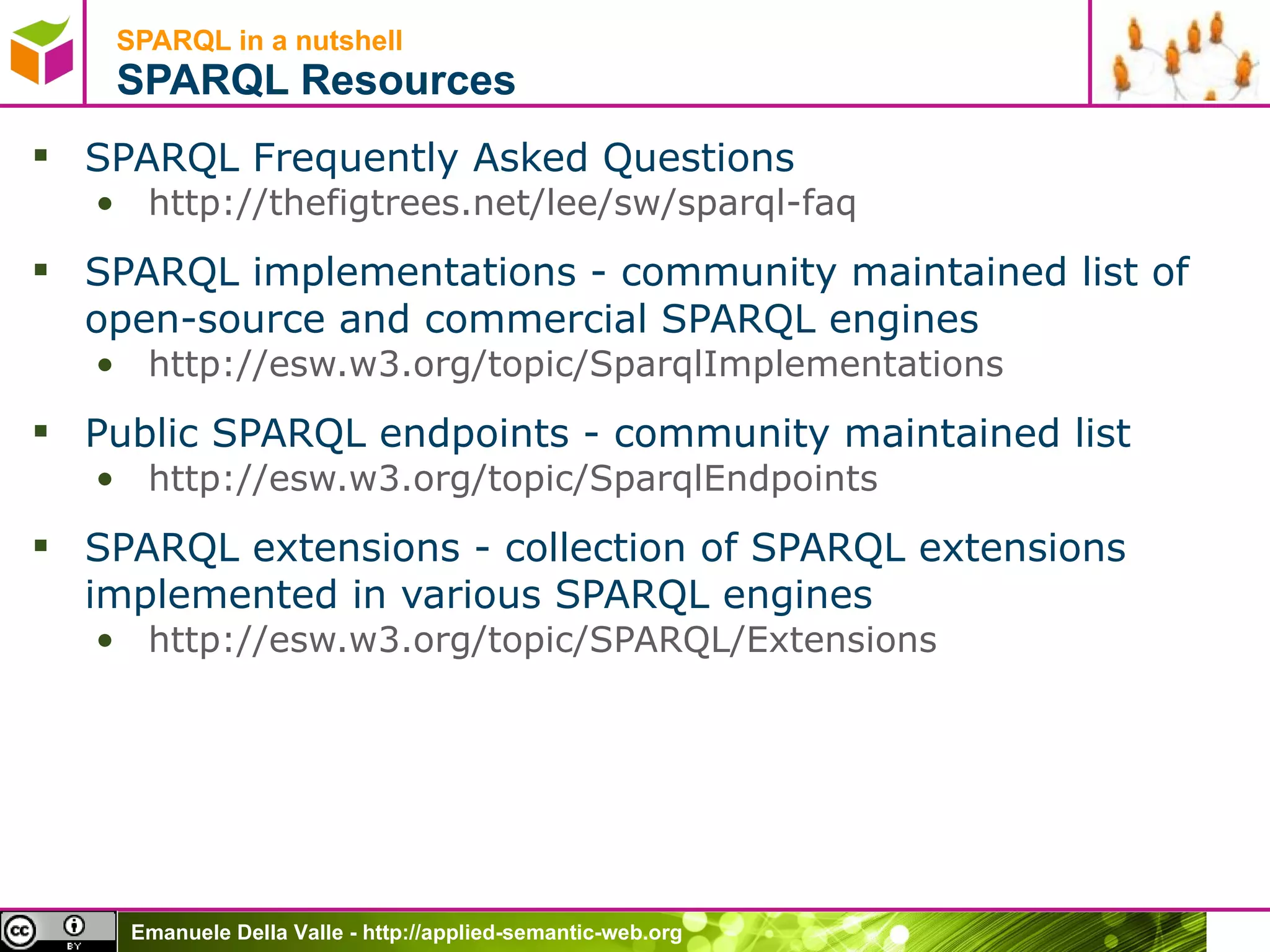
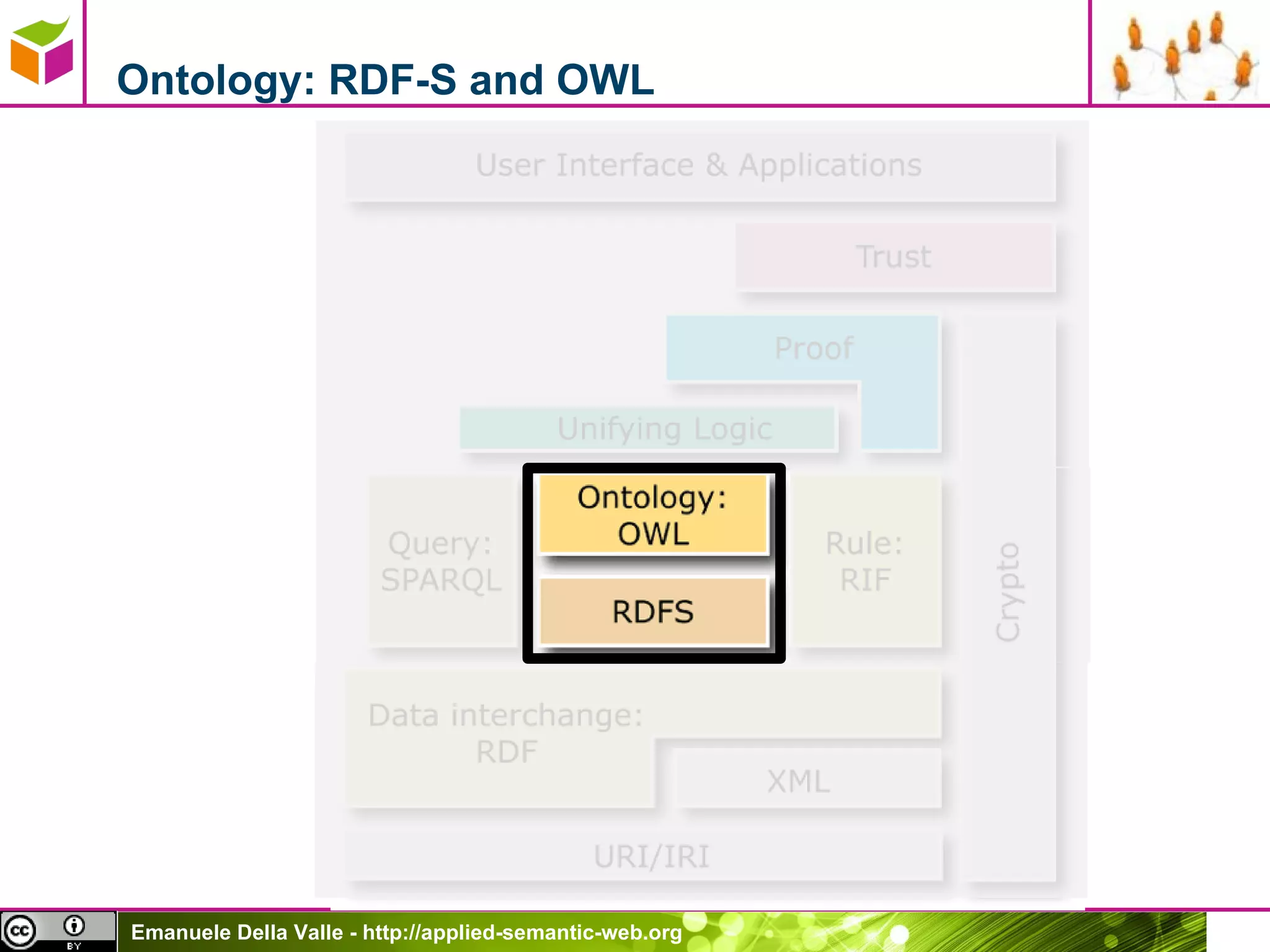
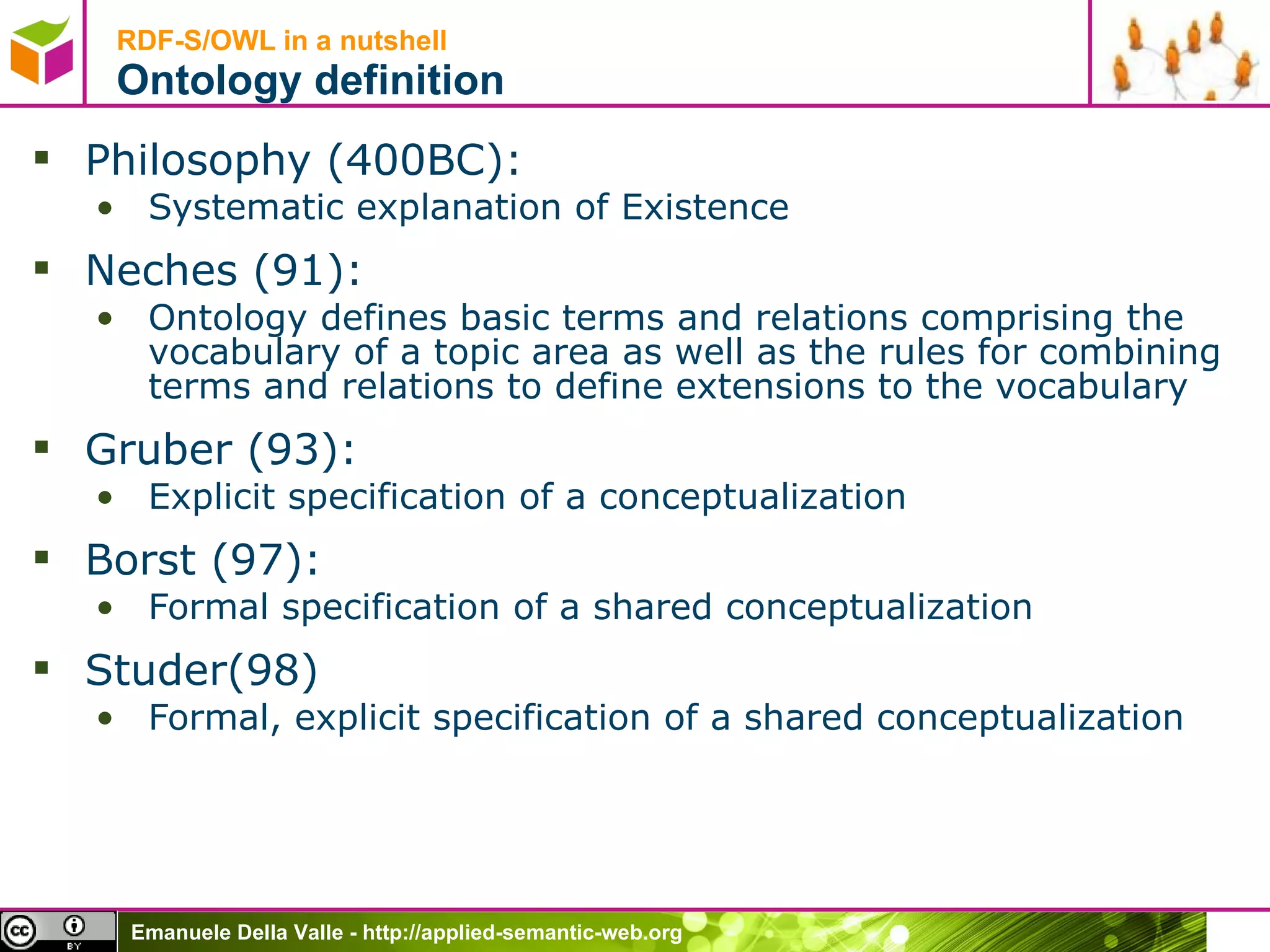
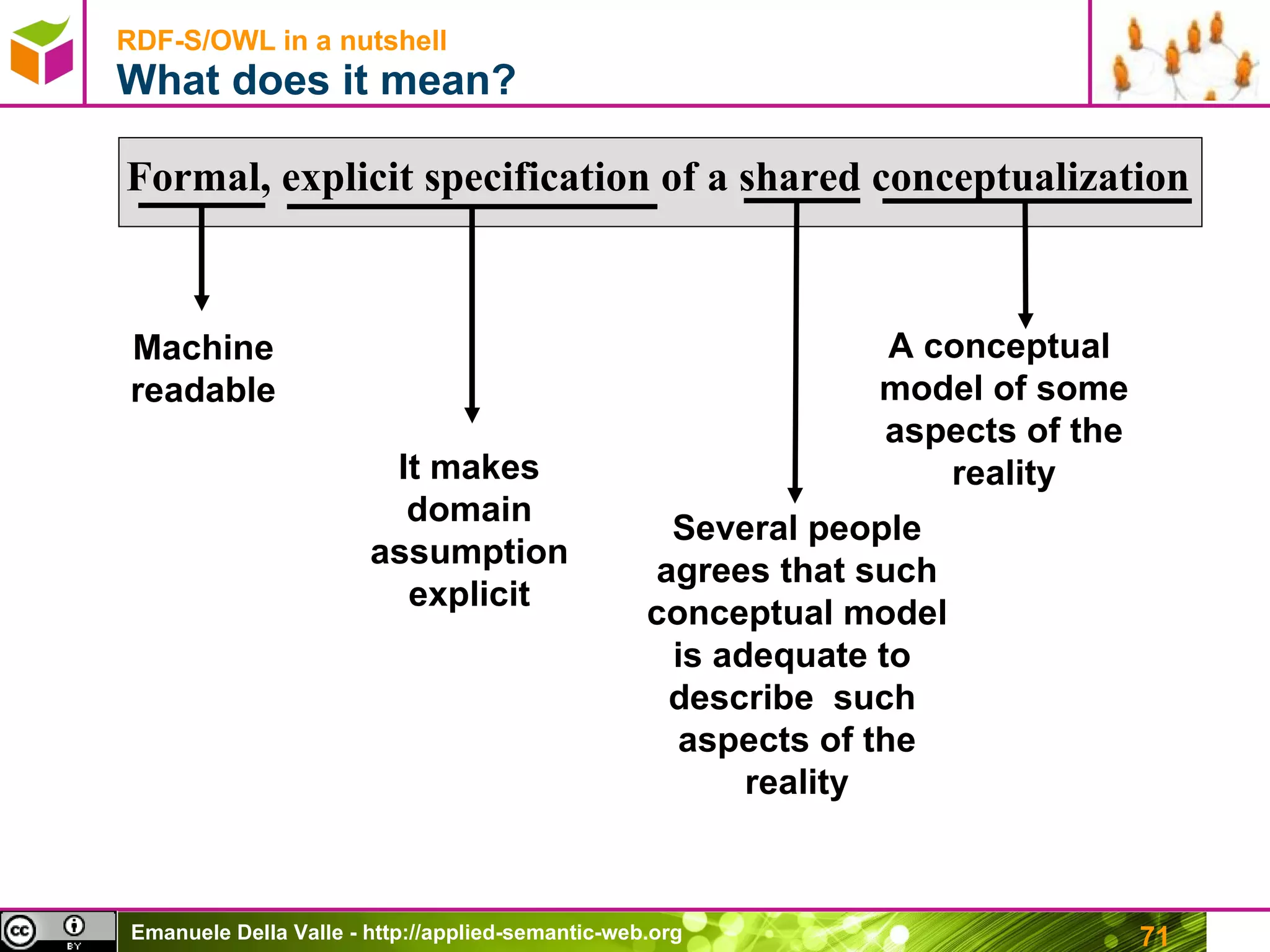
![RDF-S/OWL in a nutshell What is an Ontology? A model of (some aspect of) the world Introduces vocabulary relevant to domain e.g., anatomy Specifies meaning (semantics) of terms Heart is a muscular organ that is part of the circulatory system Formalised using suitable logic ∀ x.[ Heart (x)-> MuscolarOrgan (x)∧ ∃y.[ isPartOf (x,y )∧ CirculatorySystem (y)]] Shared among multiple people organizations](https://image.slidesharecdn.com/semanticweb4gis-110504153905-phpapp02/75/Introduction-to-Semantic-Web-for-GIS-Practitioners-72-2048.jpg)
![RDF-S/OWL in a nutshell How much explicit shall the specification be ? “ A little semantics, goes a long way” [James Hendler, 2001] Advanced](https://image.slidesharecdn.com/semanticweb4gis-110504153905-phpapp02/75/Introduction-to-Semantic-Web-for-GIS-Practitioners-73-2048.jpg)
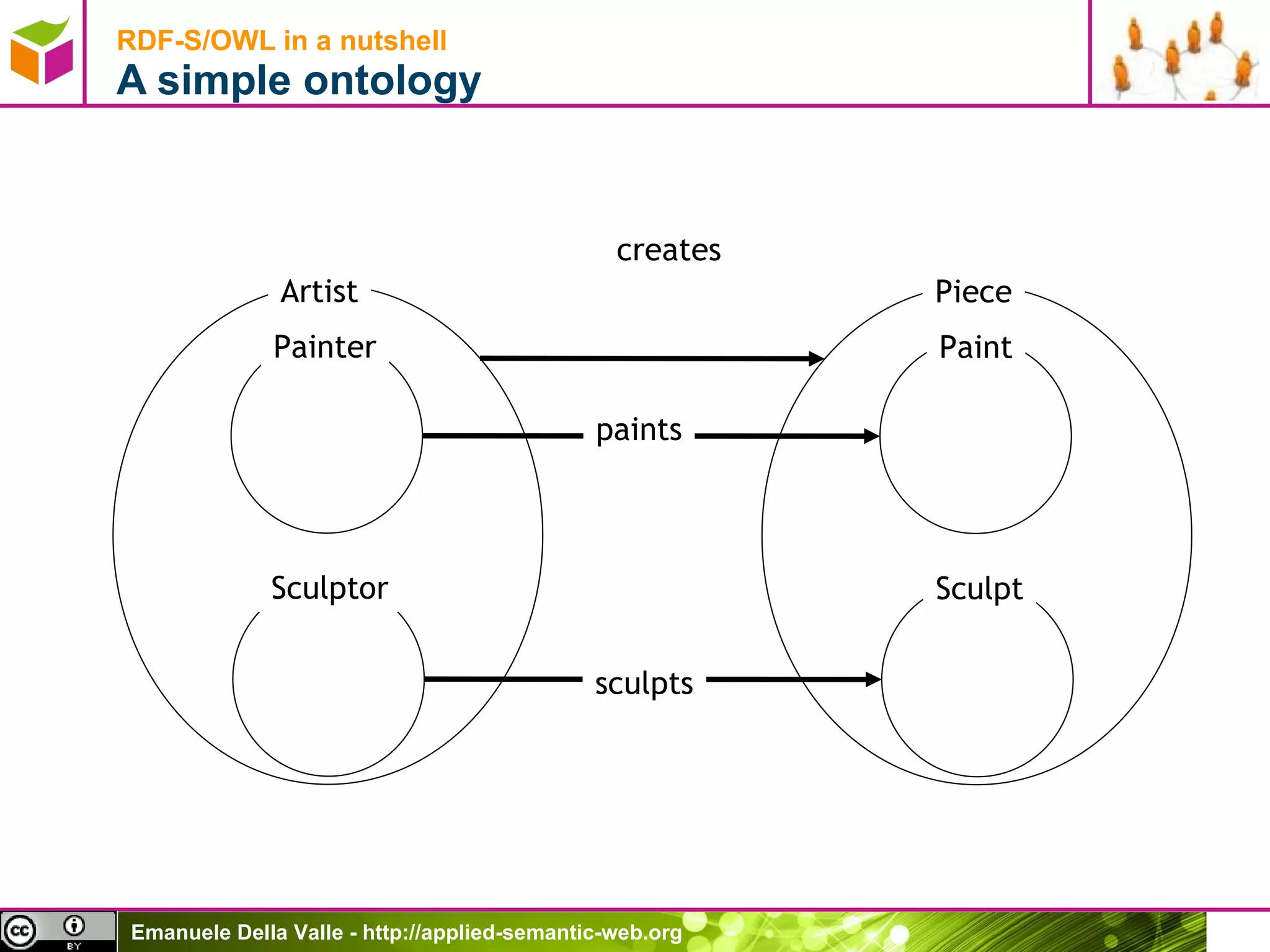
![RDF-S/OWL in a nutshell Specifying classes, sub-classes and instances Creating a class RDFS: Artist rdf:type rdfs:Class . FOL: x Artist(x) Creating a subclass RDFS: Painter rdfs:subClassOf Artist . RDFS: Sculptor rdfs:subClassOf Artist . FOL: x [Painter(x) Sculptor(x) Artist(x)] Creating an instance RDFS: Rodin rdf:type Sculptor . FOL: Sculptor(Rodin) Artist Painter Sculptor Rodin](https://image.slidesharecdn.com/semanticweb4gis-110504153905-phpapp02/75/Introduction-to-Semantic-Web-for-GIS-Practitioners-75-2048.jpg)
![Creating a property RDFS: creates rdf:type rdf:Property . FOL: x y Creates(x,y) Using a property RDFS: Rodin creates TheKiss . FOL: Creates(Rodin, TheKiss) Creating subproperties RDFS: paints rdfs:subPropertyOf creates . FOL: x y [Paints(x,y) Creates(x,y)] RDFS: sculpts rdfs:subPropertyOf creates . FOL: x y [Sculpts(x,y) Creates(x,y)] RDF-S/OWL in a nutshell Specifying properties and sub-properties - - creates paints](https://image.slidesharecdn.com/semanticweb4gis-110504153905-phpapp02/75/Introduction-to-Semantic-Web-for-GIS-Practitioners-76-2048.jpg)
![RDF-S/OWL in a nutshell Specifying domain/range constrains Checking which classes and properties can be use together RDFS: creates rdfs:domain Artist . creates rdfs:range Piece . paints rdfs:domain Painter . paints rdfs:range Paint . sculpts rdfs:domain Sculptor . sculpts rdfs:range Sculpt . FOL: x y [Creates(x,y) Artist(x) Piece(y)] x y [Paints(x,y) Painter(x) Paint(y)] x y [Sculpts(x,y) Sculptor(x) Sculpt(y)]](https://image.slidesharecdn.com/semanticweb4gis-110504153905-phpapp02/75/Introduction-to-Semantic-Web-for-GIS-Practitioners-77-2048.jpg)
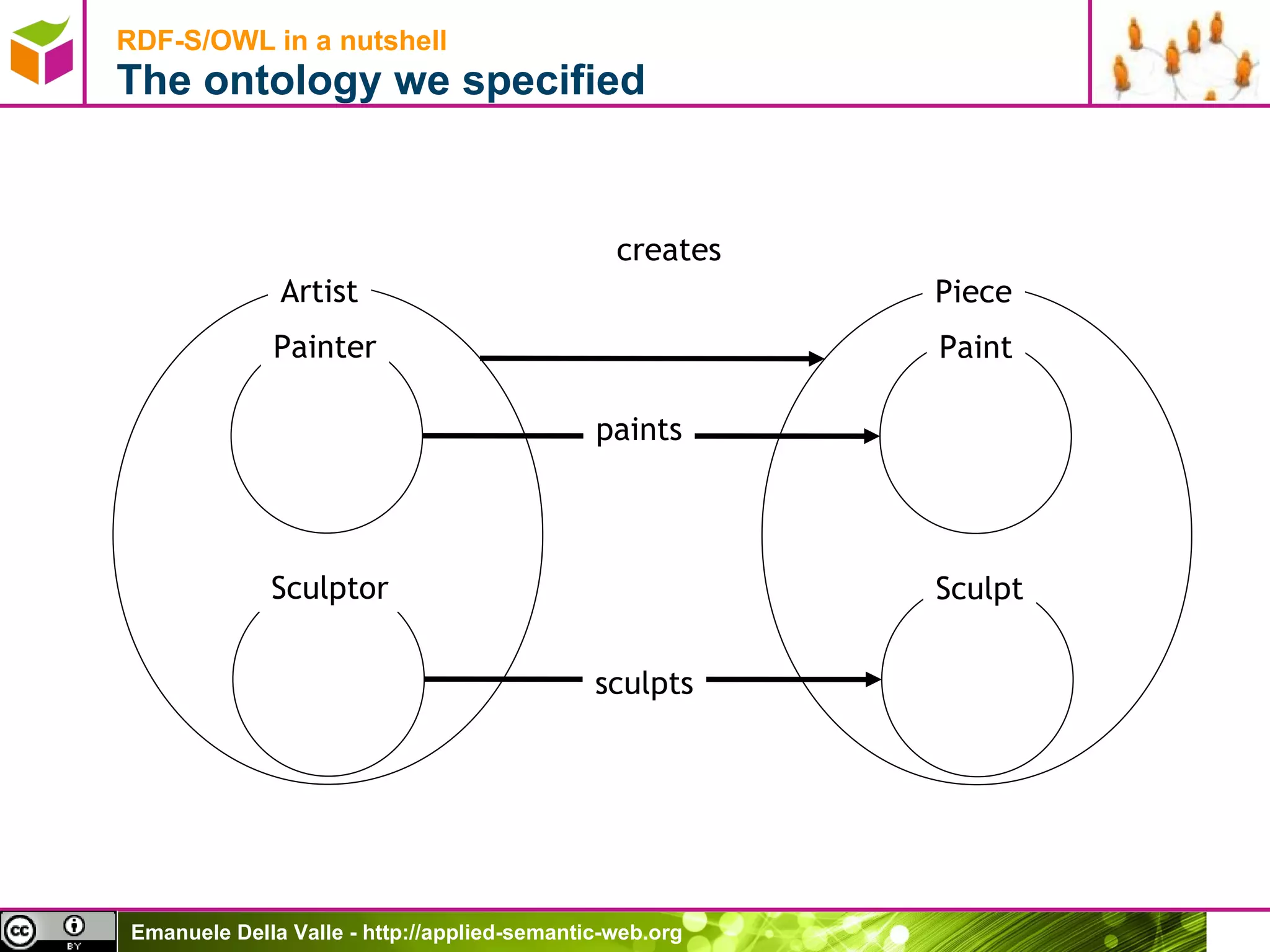
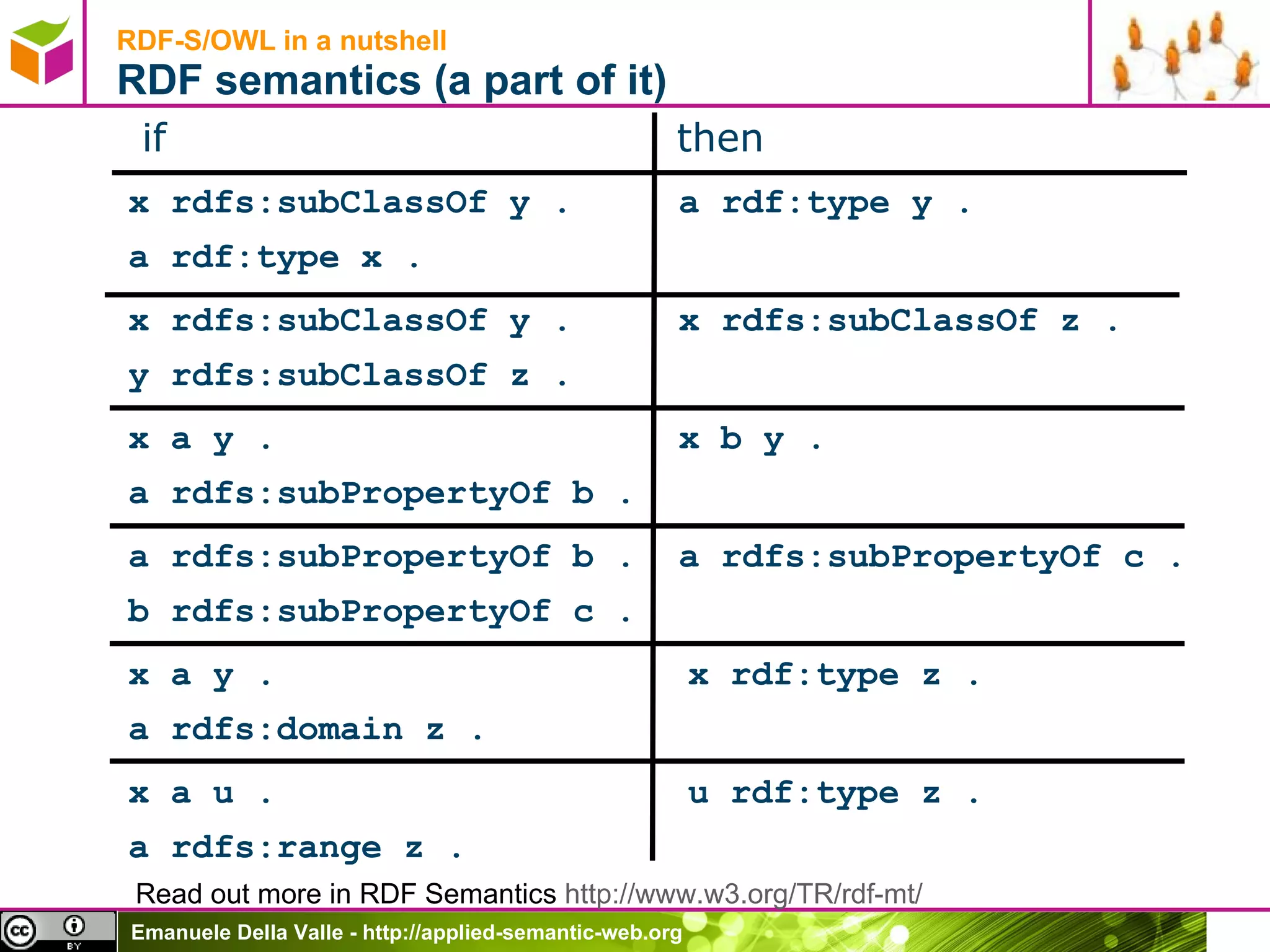
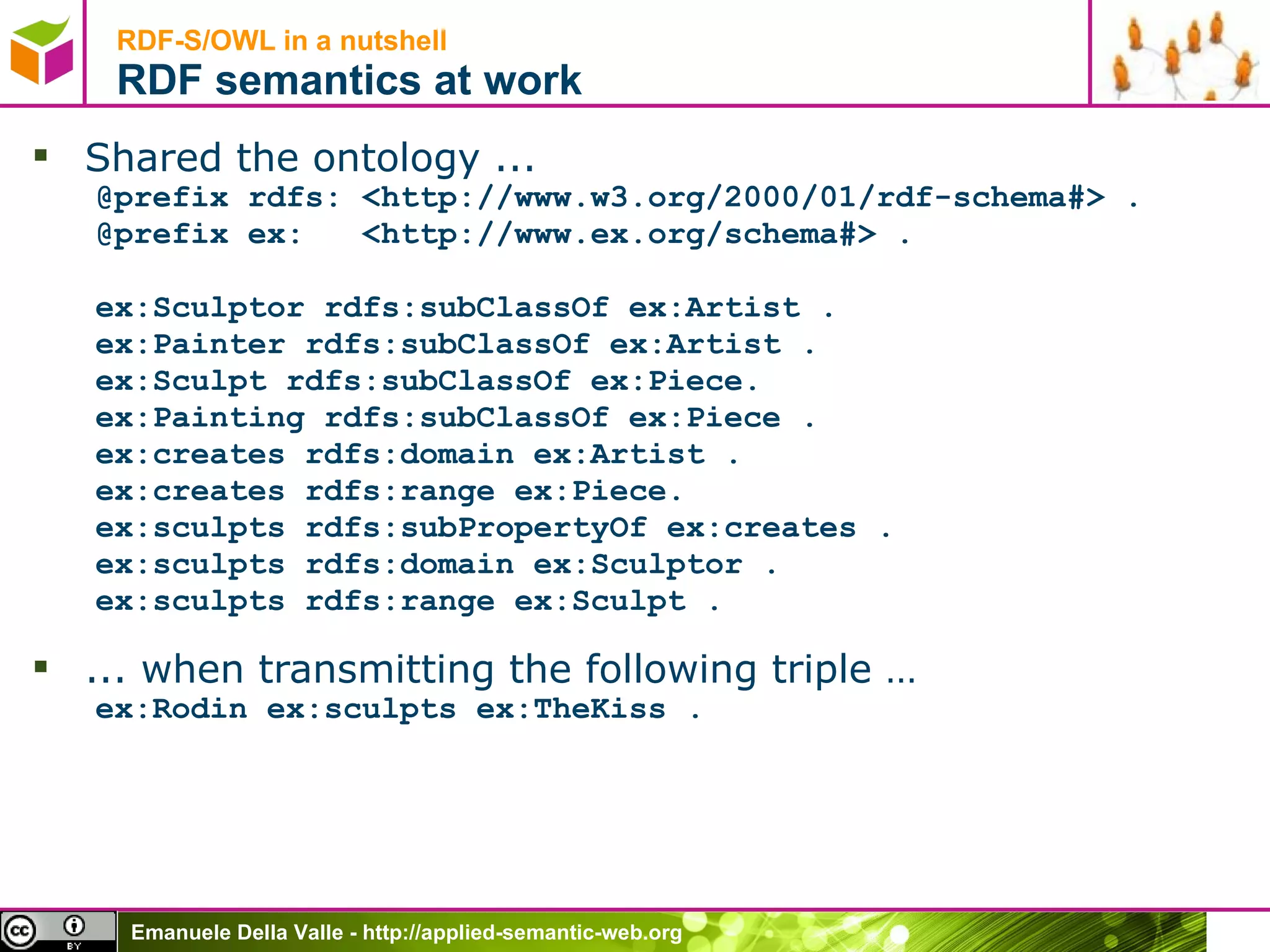
![RDF-S/OWL in a nutshell Without Inference A recipient, that only understands XML syntax, receiving <RDF> <Description about="Rodin"> <sculpts resource="TheKiss"/> </Description> </RDF> can answer the following queries What does Rodin sculpt? RDF/Description[@about='Rodin']/sculpts/@resource Who does sculpt TheKiss? RDF/Description[sculpts/@resource='TheKiss']/@about Try out your self at http://www.mizar.dk/ XPath / but it cannot answer Who is Rodin? What is TheKiss? Is there any Sculptor/Scupts? Is there any Artist/Piece?](https://image.slidesharecdn.com/semanticweb4gis-110504153905-phpapp02/75/Introduction-to-Semantic-Web-for-GIS-Practitioners-81-2048.jpg)
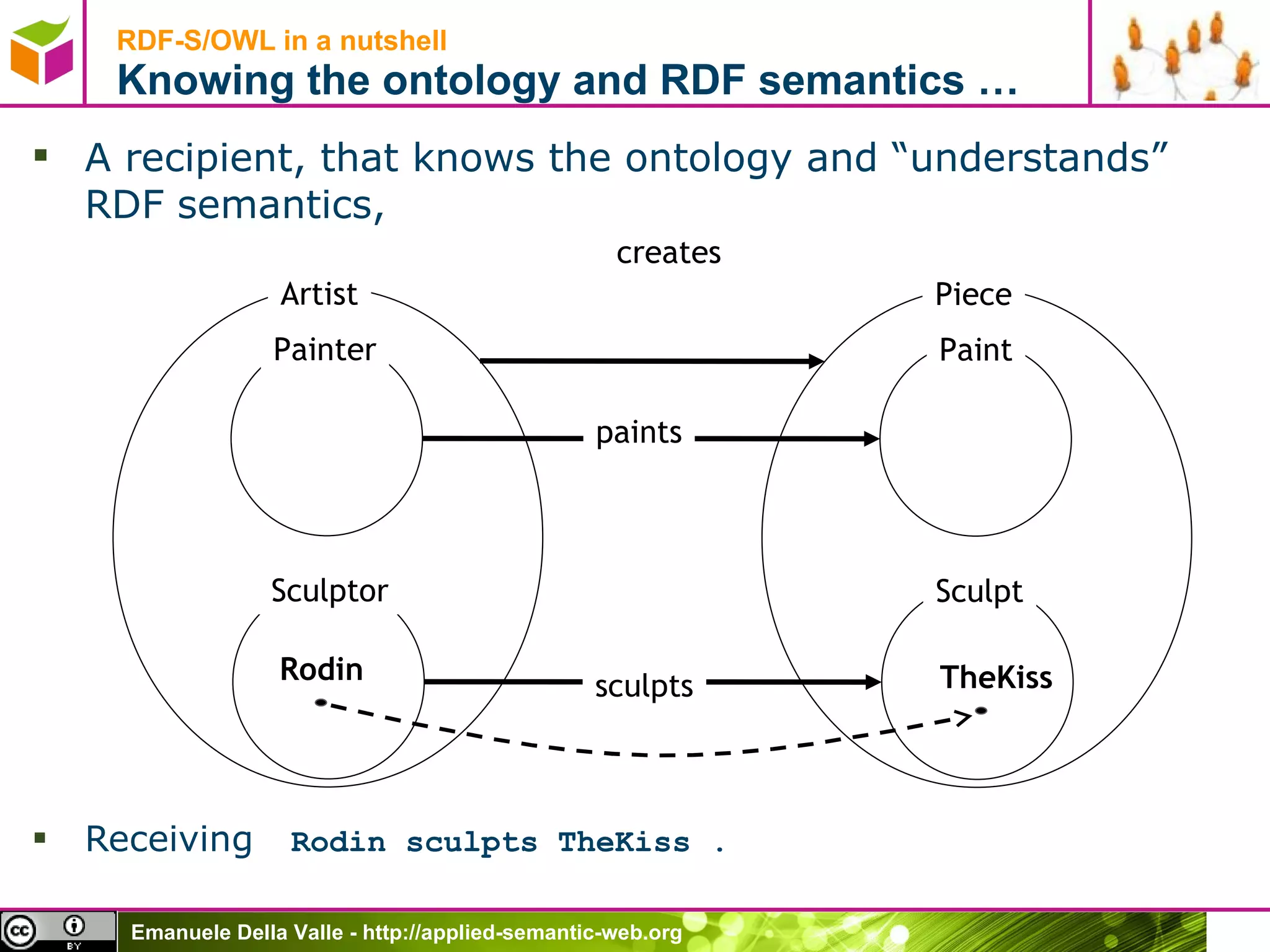
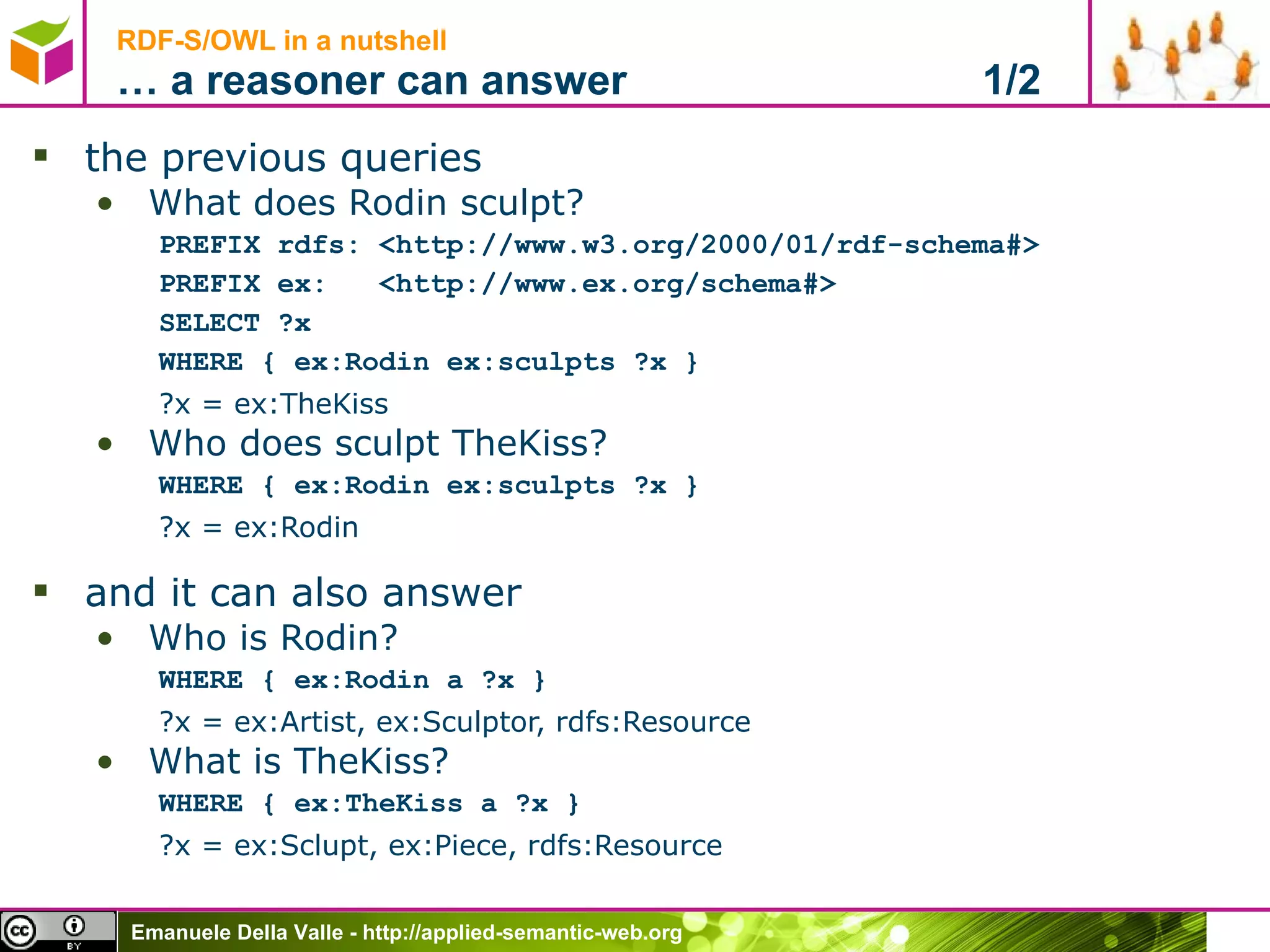
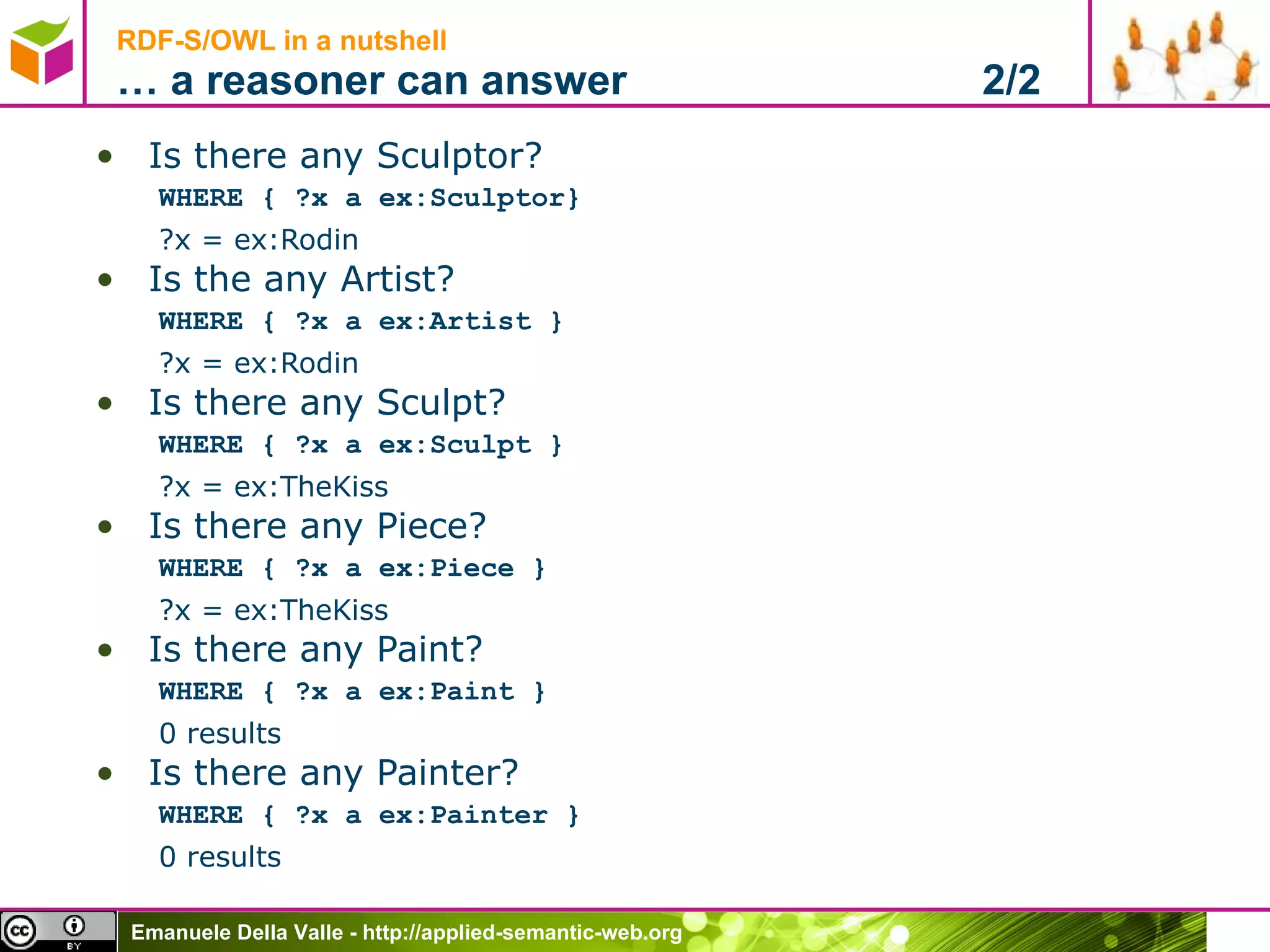
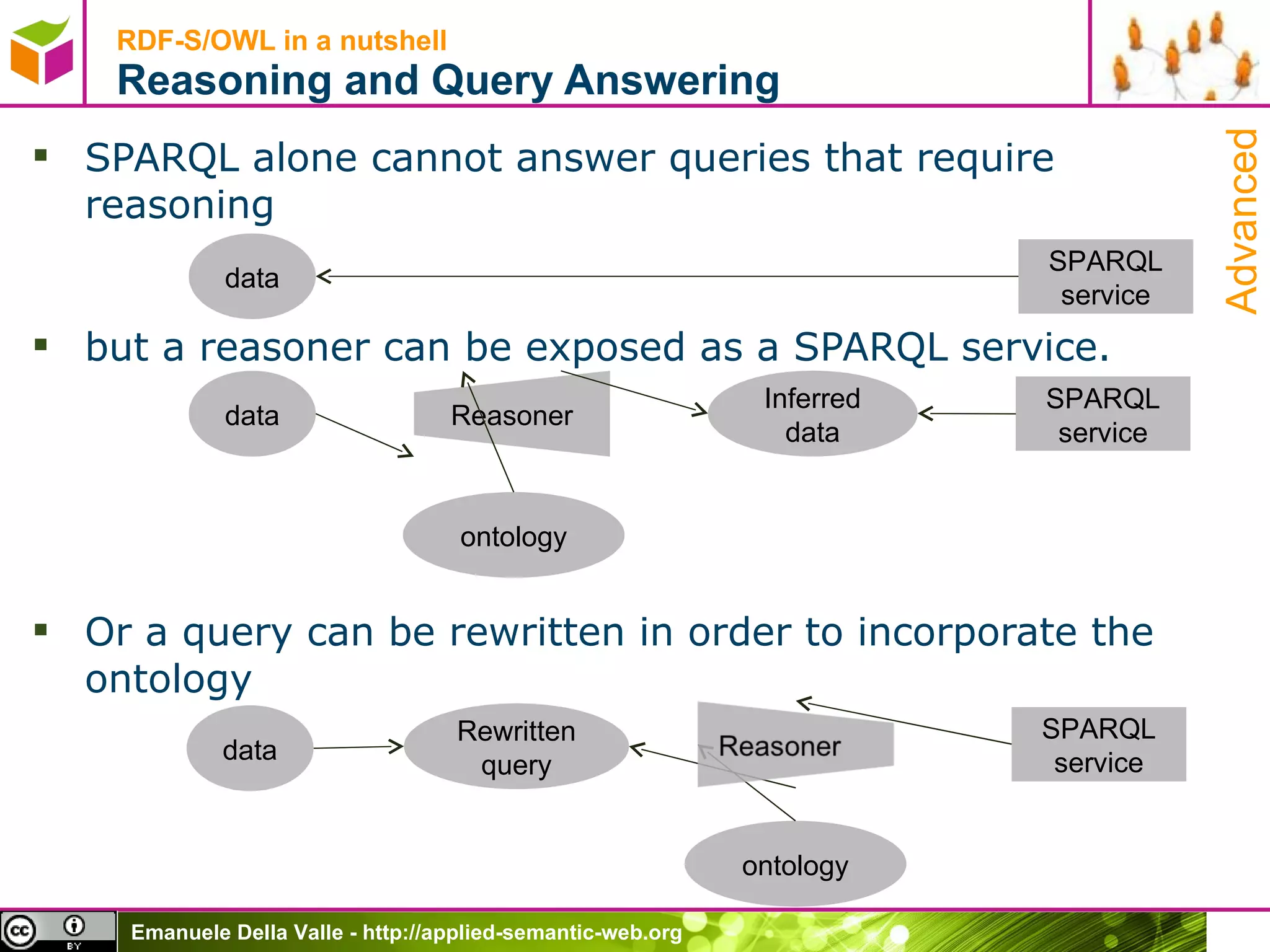
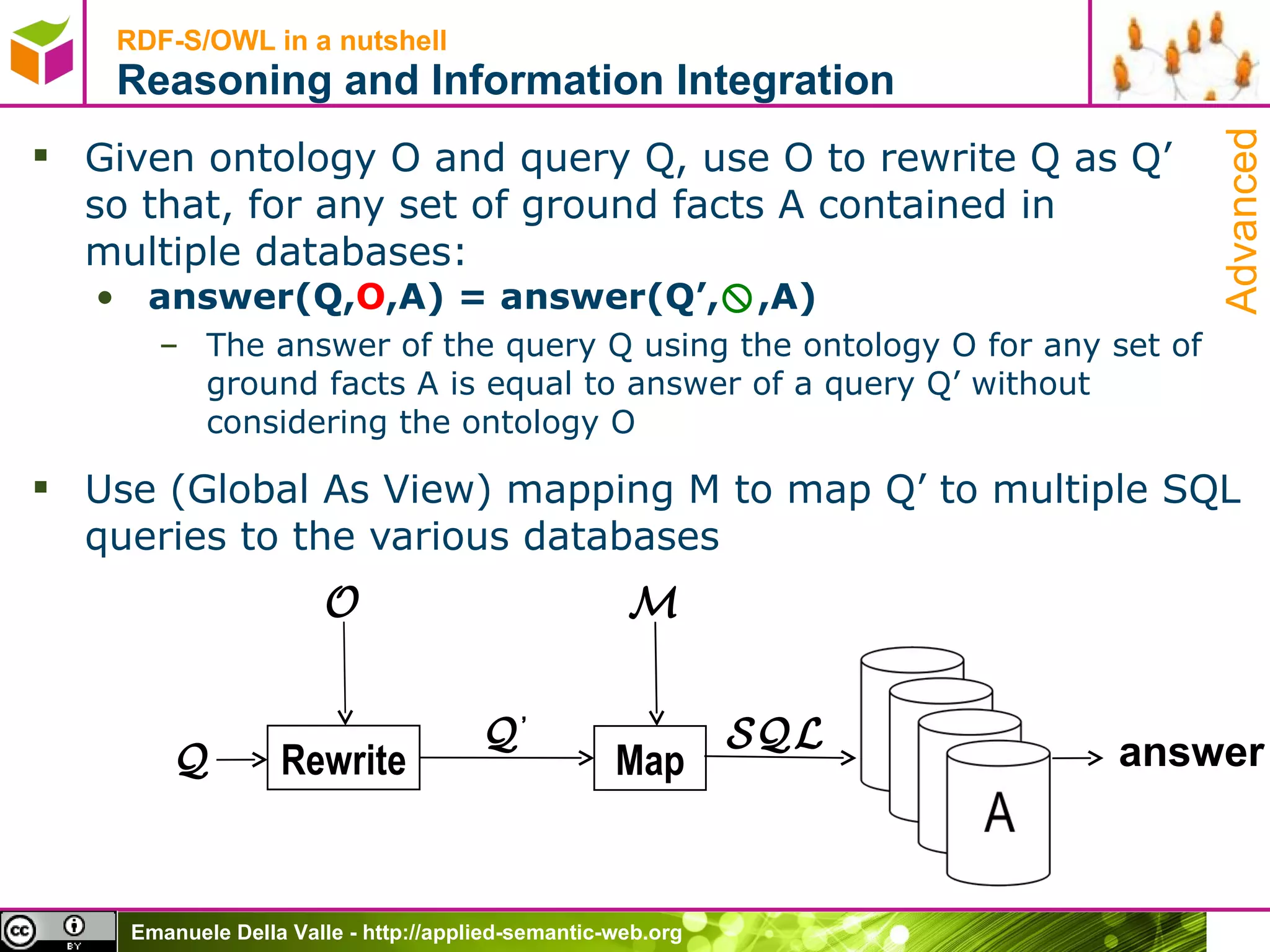

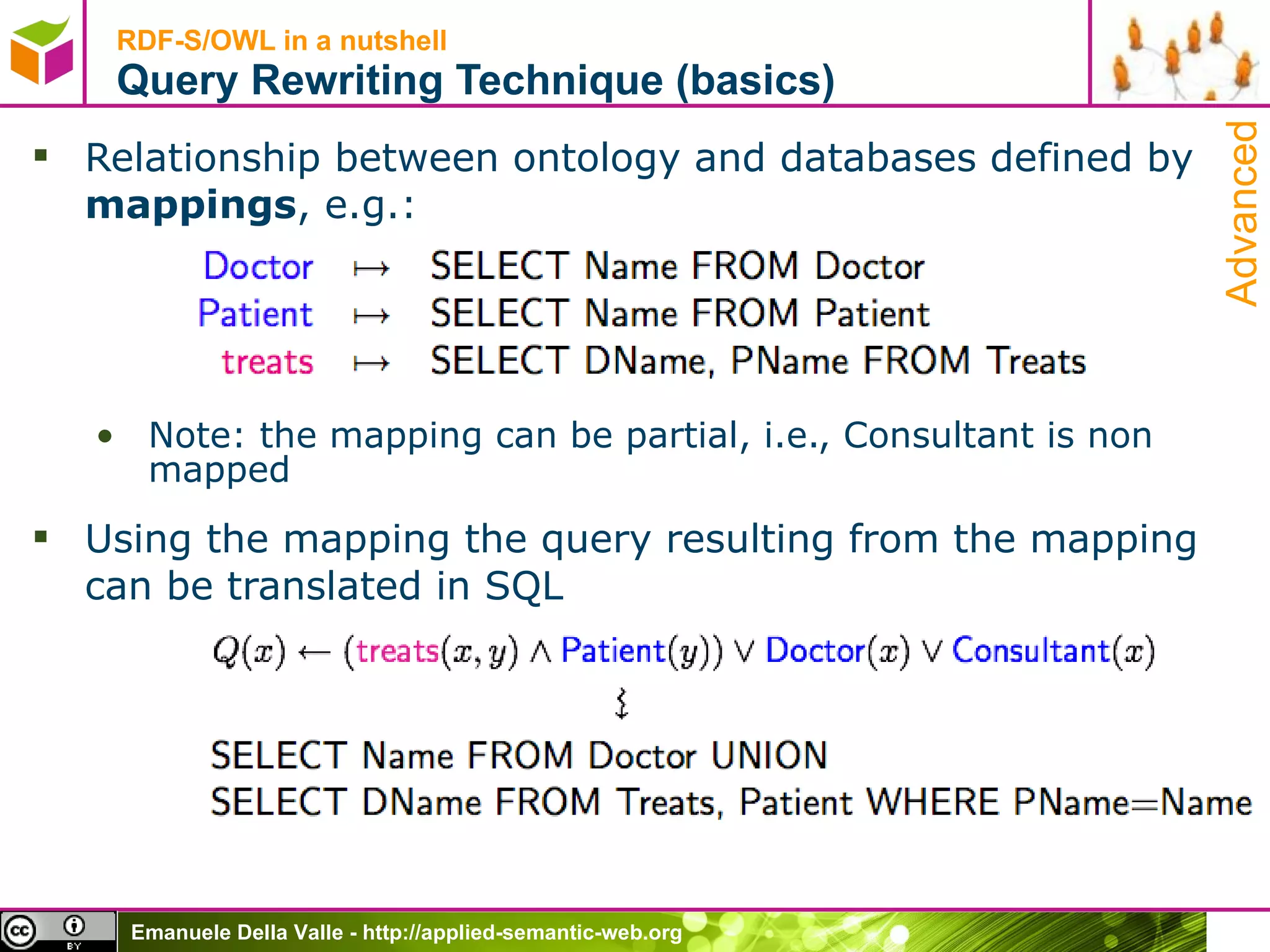
![RDF-S/OWL in a nutshell More expressive power 1/3 RDFS is a light ontological language that allows for defining simple vocabularies. One may want also express Cardinality constrains (max, min, exactly) for properties usage Es. a Polygon has 3 or more edges x [Polygon(x) ≥3y Edge(y) Forms(y,x) ] Property types transitive e.g. hasAncestor is a transitive property: if A hasAncestor B and B hasAncestor C , then A hasAncestor C . x y z [HasAncestor(x,y) HasAncestor(y,z) HasAncestor(x,z) ] inverse e.g. sclupts has isSculptedBy as inverse property: if A sclupts B then B isSculptedBy A x y [Sculpts(x,y) IsSculptedBy(y,x) ] Advanced](https://image.slidesharecdn.com/semanticweb4gis-110504153905-phpapp02/75/Introduction-to-Semantic-Web-for-GIS-Practitioners-89-2048.jpg)
![RDF-S/OWL in a nutshell More expressive power 2/3 simmetric e.g. isCloseTo is a simmetric property: if A isCloseTo B then B isCloseTo A x y [IsCloseTo(x,y) IsCloseTo(y,x) ] Restrictions of usage for a specific property All values of property must be of a certain kind e.g. a D.O.C. Wine can be only produced by a Certified Wienery x y [DOCWine(x) Produces(x,y) CertifiedWienery(y)] Some values of property must be of a certain kind e.g. a Famous Painter must have painted some Famous Painting x [FamousPainter(x) y FamousPaint(y) IsPaintedBy(y,x)] A class is defined combining other classes (union, intersection, negation, ...) A white wine is a Wine and its color is “white” x [Wine(x) White(x)] Advanced](https://image.slidesharecdn.com/semanticweb4gis-110504153905-phpapp02/75/Introduction-to-Semantic-Web-for-GIS-Practitioners-90-2048.jpg)
![RDF-S/OWL in a nutshell More expressive power 3/3 Two instances refers to the same real object “ The Boss” and “Bruce Springsteen” are two names for the same person TheBoss = BruceSpringsteen Two classes refers to the same set “ Painters” in english and “Pittori” in italian x [Painter(x) Pittore(x)] Two properties refers to the same binary relationship “ Paints” in english and “Dipinge” in italian x y [Paints(x,y) Dipinge(x,y)] Advanced](https://image.slidesharecdn.com/semanticweb4gis-110504153905-phpapp02/75/Introduction-to-Semantic-Web-for-GIS-Practitioners-91-2048.jpg)
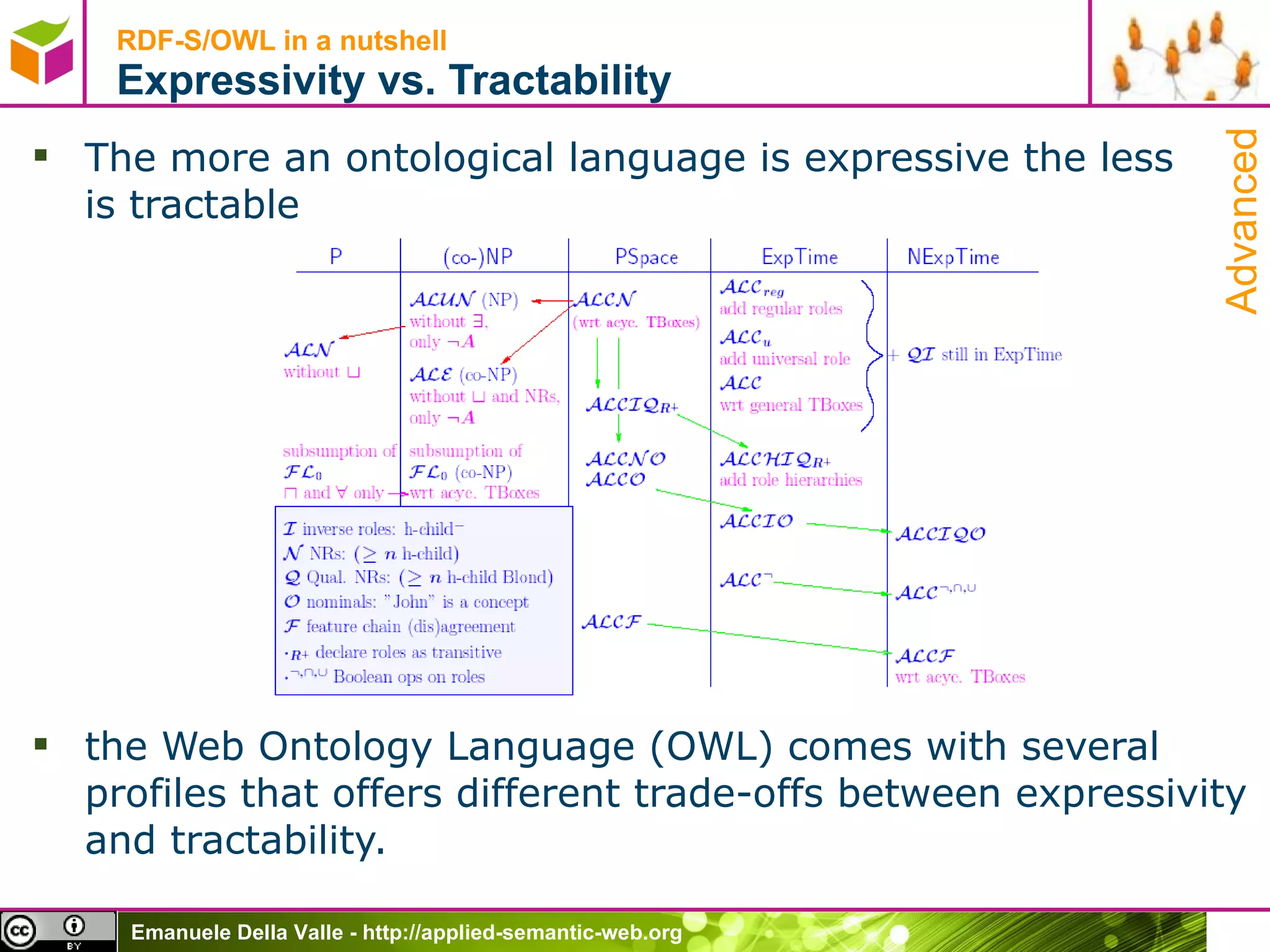
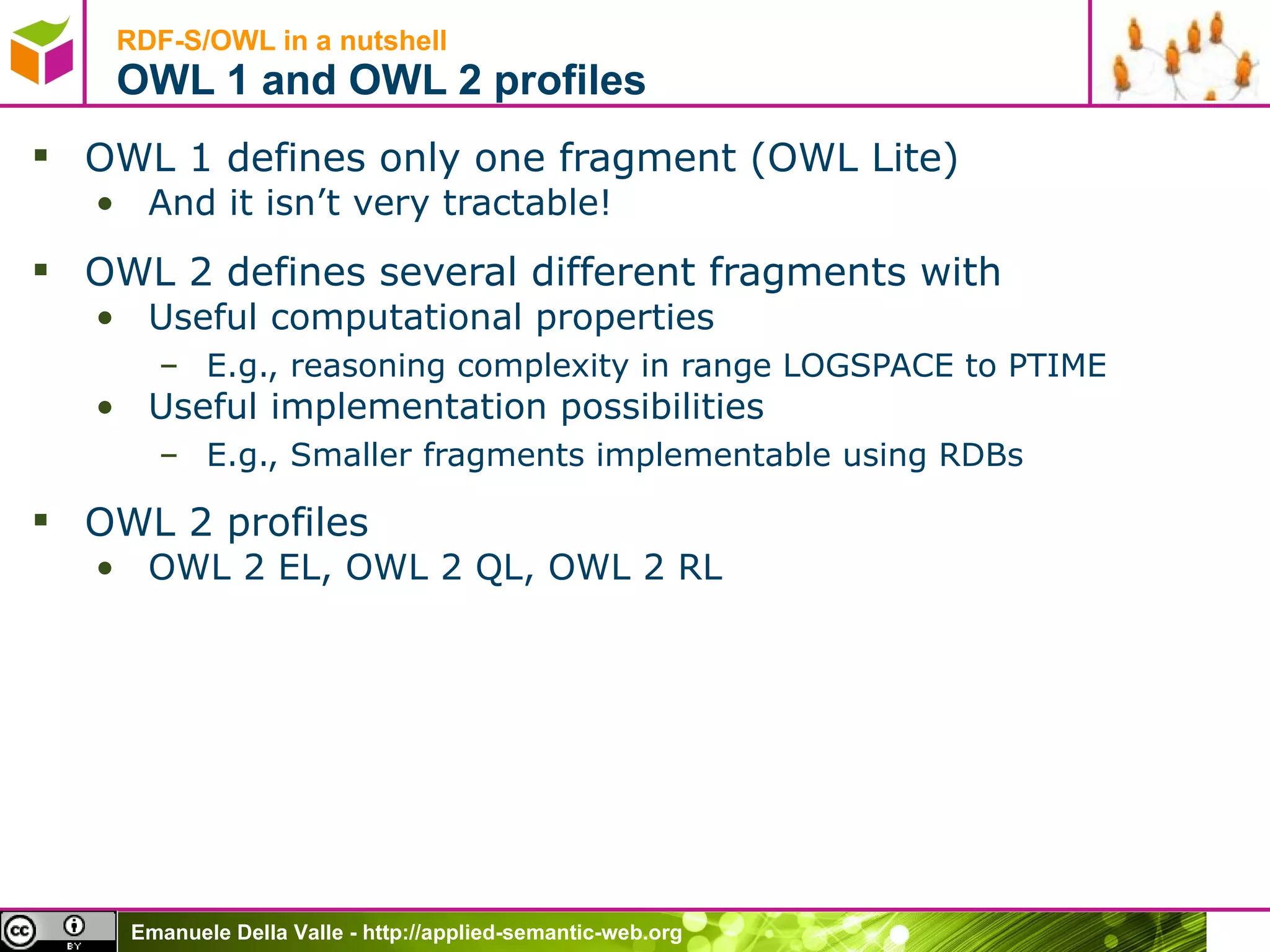
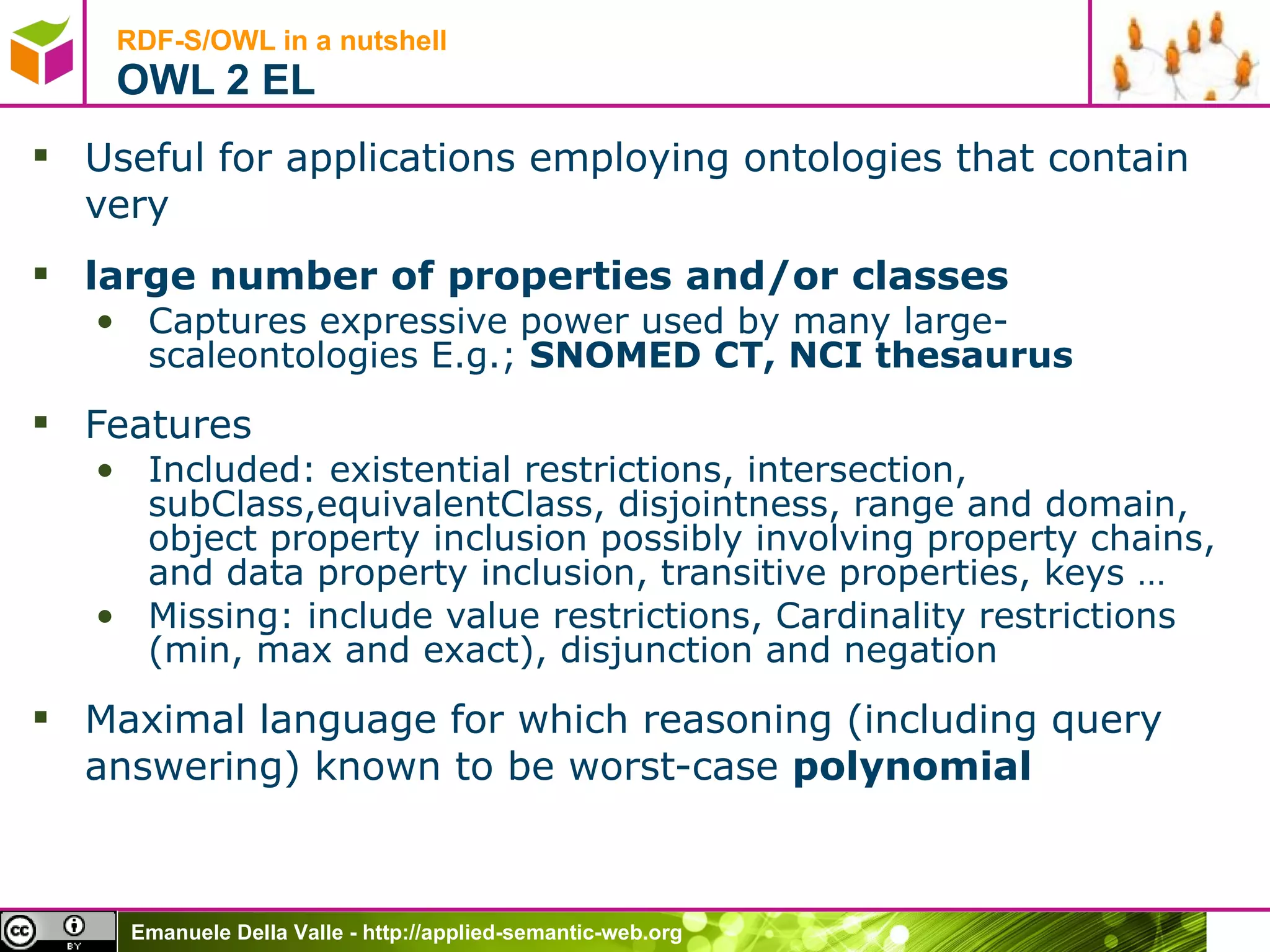

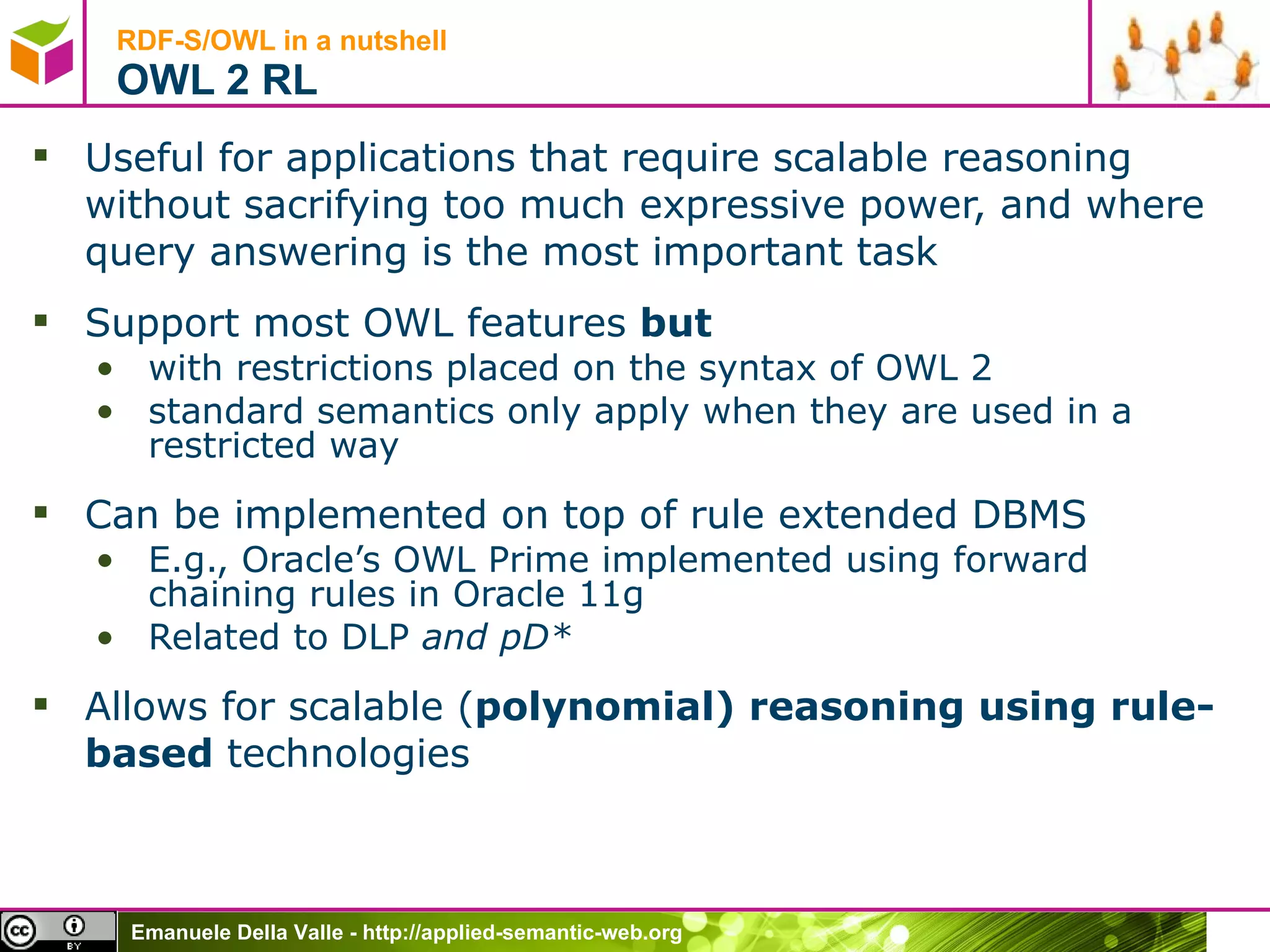
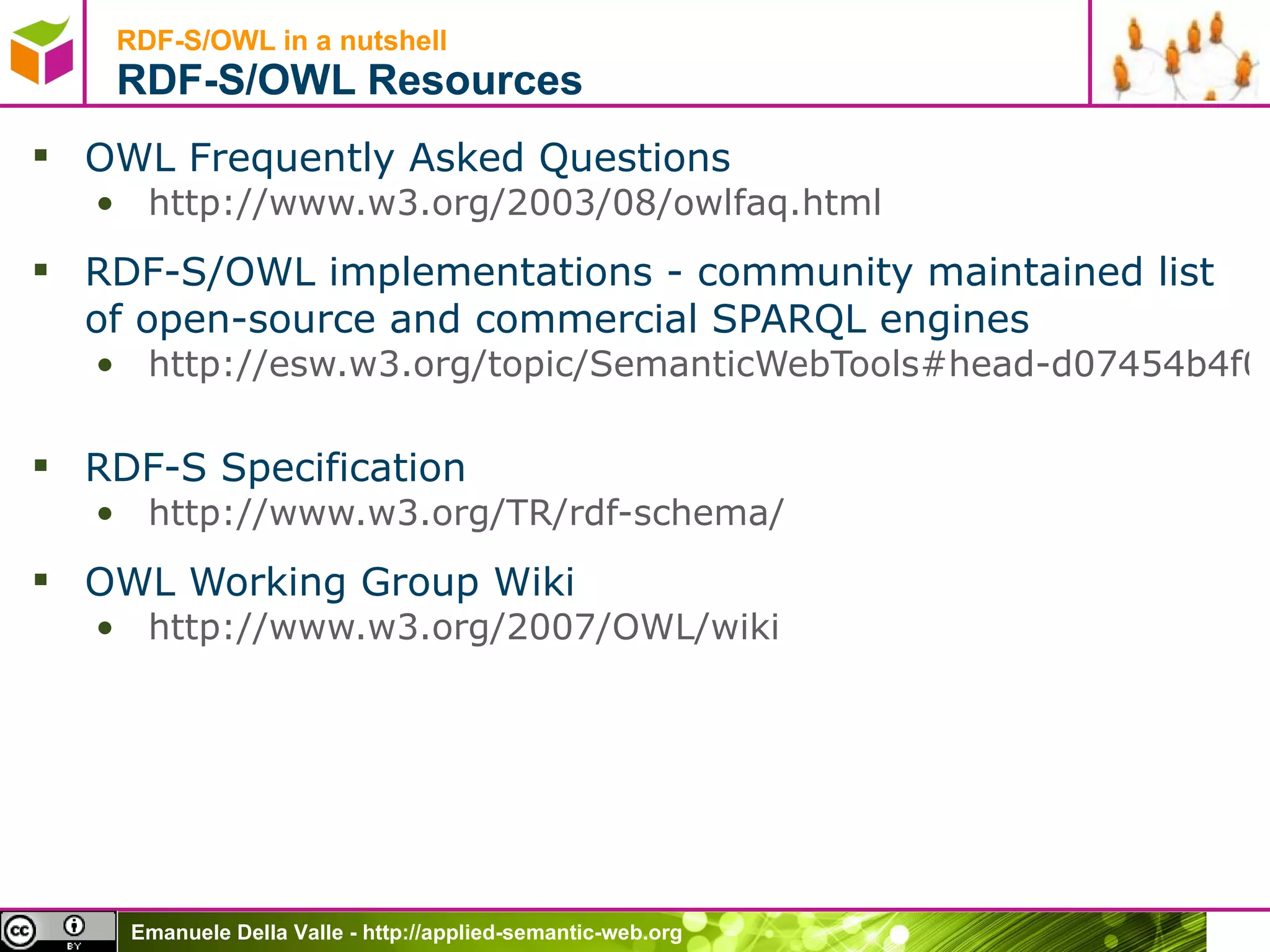
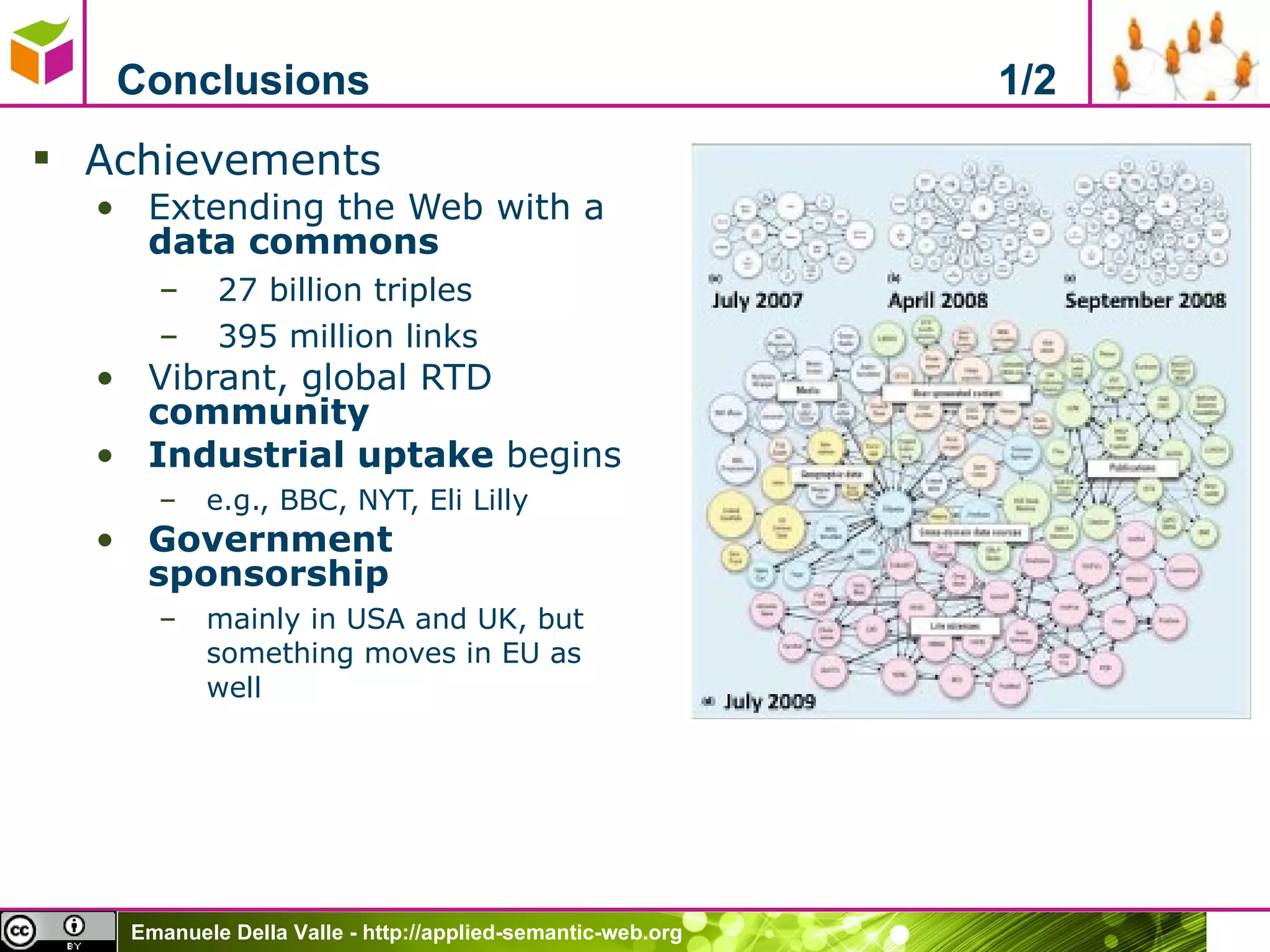
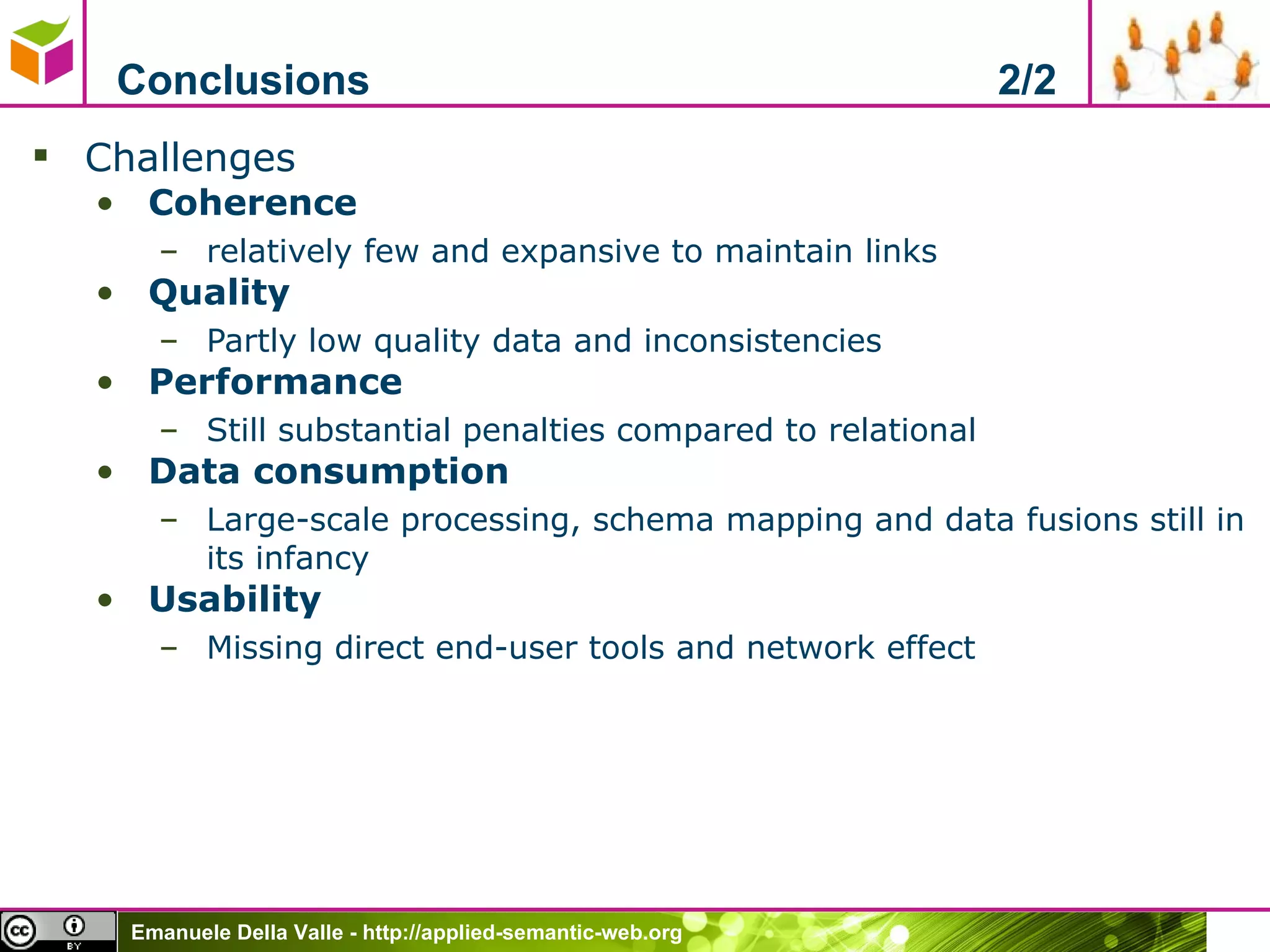
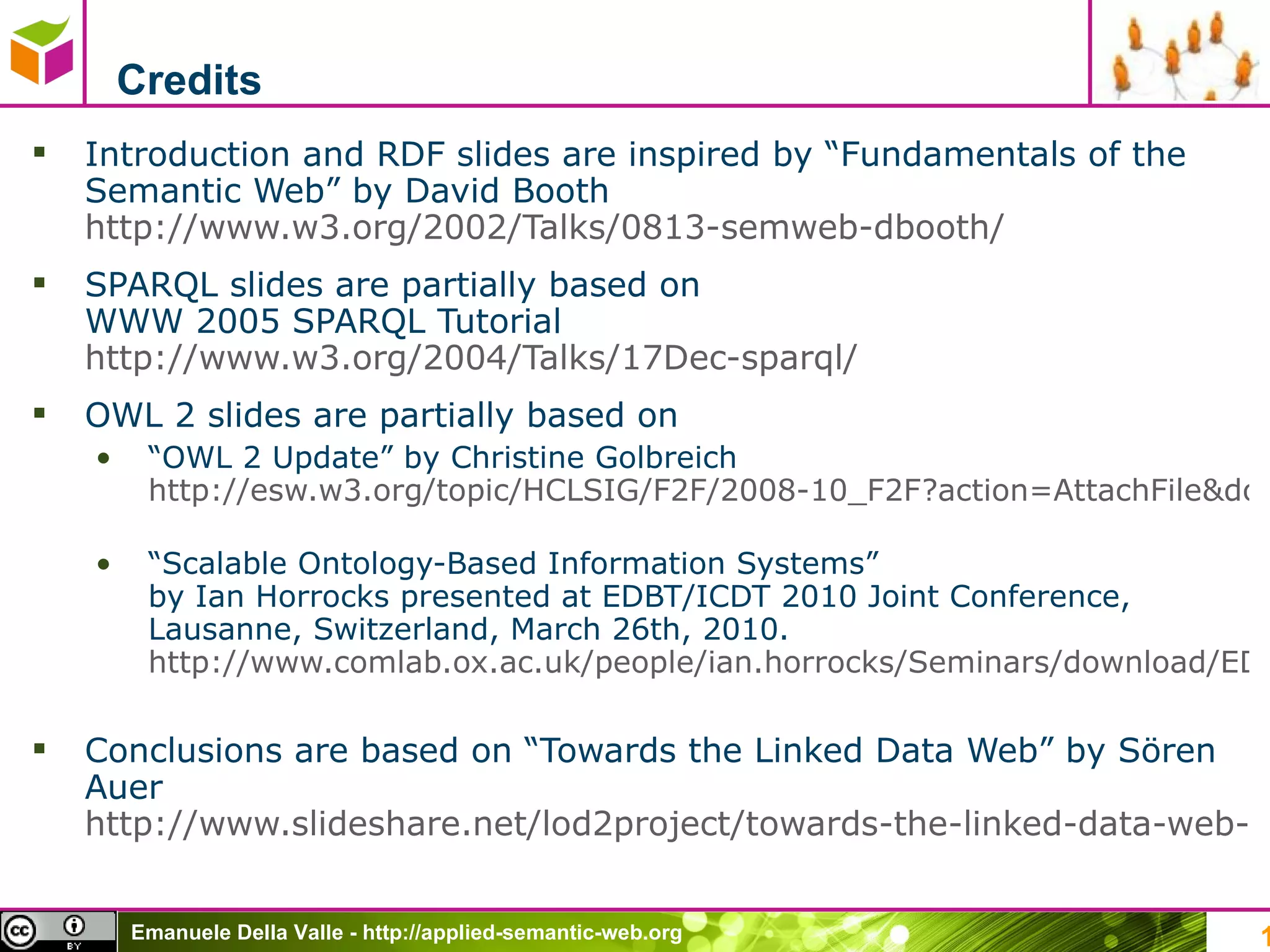
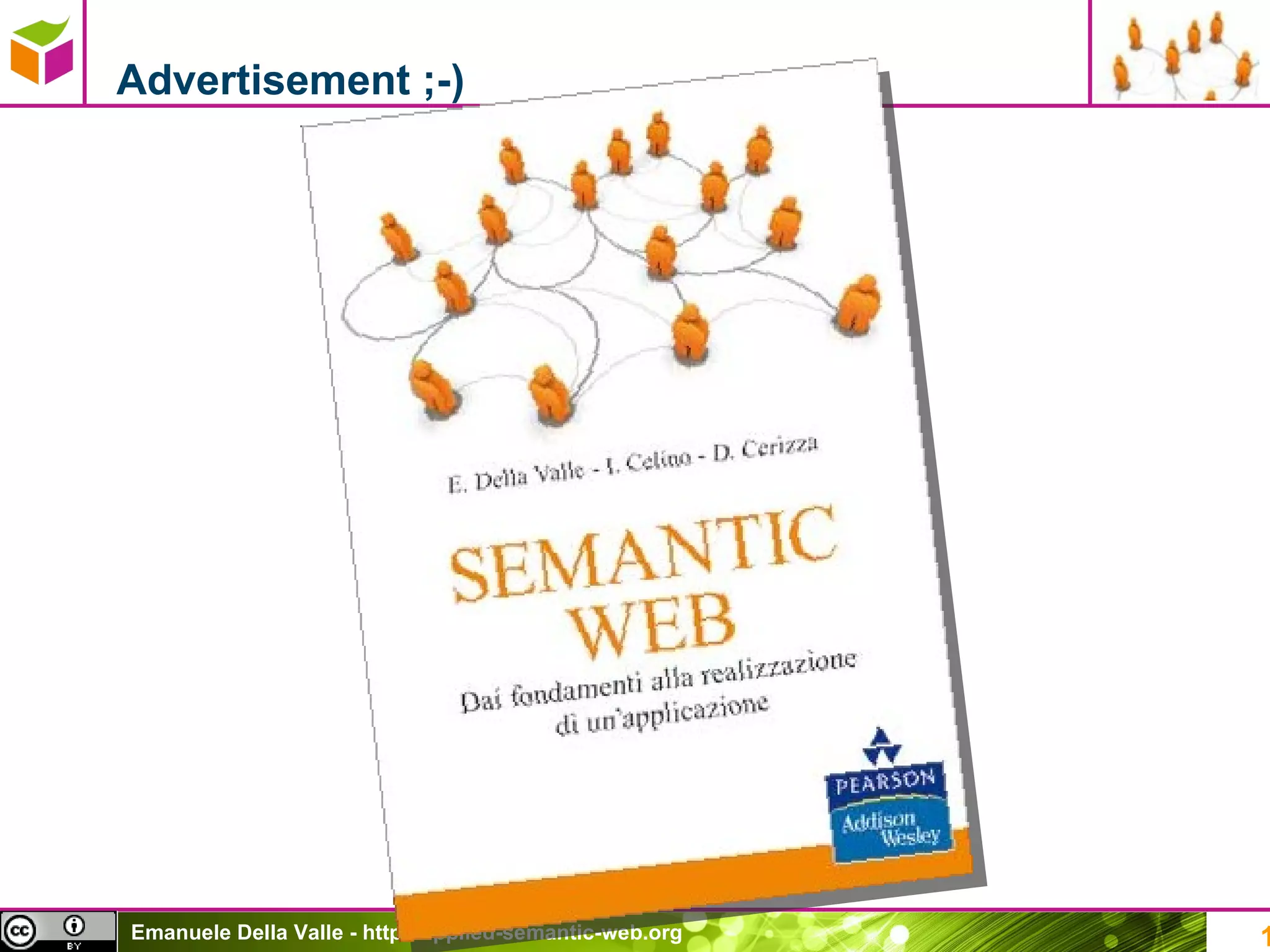
![Introduction to Semantic Web for GIS Practitioners 3.5.2011, Como Emanuele Della Valle [email_address] http://emanueledellavalle.org](https://image.slidesharecdn.com/semanticweb4gis-110504153905-phpapp02/75/Introduction-to-Semantic-Web-for-GIS-Practitioners-102-2048.jpg)